Tip's For The Beginner

Fishing Deep Water Covered Floating Docks
Written By Rick McFerrin
Full Time Guide/Owner
Tennessee Bass Guides LLC.
August 2007
www.tennesseebassguides.com
This article is intended to help the Beginning
Fisherman better understand the makeup of deep water (15 ft or more)
covered floating docks and what techniques work best for me during the hot
weather months when water temperatures reach the 80's and above. Let
me say that this is not the only way to catch bass out from
under and around docks. But the techniques that I will be sharing fits
my fishing style perfectly and has proven over the years to be very
effective. There are several other articles aimed at the Beginner
that you can view by going to
www.tennesseebassguides.com and clicking on the Tips Archive Tab on the
left hand side of the home page.
Before We Catch A Bass
Before we catch a bass we need to cover this first. It
is always important to remember that the dock and everything either sitting
on it or attached to it is someone's private property and should be treated
as such. I have never had a dock owner run me off in all the years I have
been fishing them. Why? Because I respect the other persons property and
their privacy if they are on the dock. But I have witnessed others being
asked to leave the dock area because of not using their heads and doing
something stupid! The water is public but the docks are private!
Why Deep Water Covered Docks?
Truthfully this question could be why covered docks period!
The answer is very simple, boat docks offer Smallmouth, Largemouth and Spots
several important things that attract them such as.
(1) Natural Forage: Many docks will support a variety
of small bait fish, blue gill and other smaller species of fish and
sometimes crawfish that bass just love to munch on. To a bass some
docks are like going to an all you can eat restaurant. The key is to find
those particular docks, which we will talk about later. It's also important
to remember that Older Docks will have a tendency to have more algae
on the areas below water level, simply because they have been in the water
longer. Why is this important? Because the algae is one component that helps
create oxygen and attracts the smaller species that I just mentioned.
Bait fish, Blue gill and others will feed on the algae and small aquatic
bugs and set up a homestead under the dock, which in turn attracts lager
predator fish.
Many States here in the U.S. have changed their construction
codes to where any type of real wood cannot be used in the building of docks
for environmental and safety reasons. Wood has been replaced by man made
synthetics which take a little longer to build up a algae covering depending
on lake water clarity and purity. To help you find docks that
potentially will have more of this algae buildup look for older docks that
still have the wood construction, boats moored at them and jet sky platforms
which have visible algae buildup on the areas below water level. Let me
stress that Algae Alone is not the only factor that makes a good
producing dock. But it certainly gets one started out in the right
direction.
(2) Shade: I don't know where you live, but here in
middle Tennessee it's HOT! Daytime temperatures have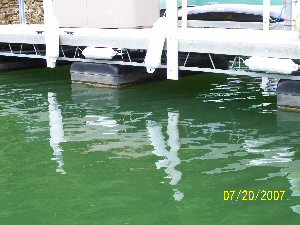 consistently hovered in the mid to upper 90's and this week we will break
the 100 degree mark several days. The suns beating down, we have mile high
sky's and once again it's just plain old HOT! When I take my dogs
outside to do their business where do you think I stand? If you
guessed under a shade tree you would be absolutely correct! It may still be
hot "But" it is several degrees "Cooler" than just standing
out in the direct sunlight. The same principle applies to docks. Look
at the picture here to the right. This picture was taken on a bright sunny
day last month. Look at the shaded areas under the dock. To a bass it's like
walking his favorite shad out in the yard letting him swim around while he
gets under a shade tree. It may still be hot but the water temperature under
the dock can range as much as 8-10 degrees cooler (sometimes more) depending
on the density and square footage of the dock. Some of the docks I
fish on my favorite lake are 600 square feet and larger. Some are one story
tall and other two stories tall. The larger square footage of the dock
the greater the shade.
consistently hovered in the mid to upper 90's and this week we will break
the 100 degree mark several days. The suns beating down, we have mile high
sky's and once again it's just plain old HOT! When I take my dogs
outside to do their business where do you think I stand? If you
guessed under a shade tree you would be absolutely correct! It may still be
hot "But" it is several degrees "Cooler" than just standing
out in the direct sunlight. The same principle applies to docks. Look
at the picture here to the right. This picture was taken on a bright sunny
day last month. Look at the shaded areas under the dock. To a bass it's like
walking his favorite shad out in the yard letting him swim around while he
gets under a shade tree. It may still be hot but the water temperature under
the dock can range as much as 8-10 degrees cooler (sometimes more) depending
on the density and square footage of the dock. Some of the docks I
fish on my favorite lake are 600 square feet and larger. Some are one story
tall and other two stories tall. The larger square footage of the dock
the greater the shade.
Without getting to technical you have to remember that all
fish including bass "breathe" by absorbing dissolved oxygen through
their gills. Oxygen enters the water in several different ways such as,
directly from the atmosphere, absorption directly from aquatic plants and
algae photosynthesis. The cooler the water under the dock the more oxygen
can be dissolved in the water. That's why under normal conditions oxygen
levels are usually higher in the winter than the summer. Shade
provided by docks tend to lower the average summer water temperature and
increase the oxygen levels.
(3) Accessibility to deep water: Even though
bass are predators they still want a sense of safety. The docks I
concentrate on during hot weather sit in water anywhere from 15 feet
to 35 feet deep. One big advantage to the deeper water (verses shallow
water) is bass on these docks tend to move up and down in the water column
instead of out and away from the dock when frightened or reacting to weather
changes. Another factor that help hold bass is submerged timber and other
structure under the dock. Many dock owner have sunk brush and PVC trees as
fish attractors which just adds another plus to that particular dock.
Any time you see lights and rod holders on a dock always probe around and
chances are you will find some type of structure that has been planted. When
bass are moving up and down in the water column and they aren't as
aggressive you have to experiment with your presentation. Size/weights of
lures, rate of fall of your lures and even the type of lures that they want
can change from trip to trip. We will discuss this in a minute.
To me these three things are very important when fishing this
time of the year. Dog days of summer drive many bass fisherman in one of two
directions. The first would be to their recliners and air conditioning
awaiting cooler temperatures or to the lake at night. "BOTH" of these have
their own distinct advantages for sure. But I can tell you that you can
catch good quality fish during the day from the right docks on your lake. It
just takes a little trail and error, effort and practice mixed with a whole
lot of patience. But when you find those key docks the fish will
consistently be there.
What Areas Of The Dock Do I Fish?
It would be very simple for me to say "All Of The Areas" and
I would be telling you the truth. However that won't help you and that is
what this article is all about. Helping the beginner learn new techniques
and short that learning curve a bit. I'm going to show you several
pictures in this section and try to help you see the great potential that
docks have. So lets get started.
The pictur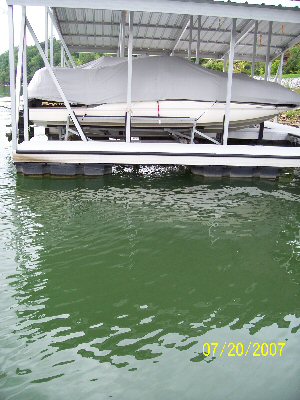 e
to the left is a side view of this dock. The key areas to
e
to the left is a side view of this dock. The key areas to
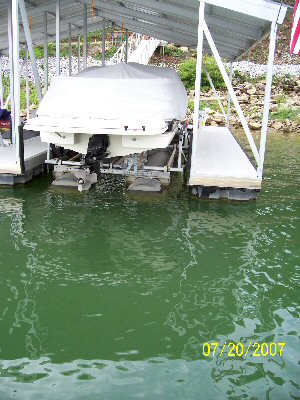 concentrate
on are the right and left hand corners of the dock and the shaded open areas
between the floatation blocks. If you will notice that the height of the
dock roof and the height of the boat is casting a shaded area toward you.
This will be the angle that provides the most shade. If the bass are active
it is not unusual for them to chase the bait out several feet into this
shaded area. You will want to "skip" your bait into these open areas
between the floatation as far back under the dock as possible. You corner
cast should be several feet past the corners to allow you to work the bait
correctly. The picture to the right is a portion of a different dock. The
key areas would be the entire length of the right side of the dock, the
right hand corner and all of the water under the boat lift including the
left and right corners of the slip opening. Once again it is very important
to skip the bait as far as possible under the boat and the make your right
side cast as close as possible to the dock.
concentrate
on are the right and left hand corners of the dock and the shaded open areas
between the floatation blocks. If you will notice that the height of the
dock roof and the height of the boat is casting a shaded area toward you.
This will be the angle that provides the most shade. If the bass are active
it is not unusual for them to chase the bait out several feet into this
shaded area. You will want to "skip" your bait into these open areas
between the floatation as far back under the dock as possible. You corner
cast should be several feet past the corners to allow you to work the bait
correctly. The picture to the right is a portion of a different dock. The
key areas would be the entire length of the right side of the dock, the
right hand corner and all of the water under the boat lift including the
left and right corners of the slip opening. Once again it is very important
to skip the bait as far as possible under the boat and the make your right
side cast as close as possible to the dock.
The picture to th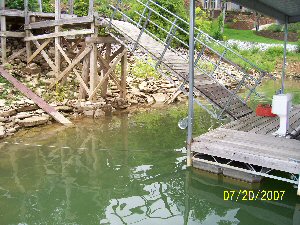 e
left is the back left hand corner of this dock which is
e
left is the back left hand corner of this dock which is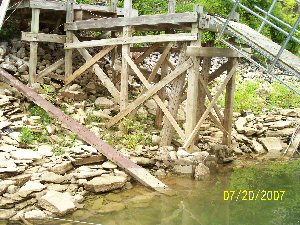 nearest the bank. They key areas are the open portion between the
floatation (hidden behind the 2007 date) the back corner, the length of the
back side and the entire area between the bank and the dock. If you
will notice in the picture to the right that this lake is very low this
summer due to the drought that we are experiencing. All the wood decking you
see would normally be in the water at this time of the year. This is a
"MUST FISH" area when the water is up. The best way that I have
found is to position by boat against the cable that is running from the
corner of the dock to the bank and actually fish over the cable pitching and
skipping my lures into and around as much of the wood as possible. I
will work one side of the structure at a time. When I reach the other side I
will fish the other side. Another thing to notice in these pictures is the
walkway from the dock to the shore. This will also provide shade to one
degree or the other and that shade will increase the closer you get to the
dock. I have caught and lost some "big" fish in this type of areas.
nearest the bank. They key areas are the open portion between the
floatation (hidden behind the 2007 date) the back corner, the length of the
back side and the entire area between the bank and the dock. If you
will notice in the picture to the right that this lake is very low this
summer due to the drought that we are experiencing. All the wood decking you
see would normally be in the water at this time of the year. This is a
"MUST FISH" area when the water is up. The best way that I have
found is to position by boat against the cable that is running from the
corner of the dock to the bank and actually fish over the cable pitching and
skipping my lures into and around as much of the wood as possible. I
will work one side of the structure at a time. When I reach the other side I
will fish the other side. Another thing to notice in these pictures is the
walkway from the dock to the shore. This will also provide shade to one
degree or the other and that shade will increase the closer you get to the
dock. I have caught and lost some "big" fish in this type of areas.
The picture on the le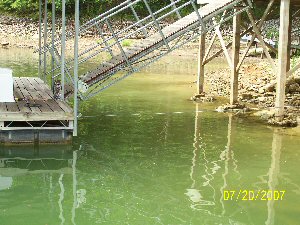 ft
is a different dock looking at it from from the opposite side
ft
is a different dock looking at it from from the opposite side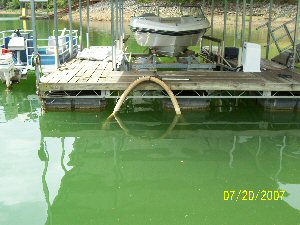 from the ones above. The key areas remain the same. Opening floatation
areas, back corner, entire length of back side and the open area between the
dock and the shore. The picture on the right of another entire side view
which affords us some additional opportunities. The key area here would be
the right and left hand corners of the dock, the open areas between the
flotation, the white PVC hose pipe hanging down and the back of the pontoon
boat parked in front of the dock. Once again it is important to get you bait
as far under the dock as possible.
from the ones above. The key areas remain the same. Opening floatation
areas, back corner, entire length of back side and the open area between the
dock and the shore. The picture on the right of another entire side view
which affords us some additional opportunities. The key area here would be
the right and left hand corners of the dock, the open areas between the
flotation, the white PVC hose pipe hanging down and the back of the pontoon
boat parked in front of the dock. Once again it is important to get you bait
as far under the dock as possible.
The pic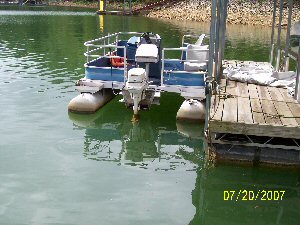 true
to the left is a close up of the one above right. You can see the
true
to the left is a close up of the one above right. You can see the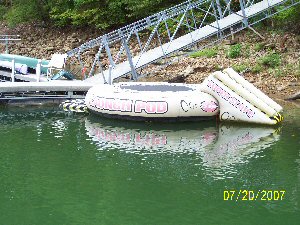 additional shade the exists under the pontoon boat. The picture on the right
gives us some different opportunities. Not only do we have the opening
between the dock floatation and the area between the dock and bank but the
big float tube and slide as well. Have you noticed something different about
this dock? Yes? No? Take a closer look-the dock isn't covered. It has been
my experience that this type of dock will produce less during this time of
the year than a covered dock, but big shaded areas like the one under the
tube should be checked out. Just please don't stick the tube...remember our
dock owner conversation?
additional shade the exists under the pontoon boat. The picture on the right
gives us some different opportunities. Not only do we have the opening
between the dock floatation and the area between the dock and bank but the
big float tube and slide as well. Have you noticed something different about
this dock? Yes? No? Take a closer look-the dock isn't covered. It has been
my experience that this type of dock will produce less during this time of
the year than a covered dock, but big shaded areas like the one under the
tube should be checked out. Just please don't stick the tube...remember our
dock owner conversation?
These two picture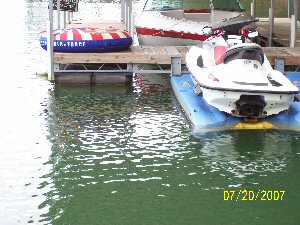 s
are of the same covered dock and gives us even
s
are of the same covered dock and gives us even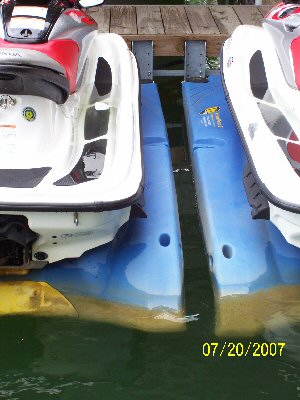 more possibilities. This covered dock has jet ski platforms attached in two
different areas of the dock. So we have the corner of the dock, the entire
length of the front of the dock, the open flotation area, the side and
corners of the jet ski platform and the crack between them. Don't ever
discount the crack between the platform. I have caught a lot of good fish
that was suspended directly under them. We also have the back side of the
dock which is not visible to us in this picture.
more possibilities. This covered dock has jet ski platforms attached in two
different areas of the dock. So we have the corner of the dock, the entire
length of the front of the dock, the open flotation area, the side and
corners of the jet ski platform and the crack between them. Don't ever
discount the crack between the platform. I have caught a lot of good fish
that was suspended directly under them. We also have the back side of the
dock which is not visible to us in this picture.
These are the key areas that I concentrate on when fishing
deep water covered docks during the hot weather months. With a little bit of
a learning curve these will work for you as well.
What Do I Fish With?
Now that you have a better idea on what areas of docks to key
in on, lets explore each individual part of the what do I fish with piece.
I want to preface again that there are several baits and techniques that you
can use. BUT for day in and day out consistency fishing docks this time of
year what I'm going to share with you works for me over and over again year
after year.
Go To Baits
There are several reason that my #1 go to bait for fishing
docks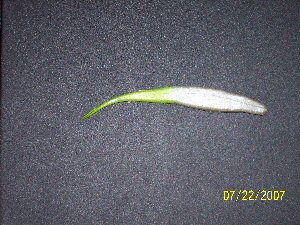 is a 5 inch Prowler Soft S
is a 5 inch Prowler Soft S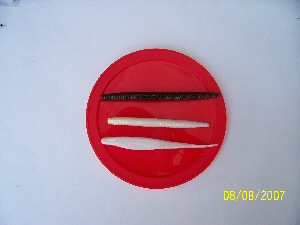 had
www.prowlerlures.com like the one
in the picture to the left and the bottom bait in the right hand picture. My
#1 color choice is pearl as shown on the right, then I dip the tail of the
Soft Shad (and all pearl or white baits) in a chartreuse dye made by JJ's
Magic. (I'll cover dyes in a minute) This bait is about as versatile as a
bait can get. It can be fished in all level of the water column, it can be
fished weightless-weighed-exposed hook-Texas rigged-Wacky rigged-fished on
top or on the bottom with a Carolina rig and as a spinner bait trailer.
The action of the bait once you get use to using it mimics that of a dying
shad as it darts, vibrates and slowly falls when rigged weightless. There's
just something about the Soft Shad year around that Smallmouth, Largemouth
and Spots just can't resist when you pitch it under the docks like we talked
about above. I also catch a lot of fish on the Prowler Slim Jim in
either a pearl or watermelon red flake. These baits are heavier and fall at
a much quicker rate. I skip these baits under the dock just like the Soft
Shad but I tend to let them sink on their own for several seconds and use my
rod to twitch them more than make them dart like the Soft Shad. Folks I
can't emphasize enough how good these Soft Shads and Slim Jims are in
producing quality fish. If you haven't tried these Prowler baits you are
sure cutting yourself short.
had
www.prowlerlures.com like the one
in the picture to the left and the bottom bait in the right hand picture. My
#1 color choice is pearl as shown on the right, then I dip the tail of the
Soft Shad (and all pearl or white baits) in a chartreuse dye made by JJ's
Magic. (I'll cover dyes in a minute) This bait is about as versatile as a
bait can get. It can be fished in all level of the water column, it can be
fished weightless-weighed-exposed hook-Texas rigged-Wacky rigged-fished on
top or on the bottom with a Carolina rig and as a spinner bait trailer.
The action of the bait once you get use to using it mimics that of a dying
shad as it darts, vibrates and slowly falls when rigged weightless. There's
just something about the Soft Shad year around that Smallmouth, Largemouth
and Spots just can't resist when you pitch it under the docks like we talked
about above. I also catch a lot of fish on the Prowler Slim Jim in
either a pearl or watermelon red flake. These baits are heavier and fall at
a much quicker rate. I skip these baits under the dock just like the Soft
Shad but I tend to let them sink on their own for several seconds and use my
rod to twitch them more than make them dart like the Soft Shad. Folks I
can't emphasize enough how good these Soft Shads and Slim Jims are in
producing quality fish. If you haven't tried these Prowler baits you are
sure cutting yourself short.
What About Using Dyes?
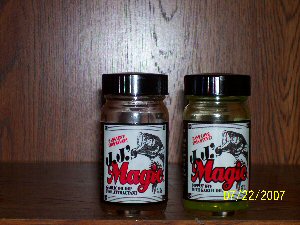
About 3 years ago I was introduced to JJ's Magic and man am I
ever glad that I was. I use JJ's on everything except under my arms and on
my toothbrush. This dye comes in Chartreuse, Blue, and Myth lade. And there
is also a Clear that will not change the color of your baits but still
leaves that heavy garlic scent that just won't come off cast after cast.
Soft Plastics, Spinner Bait Skirt, Swim Baits and Jigs. This product is
phenomenal for giving you that extra several seconds to set the hook because
the fish just don't want to let go of the bait. I like to dip the Soft
Shads tail in the Chartreuse (let it dry) then dip the whole body in the
clear. You will NOT find me on the lake without JJ's on my
baits....end of subject. www.jjsmagic.com
What About Hooks And Line?
I have to admit that the older I get I get a little more
cranky and much more particular about everything I fish with from
rods-reels-line-hooks-snaps-baits-dyes you name it. It absolutely drives me
n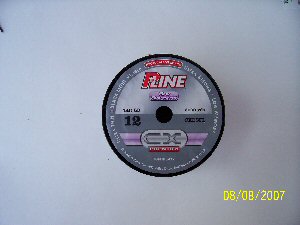 ut's
to have "Product Failure" due to manufacturing error. Where am I going with
this? I have been a avid user of Pline for the past several years. On a
early spring trip with my youngest son Daniel to Louisiana a rep gave me
some line made by another big name manufacturer ands asked me just to try
it. To make a long story short after breaking off 3 "GOOOD" fish in the
cypress trees I respooled immediately back to what I should have had on in
the first place Pline CX. Problem solved! Is Pline infallible? NO, but I
will tell you this, as long as I watch what I'm doing and check my line as I
should I have almost "ZERO" problems with Pline. I use it in different pound
test for every technique that I use. I like the 12lb test CX Florescent for
fishing docks because it is invisible under the water but highly visible
above so you can watch your line for those very subtle hits that happens
many times fishing docks. It comes off the reel very smoothly and has a very
low memory rating but yet is very strong. Just good stuff.
www.pline.com
ut's
to have "Product Failure" due to manufacturing error. Where am I going with
this? I have been a avid user of Pline for the past several years. On a
early spring trip with my youngest son Daniel to Louisiana a rep gave me
some line made by another big name manufacturer ands asked me just to try
it. To make a long story short after breaking off 3 "GOOOD" fish in the
cypress trees I respooled immediately back to what I should have had on in
the first place Pline CX. Problem solved! Is Pline infallible? NO, but I
will tell you this, as long as I watch what I'm doing and check my line as I
should I have almost "ZERO" problems with Pline. I use it in different pound
test for every technique that I use. I like the 12lb test CX Florescent for
fishing docks because it is invisible under the water but highly visible
above so you can watch your line for those very subtle hits that happens
many times fishing docks. It comes off the reel very smoothly and has a very
low memory rating but yet is very strong. Just good stuff.
www.pline.com
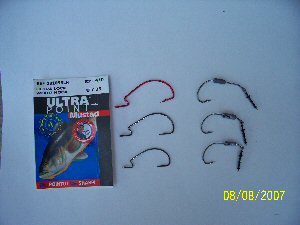 Lets talk about hooks for a
minute. There is an old saying that go's the chain is only as strong
as the weakest link. Same is true with the fishing equipment we use. I guess
I have bought about every brand hook manufactured. Some have been good some
haven't. The biggest problem that I have isn't the strength of a hook as
much as having a razor sharp point that will stay that way. I started using
Mustad Ultra Point hooks about 8 months ago and I can tell you that I'm
impressed/ These hooks are needle sharp. Mustad uses a new technology that
is called "Opti-Angle" that creates a true needle point that is stronger and
"Much More" durable than any other hooks that I have used. Under
normal conditions I use a #5 Mustad Wide Gap Ultra Lock Hook fishing the
Soft Shad. I also use a #4 and a #2 for smaller baits. Now there are times
while fishing docks I want my baits to fall a little faster "But" I don't
want to make them nose dive by adding a sinker to the front. When this
happens I use the Mustad Ultra Point Power Lock Plus Hooks that you see on
the right side of the picture above. The round piece that you see on the
shank of the hook is a weight that slides up and down the hook but
will stay put where you want it. I use these in 2 different weights 1/8oz
and 1/16oz depending on how fast I want the bait to fall. If I move
the weight forward the bait fall head first. If I move the weight to the
back the bait falls tail first and if I place it in the middle the bait will
fall at more of a level angle. This allows me to effectively fish the
docks using the right size bait at the right of fall.
www.mustad.no
Lets talk about hooks for a
minute. There is an old saying that go's the chain is only as strong
as the weakest link. Same is true with the fishing equipment we use. I guess
I have bought about every brand hook manufactured. Some have been good some
haven't. The biggest problem that I have isn't the strength of a hook as
much as having a razor sharp point that will stay that way. I started using
Mustad Ultra Point hooks about 8 months ago and I can tell you that I'm
impressed/ These hooks are needle sharp. Mustad uses a new technology that
is called "Opti-Angle" that creates a true needle point that is stronger and
"Much More" durable than any other hooks that I have used. Under
normal conditions I use a #5 Mustad Wide Gap Ultra Lock Hook fishing the
Soft Shad. I also use a #4 and a #2 for smaller baits. Now there are times
while fishing docks I want my baits to fall a little faster "But" I don't
want to make them nose dive by adding a sinker to the front. When this
happens I use the Mustad Ultra Point Power Lock Plus Hooks that you see on
the right side of the picture above. The round piece that you see on the
shank of the hook is a weight that slides up and down the hook but
will stay put where you want it. I use these in 2 different weights 1/8oz
and 1/16oz depending on how fast I want the bait to fall. If I move
the weight forward the bait fall head first. If I move the weight to the
back the bait falls tail first and if I place it in the middle the bait will
fall at more of a level angle. This allows me to effectively fish the
docks using the right size bait at the right of fall.
www.mustad.no
What About Rods And Reels?
Let's start with reels first. I have been a Shimano fan
for years. I use 2 different size Stradics on my spinning rods.
St4000FH for 10 & 12 lb test line and the ST2500FH for 6 & 8lb test. Why?
They hold up like no other reels I have ever used, and when you fish as many
days a year with as many people that I do you come to appreciate the quality
that is built into these reels.
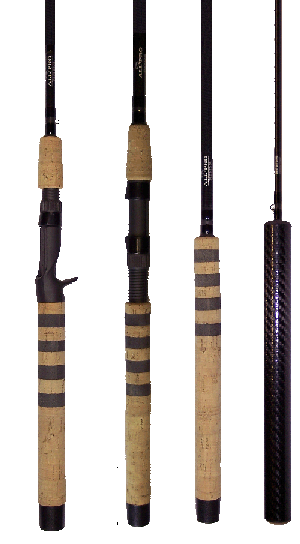
For those of you that know me I'm sure that I sound like a
broken record. But I will tell you this, that the rod physical weight,
quality, power and sensitivity that is packed into the All Pro APX Series
Rods is unbelievable. I have owned at one time or the other just about every
high end bass rod that has been made and I can tell you that the APX has
them all beat hands down in my opinion. I have used these rods to Bass,
Salmon, Musky, Northern Pike, Rock Fish, Hybrid, Walleye, Catfish (you name
it) fish. I have used the 5 foot Ultra Light APX on all varieties of
pan fish. I use the 7 foot Medium Heavy Tennessee Graphite Handle Spinning
Rod to throw my Soft Shads around cover and docks. I have one APX that has
never been used for anything else except to fish soft plastic jerk baits.
The sensitivity is astonishing. You can feel the "slightest tick" all
the way through your hand and wrist with the APX Series Rods. This is so
important when the fish are lethargic and they just "Grab" the bait and that
extra sensitivity make the difference between a hook up and a miss.
All Pro make a full line of APX Rods for every need.
www.allprorods.com
Conclusion
I hope that the information above will be beneficial to you,
and help you put several more fish in the boat fishing deep water covered
docks. If you have any questions concerning this article, our guide service
or web site don't hesitate to contact me at 615-765-7303 or
rickm@dtccom.net Thank you for
taking time to read this article. Rick Mcferrin Owner/Full Time Guide
Tennessee Bass Guides LLC
Crank Bait Tip's For The Beginner
By: Rick McFerrin

www.tennesseebassguides.com
Revised 2013
Introduction
Prior
to fishing full time I worked as a regional manager for a large food
manufacturer. As I traveled the Southeast, I would regularly drive by or fly
over many fantastic looking lakes, rivers and streams. Gazing out or looking
down at these bodies of water I must admit my mind would race back to being
a kid years ago sitting in school on those first warm spring days looking
out the nearest window. All I wanted to do was "Chuck" the books and just go
fishing. I couldn't wait to get home. I knew that my dad and I would
either head to the river to wade or go to some of the farm ponds that were
near by.
I
know I have shared this before, but my father introduced me to fishing a
crank bait in these rivers and ponds.
Back
then we didn't have the unlimited choices in crank baits like we do today.
Dad and I used lures named "River Runt" "Lazy Ike" "Mirr O Lure" "Cast
Master" "Sparkle Tail and several more. At an early age I became "Hooked"
on fishing a crank bait. Through the years I've heard crank baits called "Idiot
Lures" You know, you just chunk and wind. But nothing could be further
from the truth. Through the years things have changed dramatically.
Today's crank baits in the hands of a skilled crank bait fisherman is a
high tech tool that can add big numbers and quality to your fishing success.
I want to revisit some prior thoughts that I have shared about fishing a
crank bait, and do a little updating at the same time.
Where Does The
Beginner Start?
One
of our mission goals here at Tennessee Bass Guides is to be a good
information resource center for "Beginning Bass Fisherman". With that goal
in mind let's begin. When you go into many of our "Super Tackle Stores" you
are automatically confronted with aisle after aisle of crank bait
manufactures that produce baits in 100's of different colors and sizes. Most
of these baits today will range in price from $3.00 all the way to almost
$20.00. Some of these baits float, while others sink. Some rattle and some
don't. Some are made from balsa, some hard wood and the majority from a
plastic composite. Some crank baits because of their buoyancy rise quickly
when you stop cranking while others suspend or fall. Some baits have long
lips, some short and others no lip at all. Choosing the right bait and
getting the most for your money becomes a "mind boggling chore" for a
new crank bait fisherman. To get a good start you must do some home work
"Before" you step foot in that crank bait candy store. Here are a few
questions you need to answer first.
Where Are You
Going To Fish Most?
Why
is this important? It's simple, if you are going to wade creeks,
rivers or fish ponds from the bank you may need crank baits that run
shallower over all than let's say someone that fishes from a boat on deep
rivers and lakes. Your color selection may be similar (we will cover this
later) but your variety of deep running baits will most likely be limited.
If you are fishing small lakes or ponds from a boat, your selection will
increase because you will be able to fish the deeper portions of the lake
and most likely you will be casting in towards the shallows and bring the
bait back into deeper water. If the pond or lake that you are fishing has an
abundance of vegetation this will also factor into your lure selection. If
your fishing large deep lakes you may need baits that run from 1 foot to 20
plus. You just have to adjust accordingly. The possibilities are endless but
I think you get the idea. Gear your crank bait selection to where you are
going to fish the most. By doing this and "going slow" with your purchases,
you can see what will and won't work for you. In the long run you can save
money that can be used on other equipment needs.
Colors!
"I Wish I
Hadn't Bought That"
Why
would I say "I wish I Hadn't Bought That"? If you were here at my house I
would gladly show you why! Down stairs in the garage I have a cork board
that has well over a 100 crank baits stuck to it that I never use that I
have bought over the past 50 years. Some
never ran correctly, others didn't have the action that I wanted. And others
are the result of "It Looked Good To Me" when I was at the store but it
never looked good to the bass I was trying to catch. Through the years and
several wasted $$$$$$.
I
have settled on some very basic colors that will produce for the beginner
over and over, year after year. How do I know that? Because they work
for me. If you will start with these and gain confidence in your crank bait
fishing you will then have a better comfort level in your next color
selections.
Before I go any further, I need to say that we are proud to be sponsored by
one of the largest Crank Bait manufacturers in the world, Normark. Normark
brands include legends like, Rapala-Storm and Lure Jensen on the crank bait
side. These brands offer a rainbow of colors including the ones we are going
to discuss next. Through out the year I will be writing a series of articles
addressing these brands and the various crank baits Normark manufactures.
 From
my experience these are your "basic must have": colors. (1)
Silver/Shad (2) Firetiger (3) Chartreuse or Parrot (4) Dark Brown Crawfish
(5) Bleeding Olive Shad (6) Sliver Black Back (7) Red/Red
From
my experience these are your "basic must have": colors. (1)
Silver/Shad (2) Firetiger (3) Chartreuse or Parrot (4) Dark Brown Crawfish
(5) Bleeding Olive Shad (6) Sliver Black Back (7) Red/Red Crawfish. Will other colors catch fish? Yes! But once again, these colors
have proven themselves to be producers over and over again. These colors
will also cover different water colors that you will be faced with. As I
said, take it slow in your purchases and gain confidence in what your
throwing. Then you can branch out a little further.
Crawfish. Will other colors catch fish? Yes! But once again, these colors
have proven themselves to be producers over and over again. These colors
will also cover different water colors that you will be faced with. As I
said, take it slow in your purchases and gain confidence in what your
throwing. Then you can branch out a little further.
What Depth Should
My Crank Bait Run
And How Fast
Should It Run?
Under
most circumstances I prefer to use a crank bait to search out cover and
structure always looking for that reaction bite. A crank bait is my
"confidence" bait. There are times when you can't crank fast enough. I
always like to keep my crank baits moving at a pretty good clip especially
in clearer water. I don't want the fish to get a real good look at it, as I
said I'm looking for the reaction bite. Then there are times when conditions
warrant me easing the bait through and around structure. To do this I
always select a crank bait that will run deeper than the depth of water that
I'm fishing. If I'm in 6 feet of water I want a crank bait that will reach
the 10 foot level. If I'm fishing 10 feet of water I want a crank bait that
will run 12 to 15 feet deep. The reason for this is simple. I want to
be able to keep in contact with the structure that I'm fishing. I want the
bait bouncing off as much structure as possible. Let me clear something up.
If your afraid to throw crank baits into heavy cover because you may get
hung up, you might as well stay at the house or take up another sport.
Besides that's what a good lure retriever is for, to get you free from where
the bass live. As you progress in your crank bait fishing you will be able
to fish them in many areas that you wouldn't think possible.
 The
one exception to having a crank bait that runs deeper that the water I'm
fishing is when I'm fishing
The
one exception to having a crank bait that runs deeper that the water I'm
fishing is when I'm fishing grass. This is where I select a bait that will touch the top of the weeds
and has the ability to pull through when I jerk or snap the rod forward.
Many times in grass when you are using a lipless crank bait like the Lure
Jensen Sugar Shad the bass will hammer the bait almost immediately when
it comes free from the weeds. Two other great crank baits for fishing weeds
and grass is the Rapala #5 Shallow Shad Rap and the Storm Sub Wart.
These baits run very shallow and produce for me year after year.
grass. This is where I select a bait that will touch the top of the weeds
and has the ability to pull through when I jerk or snap the rod forward.
Many times in grass when you are using a lipless crank bait like the Lure
Jensen Sugar Shad the bass will hammer the bait almost immediately when
it comes free from the weeds. Two other great crank baits for fishing weeds
and grass is the Rapala #5 Shallow Shad Rap and the Storm Sub Wart.
These baits run very shallow and produce for me year after year.
 Most
crank bait manufactures list on the package the depths their baits will run.
A good example of this is the new DT (Dives-to) Series from Rapala. These
baits are listed as DT4 (4Feet)-DT6 (Feet)-DT10 (10 Feet) and DT16 (16
Feet). This is very helpful when choosing the right depth bait for the water
that your fishing. The Lure Jensen Radar series lists their baits as Radar
10 (10 Feet) and Radar 13 (13 Feet). Look on the
Most
crank bait manufactures list on the package the depths their baits will run.
A good example of this is the new DT (Dives-to) Series from Rapala. These
baits are listed as DT4 (4Feet)-DT6 (Feet)-DT10 (10 Feet) and DT16 (16
Feet). This is very helpful when choosing the right depth bait for the water
that your fishing. The Lure Jensen Radar series lists their baits as Radar
10 (10 Feet) and Radar 13 (13 Feet). Look on the package before you make your purchase it may save you a trip back to the
store.
package before you make your purchase it may save you a trip back to the
store.
Other
factors that effect the depth a bait will run is (1) Reel Speed. I prefer a
reel with at least a 5:7-1 ratio. This gives me speed when I need it but I
still the ability to slow down when necessary without working myself to
death. (2) Line Diameter. I Fish all my crank baits on either Sufix Pro Mix
Mono 6lb or 8 lb
test max no matter the depth. (3) Rod length. I prefer a 7 foot medium action rod. The extra length gives me the ability
to make longer more accurate casts and the extra length is very important
when it comes to fighting a big fish at the boat. (4) Cast Distance.
The longer your cast coupled with lighter line and reel speed will help you
achieve maximum depth with your bait.
matter the depth. (3) Rod length. I prefer a 7 foot medium action rod. The extra length gives me the ability
to make longer more accurate casts and the extra length is very important
when it comes to fighting a big fish at the boat. (4) Cast Distance.
The longer your cast coupled with lighter line and reel speed will help you
achieve maximum depth with your bait.
What About
Action And Sound?
 Here's
a couple tips on how you can determine what kind of action a crank bait will
have just by looking at it. (1) If the line tie is closer to the end
of the bill the crank bait will run shallower
than a bait that has the line tie nearer to
it's face. (2) If the bill of the bait is angled sharply down it will run
Here's
a couple tips on how you can determine what kind of action a crank bait will
have just by looking at it. (1) If the line tie is closer to the end
of the bill the crank bait will run shallower
than a bait that has the line tie nearer to
it's face. (2) If the bill of the bait is angled sharply down it will run shallower than one where the bill is angled straight out (3) The closer the
line tie is to it's face the tighter the wiggle the bait will have.
(4) Baits with a wider body will have more of a wobble where thinner baits
will have a tighter wiggle. (5) Lipless crank baits like the Clackin-Rap,
has thin sides and the line tie is on top. These type of baits have a very
tight wiggle and are very effective when retrieved at high speeds.
shallower than one where the bill is angled straight out (3) The closer the
line tie is to it's face the tighter the wiggle the bait will have.
(4) Baits with a wider body will have more of a wobble where thinner baits
will have a tighter wiggle. (5) Lipless crank baits like the Clackin-Rap,
has thin sides and the line tie is on top. These type of baits have a very
tight wiggle and are very effective when retrieved at high speeds.
Another important part in achieving good lure action is making sure that you
use a good snap (not a swivel). I never tie directly to the split
ring on a crank bait. This is probably the most contested area in
crank bait fishing. Many folks won't use a snap, but over the years I have
found that using a snap only enhances (increases) the action of the crank
bait. I have fished side by side with many guys that won't use a snap and I
will have many more strikes in a period of a day than they will. Will CHEAP
SNAPS fail? Sure, but so will cheap line-reels-rods etc. Spend a little
extra on good snaps and it will pay off big time when you get to the water.
 Many
crank baits have rattles in them. I have found that rattles are very helpful
most of the time. But on
Many
crank baits have rattles in them. I have found that rattles are very helpful
most of the time. But on the other hand I have found that rattles can be a hindrance in late winter
and early spring in colder water. This is when I opt for the Rapala #5 or #7
Shad Raps which do not rattle. These baits are fantastic all year long but
they can be extra deadly at this time of the year in cold water.
the other hand I have found that rattles can be a hindrance in late winter
and early spring in colder water. This is when I opt for the Rapala #5 or #7
Shad Raps which do not rattle. These baits are fantastic all year long but
they can be extra deadly at this time of the year in cold water.
Conclusion
Like
I always say in the seminars that I hold throughout the year. If you like to
fish a crank bait you need to move south, because we can fish them all year
long. You may have to change your presentation-structure or depths.
But if you are diligent in learning you can add many pounds of bass to your
yearly catch. Don't load your tackle box down with dozens of colors and
sizes. Take your time and find out what works for you best. I hope this
article will help you in getting started fishing a crank bait. Let me know
how you do, or if you have any questions feel free to contact me at.
rickm@dtccom.net. Thanks for
reading and God Bless. Rick McFerrin Owner
www.tennesseebassguides.com
Grubs For Cold
Water Bass

Written By: Tim Mason
February 2007
www.tennesseebassguides.com
Introduction
Do you have any Grub's in your tackle box? If you don't you
are missing out on one of the most versatile lures that can be fished in all
degrees of water. Warm Water or Cold Water a grub is an excellent bait that
has one purpose in mind and that is to represents bait fish! The
grub is (1) Easy to fish (2) Good around all types of structure (3) Can be
fished with an exposed hook (4) Can be Texas Rigged (5) Can be Flipped and
Pitched (6)Can be used as a Spinner bait trailer (7) Great on Carolina
Rig's. Another good thing is that they are easy to fish and you don't
have to be a rocket scientist to use them. But I can assure you of this! The
GRUB can be one of the most deadly lures you may ever fish. In any water
temperature. Saying that since we are Januray, I want to share with
you some COLD WATER TIP'S
for fishing the grub and we can address WARM WATER TIP'S in a
future article
When-Where- And How?
When the water temperature drops below 55 degrees the Grub is
one of the best soft plastic baits that you can tie on. Through the many
years that I have fished on various pro circuits-been a guide and fishing
instructor at Bass Pro Shops I have fished several different styles and
brands of grubs. I can assure you that one brand-one company continues to
produce for me year after year and that is Prowler Pitch Lures! As I said,
Prowler Grubs can be fished and rigged in a multitude ways. Let's look at
some of these together!
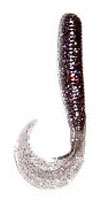 When the water temperature
begins to hit the 55 degree range and the fish are in
Shallower Water I always
When the water temperature
begins to hit the 55 degree range and the fish are in
Shallower Water I always
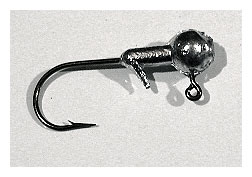 choose
a Prowler Pro Fat Grub. This bait is in 8400 series is a little larger and
bulkier at 4.5 inches in length. The tail gives off a great amount of
turbulence and these baits are absolutely deadly on shallow water bass.
I like fishing this size grub on a couple different weights of ball type jig
heads and on a couple different line weights depending on structure, wind
and how aggressive the fish are. Let me explain.
choose
a Prowler Pro Fat Grub. This bait is in 8400 series is a little larger and
bulkier at 4.5 inches in length. The tail gives off a great amount of
turbulence and these baits are absolutely deadly on shallow water bass.
I like fishing this size grub on a couple different weights of ball type jig
heads and on a couple different line weights depending on structure, wind
and how aggressive the fish are. Let me explain.
If the fish are extremely shallow I will Texas Rig my Prowler
Pro Fat Grub and use 10 or 12 pound test line a 3/16 ounce jig head. By
doing this I'm able to flip and pitch all the lay down timber, rock crevices
and other structure that might be holding fish that day. You don't want to
miss any structure and you always want to be aware of line movement or just
that "Different Feel". Sometimes the bite can be subtle but other times they
will jerk the rod out of your hands. The additional line weight gives me a
little more leverage in fighting fish in cover and the 3/16 ounce head
provides enough weight to get through the structure when needed.
If the fish have Moved Away From The Banks and have
began to Suspend let's say at the edge of the creek channel
where the bass have a choice of both shallow or deep water I like to use a
1/4 pounce ball jig and leave the hook exposed. I like to use either 8 or 10
pound test for this application. If the fish aren't aggressive but
still suspended in the same area I will switch to a 1/8 ounce jig head to
slow the fall down. Boat positioning is critical on this application.
There are times when when you will need to leave your boat in the shallow
water and make a cast out into the deeper water of the channel. It is
very important that you count down the bait as it falls. If the fish hits
the grub on the count of one thousand four then you can reasonably expect
the same thing to
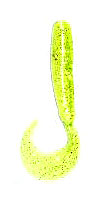 happen on your next cast.
If the fish fail to hit the grub on the fall work the grub back up the
channel edge keeping in contact with the structure using a semi-slack line
presentation. There are other times when it will be to your advantage to
position your boat out in deeper water and cast toward the shallow flat.
When this happens always work the grub quickly to the channel edge and then
begin to count the grub down. This same application works well when sitting
in deeper water off of points.
happen on your next cast.
If the fish fail to hit the grub on the fall work the grub back up the
channel edge keeping in contact with the structure using a semi-slack line
presentation. There are other times when it will be to your advantage to
position your boat out in deeper water and cast toward the shallow flat.
When this happens always work the grub quickly to the channel edge and then
begin to count the grub down. This same application works well when sitting
in deeper water off of points.
If I need a technique that will allow me to cover allot of
water, make longer casts, target suspended fish and bottom bump my Prowler
grub I always choose the Prowler 3.5 inch (8300 series) Grub rigged on a
3/16 ounce ball type jig head and 6 pound test line. This combination
lets you (power fish) work a multitude of area and various structure
quickly. Once fish are located I adjust from there. I keep a open mind and
I'm not reluctant to switch line weights, jig head weights and grub colors
as needed. Many times just a little adjustment can add several more bites
and bass in the boat over a period of a day.
What About Colors?
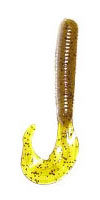 When it comes to colors
everyone has their own that they have confidence in. Let me add this,
If you don't have confidence in what you are throwing you might as well put
it back in the box! At this point all you will be doing is thrashing
the water. The following colors are my confidence colors for the lakes
and areas that I fish, they work for me over and over. Let's break this down
in a way that it might help you in making your next grub purchase.
When it comes to colors
everyone has their own that they have confidence in. Let me add this,
If you don't have confidence in what you are throwing you might as well put
it back in the box! At this point all you will be doing is thrashing
the water. The following colors are my confidence colors for the lakes
and areas that I fish, they work for me over and over. Let's break this down
in a way that it might help you in making your next grub purchase.
Sunny Days: Smoke Glitter and Tennessee Shad are my
first choice go to colors. Overcast Days: I like Chartreuse
Glitter, Chartreuse Pearl and White. Lakes Where Crawfish Are
Plentiful: Green Pumpkin or Pumpkinseed
Clear Water For Smallmouth And Spots: Chartreuse
Glitter, Chartreuse Pearl.
 I
have already explained that I like to use a ball head type of jig. I
have found this head to be the best all around style. This type of jig can
be used for swimming, hopping or crawling and on suspended fish. It
can be used as an open hook presentation or as a Texas Rigged application.
They come in multiple weights and hook shaft lengths. You can also purchase
them either unpainted or in a multitude of colors. To get a good look at the
entire Prowler line go to
www.prowlerlures.com on the web. Prowler can also be purchased in
all major tackle stores. Check yours for local availability.
I
have already explained that I like to use a ball head type of jig. I
have found this head to be the best all around style. This type of jig can
be used for swimming, hopping or crawling and on suspended fish. It
can be used as an open hook presentation or as a Texas Rigged application.
They come in multiple weights and hook shaft lengths. You can also purchase
them either unpainted or in a multitude of colors. To get a good look at the
entire Prowler line go to
www.prowlerlures.com on the web. Prowler can also be purchased in
all major tackle stores. Check yours for local availability.
Conclusion
I hope this brief article will shed some light on how I fish
a Prowler Pro Pitch Grub. You can catch fish on other brands but in my
opinion being on the water day after day to catch quantity and quality fish
my first choice is Prowler. Remember to always set a good example on the
water, respect others, safety first, give someone a fishing tip, snatch hard
and God Bless.......Tim Mason
Tip’s For The Beginner
Change Is Just Around The Corner
August 2006
Written By:
Rick McFerrin
Owner/Full
Time Guide
www.tennesseebassguides.com
Introduction
It’s August 18, 2006 and
I have just got back home from a guide trip on Old Hickory Lake here in
middle Tennessee. After a short nap I decided to finally sit down and begin
to write this Tips Article that’s been on my mind. It is now 3:45pm,
I’m looking out the bay window in our dinning room at a thermometer that’s
reading 97 degrees in the shade. This is a very typical day here in middle
Tennessee lately. It can be summed up in one descriptive word “Hot”.
It’s just been plain “Old Hot” here for weeks on end. I’m not sure
that we have had a summer that has been this hot Without Wind! Most
days there has been very little if any wind blowing during the morning and
mid day hours. The heat kicks up a thunderstorm every so often late in the
day, but for the majority of the time it’s just hot and still. “BUT” there
is change coming right around the corner!
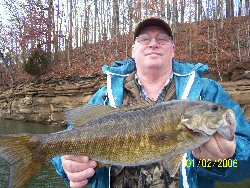 It won’t be long before the
97 degrees will be replaced with much cooler air temperatures. Shorts and
short sleeve shirts will be replaced with Body Amour and Gore-Tex suits.
Iced down spring water will be replaced with a thermos of hot coffee. Sun
block will be replaced with hand warmers. A quick ride in the boat to cool
off will be replaced with a Coleman heater to help stay warm. Yes,
change is just around the corner.
It won’t be long before the
97 degrees will be replaced with much cooler air temperatures. Shorts and
short sleeve shirts will be replaced with Body Amour and Gore-Tex suits.
Iced down spring water will be replaced with a thermos of hot coffee. Sun
block will be replaced with hand warmers. A quick ride in the boat to cool
off will be replaced with a Coleman heater to help stay warm. Yes,
change is just around the corner.
I can only speak for
myself, but I can truthfully say “Man I’m Ready”. I’m ready for the
Corp of Engineers to drop our water levels to winter pool. I’m ready to kick
my trucks 4 wheel drive in to get up and down the boat ramp. I’m ready for
the extended points, humps and bars that have been invisible all summer to
rise up above water level. I’m ready to be able to see my breath when I walk
outside. I’m ready to look at my clients and say “Nippy isn’t it”. I’m
ready to hear my lovely wife say “You’re crazy for fishing in weather like
this”. Yes, change is just around the corner!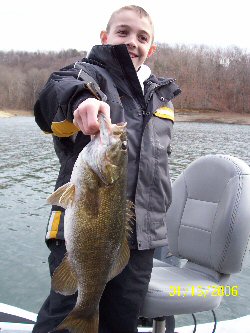
Not only is there
weather and water change around the corner but there is also a focus change
for me as well. My focus changes in the winter from primarily fishing for
Largemouth on Old Hickory Lake to fishing for those (as legend Billy
Westmorland said) “Ole Brown Fish” on Tim’s Ford Reservoir near Tullahoma
Tennessee. To me there’s nothing better than chasing winter Smallmouth
here in Tennessee. And we have an abundance of lakes and river systems to
chase them in.
For the beginner these
changes can become somewhat of a challenge and propose several questions
like. (1) How do you adjust to a 45 degree water temperature swing?
(2) How you adjust when much of the structure that you have been fishing all
summer long is now on dry ground? (3) What kind of adjustments do you
make in your tackle? (4) Do you make adjustments in your presentation? You
know the list of questions can go on and on. Hopefully I can shed some
light on this for those of you that are new to winter fishing. I certainly
don’t have all the answers. I’m learning more every year myself. And I know
that there are many ways to catch winter fish, but I just want to share some
of what works for me. As I always say, “Take what you can use and throw away
the rest. “. So fasten your seat belts, open your mind and here we go!
Why Switch Lakes?
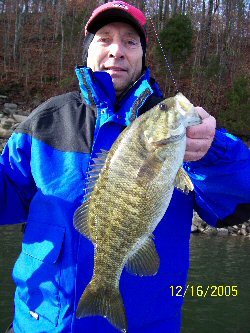 Before
I go any further I need to address why I switch from Old Hickory to Tim’s
Ford during the winter
Before
I go any further I need to address why I switch from Old Hickory to Tim’s
Ford during the winter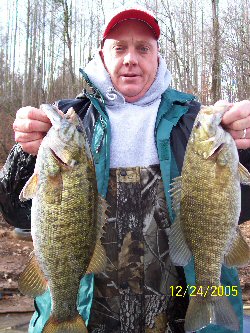 months. Old Hickory is a river lake that is known primarily for a
solid Largemouth Bass population. Old Hickory (22,500 acres) most certainly
has a Smallmouth population but acre for acre the density of Smallmouth vs.
Largemouth is less. On the other hand, Tim’s Ford is already famed
Dale Hollows closest middle Tennessee rival. Tim’s may never match Dale
Hollows reputation for quality but take it from this full time guide, Tim’s
Ford is a blue ribbon Smallmouth lake already. My personal best Tim’s
Smallmouth last winter was 6 pound 2 ounces, a trophy just about any where.
The pictures that are scattered through this article are just some of the
Tim’s Ford fish caught during the winter season. See what I mean? Also
in 2005 the TWRA established an 18 inch size limit on Tim’s Ford Smallmouth
which can only help to increase the quality every year. Mile for mile
lake structure on Tim’s is (at least for me) more conducive to Smallmouth.
There is an almost unlimited amount of deep water private boat docks, public
and private ramps, rock points, shallow sloping gravel rounds, ledges, mud
banks, long winding creeks and coves, islands, shallow water/deep water
access areas and quick drop off’s, major river channel points. Many of Tim’s
creeks are loaded with stumps and lay down timber protruding out into deep
water. Although Tim’s is only 10,500 acres it fishes much larger and has an
abundance of shad and crawfish for Smallmouth to feast on. Another factor
is, in the winter months you don’t have to depend as much on generation
schedules on Tim’s as you do Old Hickory. Let me also say that Tim’s
has a great Largemouth and Walleye population as well, which is always an
added bonus. Spotted bass also roam Tim’s clear waters but on the average
are smaller. If a fisherman is looking for a chance at a bragging size Spot,
Center Hill near Smithville Tennessee is the answer. There are so many
reasons why I fish Tim’s and one reason I don’t want to forget is “Tim’s is
easy on the eyes”. What a beautiful lake, it’s not hard to get caught up in
all the scenery around you. Plus it’s just plain fun to fish Tim’s!
Moving on!
months. Old Hickory is a river lake that is known primarily for a
solid Largemouth Bass population. Old Hickory (22,500 acres) most certainly
has a Smallmouth population but acre for acre the density of Smallmouth vs.
Largemouth is less. On the other hand, Tim’s Ford is already famed
Dale Hollows closest middle Tennessee rival. Tim’s may never match Dale
Hollows reputation for quality but take it from this full time guide, Tim’s
Ford is a blue ribbon Smallmouth lake already. My personal best Tim’s
Smallmouth last winter was 6 pound 2 ounces, a trophy just about any where.
The pictures that are scattered through this article are just some of the
Tim’s Ford fish caught during the winter season. See what I mean? Also
in 2005 the TWRA established an 18 inch size limit on Tim’s Ford Smallmouth
which can only help to increase the quality every year. Mile for mile
lake structure on Tim’s is (at least for me) more conducive to Smallmouth.
There is an almost unlimited amount of deep water private boat docks, public
and private ramps, rock points, shallow sloping gravel rounds, ledges, mud
banks, long winding creeks and coves, islands, shallow water/deep water
access areas and quick drop off’s, major river channel points. Many of Tim’s
creeks are loaded with stumps and lay down timber protruding out into deep
water. Although Tim’s is only 10,500 acres it fishes much larger and has an
abundance of shad and crawfish for Smallmouth to feast on. Another factor
is, in the winter months you don’t have to depend as much on generation
schedules on Tim’s as you do Old Hickory. Let me also say that Tim’s
has a great Largemouth and Walleye population as well, which is always an
added bonus. Spotted bass also roam Tim’s clear waters but on the average
are smaller. If a fisherman is looking for a chance at a bragging size Spot,
Center Hill near Smithville Tennessee is the answer. There are so many
reasons why I fish Tim’s and one reason I don’t want to forget is “Tim’s is
easy on the eyes”. What a beautiful lake, it’s not hard to get caught up in
all the scenery around you. Plus it’s just plain fun to fish Tim’s!
Moving on!
Answers To Some Puzzling Questions
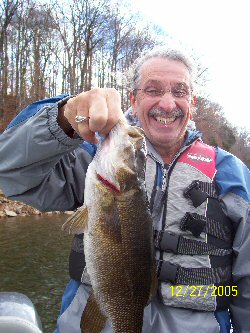 In
this section I’m going to try to answer some of the questions for the
beginner that I proposed above. Please keep in mind this is what works for
me on Tim’s Ford a deep moderately clear lake. Others may approach these
questions from a different angle. There’s always more than one way to skin a
cat, or in this case catch a Smallmouth!
In
this section I’m going to try to answer some of the questions for the
beginner that I proposed above. Please keep in mind this is what works for
me on Tim’s Ford a deep moderately clear lake. Others may approach these
questions from a different angle. There’s always more than one way to skin a
cat, or in this case catch a Smallmouth!
How Do You Adjust To
Falling Water? There are several factors directly related to this
question. #1) Normal surface water temperatures will still be on the warm
side as the Corp brings the lake down to winter pool. Then as the a fall air
temperatures and rains take on a chill and our nights stay down in the 60’s
50’s lower lake temperatures will gradually kick in. #2) “If”
everything is normal the draw down will be gradual. On occasion the Corp
will pull the plug and seemingly drain our lakes including Tim’s overnight.
When this happens fishing can be difficult for several days until the bass
adjust to being rudely moved out of their homes. Make no mistake about it
when the lake drops quickly it will have an adverse effect on the bass until
the lake and bass stabilize. On the other hand I have always found it
much easier to fish “rising water” on a shallow lake like Old Hickory
because it tends to move the bass out and back into the creeks and coves
that are so abundant. On a deep lake like Tim’s Ford I have found the bass
will simply follow the rising water up in basically the same relative
locations.
Let’s tackle question
#2 first. If you don’t retain anything but what I’m going to say next
it will be well worth your time. Falling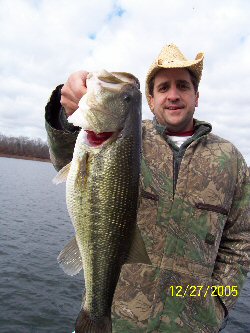 water will affect different lakes in various ways. Such as, if a lake is
relatively shallow and the fish are in the backs of the creeks when the
water begins to drop let’s say 5 feet, most likely they will move to the
nearest secondary break or point. As the water continues to drop another 5
feet the fish will move on to the next available point or break and so on
until the water stabilizes. But, on a lake like Tim’s which is a deep
lake, the fish will move much less in distance and their move will be
more horizontal than vertical. Bass on Tim’s just have a lot more water to
work with. So let’s say that this Saturday you get on some Smallmouth on
Tim’s on gravel rounds ¼ of the way back in the creeks near 2 main river
channel points and the fish are holding in 15 feet of water. The Corp drops
the lake 5 feet by next Saturday. Where do you look for these fish that you
were on a week ago? Have the fish moved and you look for them on the
channel points 75 yards away or still 15 feet deep on the same gravel round?
I always start at the 15 foot gravel round, Why? As I said the fish on Tim’s
have a lot more water to work with. I’ve watched this over the past several
years. On a deep lake it will take more factors than just falling water to
push a Smallmouth into a radical move.
water will affect different lakes in various ways. Such as, if a lake is
relatively shallow and the fish are in the backs of the creeks when the
water begins to drop let’s say 5 feet, most likely they will move to the
nearest secondary break or point. As the water continues to drop another 5
feet the fish will move on to the next available point or break and so on
until the water stabilizes. But, on a lake like Tim’s which is a deep
lake, the fish will move much less in distance and their move will be
more horizontal than vertical. Bass on Tim’s just have a lot more water to
work with. So let’s say that this Saturday you get on some Smallmouth on
Tim’s on gravel rounds ¼ of the way back in the creeks near 2 main river
channel points and the fish are holding in 15 feet of water. The Corp drops
the lake 5 feet by next Saturday. Where do you look for these fish that you
were on a week ago? Have the fish moved and you look for them on the
channel points 75 yards away or still 15 feet deep on the same gravel round?
I always start at the 15 foot gravel round, Why? As I said the fish on Tim’s
have a lot more water to work with. I’ve watched this over the past several
years. On a deep lake it will take more factors than just falling water to
push a Smallmouth into a radical move.
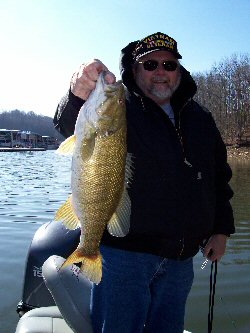 Comparatively
the percentage of decrease in water depth of 5 foot to total volume on Tim’s
is very small compared to the shallow lake. So always start on deep clear
lakes where you found the fish last time and “Then” work your way out.
Don’t panic as the water falls on Tim’s or other deep water lakes.
Historically it has been rare that Smallmouth head for 50 feet of water just
because of gradually falling water. Normally they are going to stay fairly
constant at the same depths. Other factors might make them move but not
gradual falling water.
Comparatively
the percentage of decrease in water depth of 5 foot to total volume on Tim’s
is very small compared to the shallow lake. So always start on deep clear
lakes where you found the fish last time and “Then” work your way out.
Don’t panic as the water falls on Tim’s or other deep water lakes.
Historically it has been rare that Smallmouth head for 50 feet of water just
because of gradually falling water. Normally they are going to stay fairly
constant at the same depths. Other factors might make them move but not
gradual falling water.
How Do You Adjust To
Falling Water Temperatures?. How hot has it been on the lakes where you
fish this summer? Here in Tennessee we have had surface temperatures near 90
degrees on most of our lakes. Temperatures all most like bath water. When
you talk about falling water temperatures this time of the year you almost
have to look at it in multiple stages. Let me explain.
I’ve addressed this same
question many times in various articles over the past several years. I was
brought up under the teaching that there were “Magical Water Temperatures”
that would push bass into (a) spawn in the spring (b) fall patterns
(c) winter patterns. Truthfully I have found that not to be so. I don’t
believe it’s 70 degrees or 60 degrees,. Rather I believe the INITIAL FALL
PATTERNS are kicked in when the water temperatures makes a permanent 8 to
10 degree decline in late summer/early fall and same is true in the Spring
but in reverse. So this year (ONLY AS A RULE OF THUMB) I would consider 75
to 65 degrees early and mid fall. 65 to 55 late fall early winter. Then 55
and below winter. Remember I said I will use this as a rule of thumb on
Tim’s Ford this year. It might be different on your lake but the formula
should be close.
One way that you can
visually see the beginnings of a fall pattern is by watching bait fish.
Usually as the water cools the bait fish
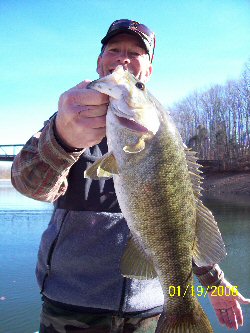 will
move further back into the creeks and coves. NOTE: This paragraph is for
those of you that might fish a lake with an over abundance of shad. As an
example let’s look at Old Hickory in past year. Shad last year and two years
ago was so thick you could almost walk across the water on them and not get
your feet wet. They were every where, all the time. River channels, coves,
docks, creeks and pockets, solid shad everywhere every day. If your lake is
like that it presents a little tougher situation and you have to rely more
on covering a lot of water and good use of your electronics than just the
presence of shad alone.
will
move further back into the creeks and coves. NOTE: This paragraph is for
those of you that might fish a lake with an over abundance of shad. As an
example let’s look at Old Hickory in past year. Shad last year and two years
ago was so thick you could almost walk across the water on them and not get
your feet wet. They were every where, all the time. River channels, coves,
docks, creeks and pockets, solid shad everywhere every day. If your lake is
like that it presents a little tougher situation and you have to rely more
on covering a lot of water and good use of your electronics than just the
presence of shad alone.
If we have a “Normal
Fall” water temperatures will slowly but steadily decrease. Water
temperatures won’t fall from 85 degree to 50 degree over night. This slow
decline in temperatures gives bass time to adjust incrementally. Let me
explain it this way. I know this may be somewhat simplistic but that’s just
the way I am. As I said in the opening of this article it is 97 degrees in
the shade, it’s hot! My body has adjusted to this heat, it’s hot but I’m use
to it. Now let’s just say for fun that I go to bed tonight with the air
conditioner left on 75 degrees like normal. Over night the air temperature
outside drops from the high 90’s to 45 degrees or less. A 45 degree drop
over night and it’s not getting any warmer during the day. What a shock!
I wake up and I swear I see ice cycles hanging off our dresser mirror. I
quickly by pass the shorts and tee shirt I was going to wear and grab a pair
of jeans, long sleeve tee shirt and a sweatshirt. Man it’s cold, what a
immediate shock to my system. I wasn’t prepared for this. The
temperature is 45 degrees but my body is still operating at the 90 degree
level. See where I’m going with this? But what happen if it takes 60
or 90 days for the air temperature to drop from 97 degrees to the same 45
degrees? The shock isn’t as great or maybe there’s no shock at all. My body
has time to adjust to the declining air temperatures as I said above
incrementally. I’ve adjusted gradually.
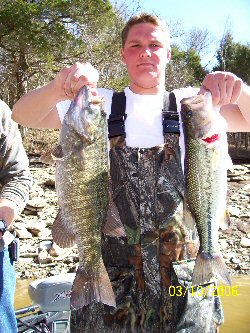 This
is probably an over simplification but the same principle applies to bass
and their behavior relating to declining water temperatures. If the
water temperature dropped from 85 degrees to 50 degrees overnight the bass
would be running for cover like me running for heavier clothes. They would
have lock jaw for how long? How Long? If your answer is until their bodies
have had time to adjust you would be very close to being right. I can
see the bass now, all huddled up under one big log, trying to get warm and
looking at one another, not moving a fin and saying I’m not going out
there!. But when the temperatures drops gradually from 85 to 50 the
bass adjust to it gradually as well. The falling temperatures begin to nudge
them into their fall /winter way of thinking and reacting. Then it’s up to
us to adjust gradually in the way we approach our fall and winter game
plans. Don’t get ahead or behind yourself study the deep lake your on
and be vigilant of everything that’s happening around you.
This
is probably an over simplification but the same principle applies to bass
and their behavior relating to declining water temperatures. If the
water temperature dropped from 85 degrees to 50 degrees overnight the bass
would be running for cover like me running for heavier clothes. They would
have lock jaw for how long? How Long? If your answer is until their bodies
have had time to adjust you would be very close to being right. I can
see the bass now, all huddled up under one big log, trying to get warm and
looking at one another, not moving a fin and saying I’m not going out
there!. But when the temperatures drops gradually from 85 to 50 the
bass adjust to it gradually as well. The falling temperatures begin to nudge
them into their fall /winter way of thinking and reacting. Then it’s up to
us to adjust gradually in the way we approach our fall and winter game
plans. Don’t get ahead or behind yourself study the deep lake your on
and be vigilant of everything that’s happening around you.
What kind of tackle
adjustments do you make?: As we move into the Fall and Winter you might
be making the same type of move to a deep clear lake like me, there are
several factors that I believe can make the difference between experiencing
a good season or a so so season. Let’s look together.
Line: First of
all let me say that I tend to be a “Light Line” fisherman most of the time
no matter where I fish. So line adjustment which to me is so important
especially on a deep clearer lake I already have in place. Over the years I
have fished with 100’s and 100’s of people. Many of them in our pre-trip
conversations will express their desire to use their own equipment. No
problem-truthfully if I fished with a guide on another lake I would most
likely want to us my own equipment as well. When we get to the subject of
line size and I tell them that I use 6 pound test blue florescent for most
techniques (occasionally 4 pound test) and when I’m throwing heavy spinner
baits or some 20 plus crank baits I use 8 or 10 pound max there is a
noticeable silence on the other end. Most of the time they will tell me
that they have 15 or 17 pound test on and they aren’t really comfortable
with anything lighter. Not fully understanding how important light line is
they come the day of the trip with heavy line. But it isn’t long before
their asking to use one of my rods because they can see the difference in
the amount of hits I’m getting verses them using the exact same baits. Light
line just makes that much difference. And when you combine the small
diameter of light line with the visibility of blue florescent it gives you
the ability to see the smallest of hit’s no matter what lure you are using.
With florescent line you can see the bait move slightly off to the side, you
can see the small quiver or tick in the line as the bait is falling. I
would just as soon stay home than have to fish Tim’s with heavy line for
Smallmouth.
The question always
comes up when you are talking about light line, What About
Breaking Fish Off? Well, I guess I would have to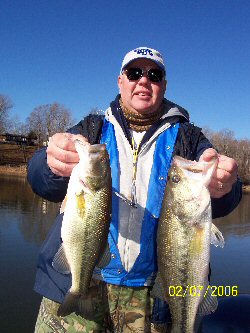 answer that this way. That’s what your drag on you reel is for. If you fish
light line with your drag winched down tight I think you will be in big time
trouble. But on the other hand if you are using the correct action rod
(which we address next) and a reel with good line that has the drag set
properly, and retying when you should, you will break off very few fish.
answer that this way. That’s what your drag on you reel is for. If you fish
light line with your drag winched down tight I think you will be in big time
trouble. But on the other hand if you are using the correct action rod
(which we address next) and a reel with good line that has the drag set
properly, and retying when you should, you will break off very few fish.
Rods: This is
going to be an easy on for me. There is only one brand of rod that I use and
that is All Pro rods.
www.allprorods.com Roger Ray owner and V.P. Billy Campbell absolutely
build one of the finest rods that you can ever have in your hands. It’s
difficult for some folks to put down their pool cue rods and opt for
different tackle. I can assure you as a full time guide making changes like
this will increase you catch ratio drastically. I use basically 3 different
All Pro Rods on Tim’s Ford. These are the length and action that work best
for me.
All Pro APX7MST 7
Foot Medium Action: Lure weight on this rods is 1/4 to 5/8 ounce with a
recommended line weights of 6 to 12 pound test. These rods are 100% American
made by American Rod Builders. All APX rods are built with the blank
running through the Fuji reel seat and handle which give you unmatched
sensitivity. On the handle itself there are also graphite sensor rings that
transmits additional sensitivity from the rod into your hands. From the
instant you pick up one of these high quality rods you will be amazed at how
light it is but how sensitive and powerful it is. Finished off with
Gudebrod thread wrap and polished titanium guides that provides smooth cast
and greater distance with lighter baits (which is ultra important on clear
lakes) this rod is unbelievable. People laugh when I say I can feel the
turbulence from a Smallmouths tail when he swims by…a little stretch but not
by much. I use this rod for all my crank baits up to 15 plus type baits,
hard body and soft plastic jerk baits, most top water, some soft plastics
and light to mid range spinner baits and buzz baits. All I can say is
wow!
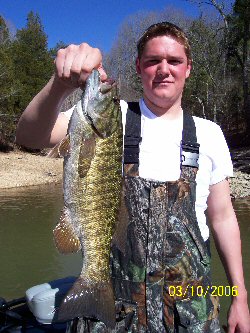 All
Pro AtlAntis Series AT76MLS 7’6” Medium Light Action: Lure weight on
this rod is 1/16 to1/2 ounce. Recommended line weight is 4-8 pound test.
When I didn’t think Roger and Billy could come up with something else as
fantastic as the APX they introduced the AtlAntis series rods. Roger
was approached by inshore saltwater guides to build a rod for redfish,
speckled trout, tarpon and snook. The All Pro team went to work and over the
course of many months of R&D these rods were developed. When the first proto
types arrived at the office I couldn’t wait to get my hands on one.
Immediately when I held one my mind raced to small crank baits, mini hair
jigs, finesse shaky head worms, whirly bee’s, small/light top water baits,
live bait and more. The 7’ 6” length enables you to get extra long casts
with extremely light baits. The same 100% American made construction but
built extra tough for salt water use but yet light as a feather. I
have used these rods since the Fall of 2005 and I can tell you from personal
experience that the construction and length of these rods will absolutely
wear a fish down at the boat. Light weight construction, unbelievable
sensitivity (let me say that again) unbelievable sensitivity and power when
you need it.
All
Pro AtlAntis Series AT76MLS 7’6” Medium Light Action: Lure weight on
this rod is 1/16 to1/2 ounce. Recommended line weight is 4-8 pound test.
When I didn’t think Roger and Billy could come up with something else as
fantastic as the APX they introduced the AtlAntis series rods. Roger
was approached by inshore saltwater guides to build a rod for redfish,
speckled trout, tarpon and snook. The All Pro team went to work and over the
course of many months of R&D these rods were developed. When the first proto
types arrived at the office I couldn’t wait to get my hands on one.
Immediately when I held one my mind raced to small crank baits, mini hair
jigs, finesse shaky head worms, whirly bee’s, small/light top water baits,
live bait and more. The 7’ 6” length enables you to get extra long casts
with extremely light baits. The same 100% American made construction but
built extra tough for salt water use but yet light as a feather. I
have used these rods since the Fall of 2005 and I can tell you from personal
experience that the construction and length of these rods will absolutely
wear a fish down at the boat. Light weight construction, unbelievable
sensitivity (let me say that again) unbelievable sensitivity and power when
you need it.
All pro APX
Series APXCS7MHCA Medium Heavy Action: Lure weights on this rod is 1/4
to 3/4 ounce. Recommended line weight is 8 to 17 pound test. This is the rod
I use for all my larger/heavier baits. I particularly like the tip action
on this rod and you can feel every thump of a spinner bait blade and every
wiggle of a crank bait. I spool my bait casters with 8 or 10 pound
test max. This rod is ultra sensitive, strong, rugged and responsive to hook
sets. These are the 3 rods that I use day in day out on Tim’s Ford. I
can’t explain enough how important rod sensitivity is. Many times it’s just
a different feel. Something that’s just not normal when a Smallmouth inhales
a small bait. If you are sitting there with the wrong equipment you have
greatly limited your success before you even get to the ramp. Now let’s
tackle the last point. Lure or bait presentation.
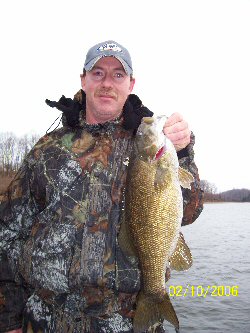 What
adjustments do you make in presentation? Most people that are use
to fishing lakes that are more on the shallow side tend to sit out away from
the bank and cast in. This type of presentation works well in that
setting. But when you are fishing a lake where the banks drop of quickly,
you are much better off to parallel the banks. This is very easy to do
with no more than one or two people in the boat, almost impossible with
three.
What
adjustments do you make in presentation? Most people that are use
to fishing lakes that are more on the shallow side tend to sit out away from
the bank and cast in. This type of presentation works well in that
setting. But when you are fishing a lake where the banks drop of quickly,
you are much better off to parallel the banks. This is very easy to do
with no more than one or two people in the boat, almost impossible with
three.
Here is the way I
approach an area that I intend to fish. First I shut my motor down a
considerable distance away from the area I want to fish. I always use just
enough trolling motor speed to do the job. My first thought is not to make
any more noise than I have to. If the wind is blowing into the bank I’m
going to fish (hopefully it is) I stay off the bank far enough to keep the
boat from banging into the rocks but still parallel with the bank. If
there isn’t a wind I position my boat to where you can almost step out on
the bank. The whole idea is to keep the bait that you are using in the
“Strike Zone” as much as possible. If you are throwing crank baits you will
want to beat and bang off everything possible on your retrieve back to the
boat. The same is true with spinner baits. When I come to a point or just
before the center of a round I swing my boat out away from the bank so we
can make repeated casts across the face of the point. If I elect to
fish the backside of the point I immediately reposition my boat back again.
I have also found that when fishing non-weed less hair jigs and live bait
it’s better for me to sit out and cast in to keep from being hung as much.
Saves a little aggravation.
Most of the fish we
catch late fall and winter on Tim’s Ford will be in 15 feet of water or
less. That’s not to say that there isn't suspended fish that can be caught
in deeper water with a spoon or drop shot rig. But by in large if you will
position your boat against the bank as close as possible you will find your
catch ratio will go up dramatically.
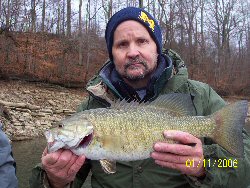
Conclusion
Yes change is just
around the corner and you can be there enjoying every bit of it. I hope that
I have given you some things to think about. Every ounce of content in this
article works for me day in and day out as a full time guide. Remember all
of these up coming events depend on decreasing water temperatures. Be aware
each day you are on the water of the changes that have taken place. Sit
down at home before you get to the lake and lay out a tentative plan of
action and then adjust as need on the lake. If I can help you or
answer any questions feel free to e-mail me at
rickm@dtccom.net or through my web site at
www.tennesseebassguides.com Office telephone number is (615) 765-7303.
Thank you for reading this article….I hope you have a great fall and winter
season. Rick McFerrin Owner/Full Time Guide Tennessee Bass Guides LLC.
Tip's For The
Beginner
"Up The Creek
Without A Paddle"
June 2006
Written By: Rick
McFerrin
www.tennesseebassguides.com
Introduction
Every
week when I'm on the water I see younger and younger folks launching their
boats. 30-40 years ago that was me. Just seems like yesterday. Not that I
have all the answers, but over these past years I have learned some things
the hard way. Like many of you, I've paid my stupid tax. I've earned my
sign. Sometimes trial and error can be a hard teacher. I hope this
article will help some younger folks avoid some of this when it comes to
being properly prepared when you reach the lake.
I
guess I'm showing my age when I begin to quote old sayings like the title of
this article. For those of you that are considerably younger than me this
old saying simply means your in a world of hurt with no immediate help in
sight. Have you ever been there? Not a good feeling to be in a situation
like that is it? Hey! I can tell you another one. Ready? How about
being at the ramp and your cranking battery is dead? Or even worse your 19
miles from no where and the cranking battery won't even click! Or you have
worked 90 hours this week at your job, you finally have a day off. Your at
the lake sitting right on top of a whole heard of 10 pound largemouth that
haven't eaten in 2 weeks. They would hit a potato chip if you could get it
in front of them. The wind picks up to 20mph and your trolling motor
batteries are D-E-A-D! Man that's not a bad dream that's a nightmare.
Does
any of this ring a bell? Have you ever been "Up The Creek" with battery
problems? All joking aside I've learned that it's easy not to pay enough
attention to the condition of the batteries aboard your boat. You see our
minds are focused on "Rods"-"Reels"-"Lures"-"GPS" etc. Hopefully
this Tip's Article will answer some questions that may save you some
frustration on the water somewhere down the road. Let's take a look.
The One Battery
Type Will
Work For All
Marine
Application
Theory
Through out the year I have the opportunity to hold many instructional
seminars speaking on a variety of subjects. I discuss rods-reels-line-lures
and techniques that work for me on a seasonal basis. One area that I stress
in every seminar is the "One rod for all techniques theory" just doesn't
work. As a matter of fact when you try to use the same rod for
everything, from throwing small hair flies to crank baits to spinner baits
to top water to Carolina rigging etc All your doing is setting yourself up
for frustration and sure failure. You see, the same principle applies
directly to batteries that we use in our boats. The "One Battery Theory" is
just plain wrong! Let me explain.
When
we buy a new boat the manufacturer installs marine batteries that meet the
need of that boat based on the electrical equipment that's onboard. Then
after several years and multiple usage these batteries will naturally need
to be replaced. What do we do then? Let me answer this question by
explaining what we shouldn't do. It's tempting with all the rising costs for
gas and oil that we put in our boats to think "I'll scrimp a little here"
and buy a cheaper car battery for my boat instead of a marine battery.
WRONG! WRONG! If you do this you will look back and say
"@#$%^&*" That's code for what a dummy. Let's look at the difference.
Car Batteries
Car batteries are designed to provide a maximum amount of current in short
bursts. These batteries are designed this way to provide the needed current
to turn over the cars engine. Then when the motor starts the alternator
takes over and provides power for the car. With this type of system a
car battery may never be drained more than 20% of it's total capacity. When
used this way a car battery can last for years. Not to get too technical but
a car battery uses thin plates in order to increase it's surface area and
provide power. But on the other hand.
Deep Cell
Marine Batteries
Where
car batteries are designed to provide short bursts of current a marine
battery is designed to provide a steady amount of current over a long period
of time. A deep cell battery can provide a surge when you need it but not
near the surge a car battery can. Deep cell batteries are designed to be
"Deeply Discharged" over and over again. Please catch
this! Deep discharge of a car battery over and over will ruin the
battery quickly! Thus "Up The Creek Without A Paddle" See where
I'm going? Marine deep cell batteries can withstand several 100 total
discharge/recharge cycles. While a car battery is not designed to be
completely discharged. So how do I choose the right type of deep cell marine
battery to meet my need?
Choosing The
Right Battery
This
can be a fairly simple process if you haven't added additional aftermarket
electrical equipment to your boat since you bought it. If everything is
status quo and your current batteries were meeting your needs then replace
them with the same Amp Hour rated deep cell battery. But, if you have
added additional equipment your minimum Amp Hour requirement will naturally
increase. This is where you need to discuss your current needs with a
trained battery technician. When replacing trolling motor batteries
you need to know that a 12 volt system requires a minimum of 1.1 to 1.2 amps
per pound of thrust. A 24 volt system requires .85 to .95 amps per
pound of thrust. And a 36 volt system requires .5 to .55 amps per pound of
thrust. Once again this is where a trained battery tech can save you a
lot of frustration and head aches. Now that I have the right batteries
how do I recharge them?
Charging My
Boat Batteries
Most
bass boats manufactured to day come equipped with onboard chargers. So for
many of us as long as they are working correctly our need is already met.
But what if the charger isn't working correctly or your boat and you need to
buy a new one? There are several different types of chargers on the market
today that can be used to charge deep cell batteries. Most of them are
parallel type chargers that have the capacity to taper the current (in amps)
while regulating voltage at the same time. With so many brands on the market
today here's some suggestions that might help you.
(1)
Choose the right charger that is made for the type of battery you intend to
recharge. Such as (a) Liquid Electrolyte (b) Marine/RV (c) Auto (d)
Maintenance free or gel batteries. (2) Match the proper battery voltage such
as 6 volt-12 volt-24 volt or 36 volt. (3) Choose the correct charger size in
Amps. A good rule of thumb is that the charger should provide a maximum of
20 amps for each 100 amp hour of the battery (4) Your charger should be able
to fully charge your batteries within 8 to 12 hours max. (5) To avoid costly
mistakes choose a charger that is timed or will automatically shut off when
the battery reaches full charge.
Additional
Tip's
This is important. (1) Always charge your batteries immediately after
you use them When you allow batteries to sit several days without recharging
it will hamper the recharge acceptance and over a period of time shorten the
life of your battery. (2) Avoid trickle chargers. For the most part
these chargers are low current inexpensive chargers that lack the
sophisticated electronic circuitry to properly regulate current and voltage.
When you use a charger like this Don't use it for any length of time because
battery damage can occur. (3) Check your batteries water supply regularly.
By doing this you can determine whether your onboard or external charger is
operating the way it should. If your batteries are using excessive water
your charger may be overheating and overcharging charging your batteries. If
your running out of power quicker than normal you need to check not only the
charger but your battery condition as well.
Conclusion
Here
at Tennessee Bass Guides our team is on the water 1000's of hours each year.
We depend on having batteries that will meet our needs day in day out. Cold
weather-hot weather-daytime or night. Just like you we can't afford to be
"Up The Creek Without". That's why we only use Interstate Batteries in our
boats. Interstate is the #1 Selling Marine battery on the market today. When
you are in need of a new battery or advice on your battery needs check out
your nearest Interstate dealer. These guy's know batteries inside and out
and are always happy to help you diagnosis your needs. If you are in the
middle Tennessee area see Chris Woods General manger of the Interstate
Battery store at 3729 Highway 109 North in Lebanon Tennessee. If your not
sure where they are located call 1-615-449-2555 for direction. I
sincerely hope this Tip's Article will help someone that is new to boats and
batteries. Hope to see you on the water. Rick McFerrin owner
www.tennesseebassguides.com
When You're Not Sure
?
Where Do You Start?
Written By: Rick McFerrin
www.tennesseebassguides.com
Introduction
Recently I was loading my boat after one
of my guide trips, when two young anglers pulled up beside me on the ramp in
their bass boat. We exchanged "Howdy's" and then the normal ramp
question popped out from one of them. "How did you guy's do?" One of my
clients said "We did great" and then in his excitement began to tell about
all the fish the he and his father had caught.
Automatically I could see the look of
despair on the two young guy's faces, which told me instantly how their day
had gone. And again before I could step in my client asked "How did
you do?" I believe their answer was "It's our first time on this lake and we
didn't do nearly as good as you!" Then...the very next question from
them was
"What
were you throwing-and what color
was it?" In over 50 years of bass fishing I
have been on both sides of that ramp conversation. I've been the guy smiling
and I've been the guy frowning. I've been the bug and I've been the
windshield. And I'm sure that you have also.
So let's go back for a
minute and start over with the original question. When you're not sure-Where
do you start? First of all I don't believe it starts with What
you're throwing or what color it is! To me the most important
question these young guy's should have asked was "How deep were the fish
holding?" You see if you have a fix on their depth then everything
else will eventually begin to kick in.
But let's say for a minute
that your getting ready to fish a lake that you have never been on before.
You don't have anyone to ask about fish depth or to give you good fishing
information. You don't have any prior lake specific information passed on to
you and now your at THE RAMP! What now? Well, I've got some bad news
for you! If you have waited until arriving at the ramp to ask the question
"What Now" you may be in for a very long day. You may have set your self up
for sure failure. Where did you go wrong? Let's try to answer that question.
Lack Of Prior Planning =A Long Day At
The Lake
Many people work off the
idea that bass will be shallower in the Spring, deeper in the Summer and
Winter, and somewhere in-between during the Fall. The truth is "That's Not
Always True!" Relating the time of the year to the depth of the fish can be
deceiving. There are so many contributing factors (no matter what
season it is) that will help determine how deep fish will be holding.
Factors such as (1) Light penetration (2) Oxygen Content (3) Recent Rains
(4) Recent Snows (5) Wind Direction And Velocity (6)Water Clarity (7)
Current or Lack Of (8) Cover (9) Rising Or Falling Water (10) Food
Availability and much more.
My suggestion on where you
start actually happens BEFORE you get to the lake. Not everyone can afford a
GPS with specific lake mapping capabilities that most certainly help you on
a new lake. But most of us can afford a good Contour Map of the lake
we intend to fish. A good and let me say that again, a good map will give
you a detailed view of what the lake is all about. Please beware that lake
maps vary when it comes to contour line depth designations. For instance,
some map makers will use 20 foot intervals between contour lines, but I have
always like the maps that use either a 5 foot or no more than a 10 foot
contour line separation. The reason for this is because it will give
you a much more detail. Maps that use a lot of contour lines will help you
define subtle shallow water changes that many times will hold the key to a
successful day. Good maps will show old house foundation locations, flooded
cemeteries, old ponds, hidden road beds, sunken bridges, culverts, shallow
points, stump rows, shallow ledges, shallow flats, coves, creeks, boat
ramps, marinas and much more.
So the first place I start
is with my map and a highlighter, marking the key areas that I want to
fish in water 10 feet and down. Shallow areas that might be closer to well
defined channels that has as much cover as possible. Since you haven't been
to the lake some areas you will mark won't pay out. So concentrate on the
ones that have cover such as grass, wood, chunk rock, bank transition areas,
current, shallow outside bends of main channels, points of major and minor
creek entrances. Also check out the current side of visible and underwater
islands in that 10 foot or less range. One sure area to key on is boat ramps
and marina areas. I catch a lot of fish around boat launch areas. Many of
these ramps will have a chunk rock wall that will butt up against the sides
of the concert as it descends into the water that provides a current break
and ambush are for bass. At the end of many ramps there will be a "Blow Out
Area" which is a hole that has been created at the end of the ramp from the
constant loading and unloading of boats that can hold a multiple fish. Other
ramps will have a definite drop or ledge area on either side and at the end
of the ramp itself. Ramps are always a good place to start instead of
running some where right away. Another plus with ramps is that many of them
are lighted. At night this light will draw bait fish in and consequently
bass. I very seldom crank my outboard when unloading my boat. I always float
it off and then use my trolling motor to get to an area to tie up so I can
park my Tahoe. Most times if there are active fish on or near the ramp
you still have a good shot at them if you start out being as quite in the
beginning as possible.
In marinas I like to
concentrate on not only the ramp area but when I can the water that is
between the dock and the bank. Some of these areas will have concrete sea
walls that very in design and depth that offer fantastic fishing at times.
Other will have cables and huge sunken concrete anchors that are used to
stabilize portions of the dock. These concrete blocks provide great ambush
areas for bass. Some will have vegetation like grass or lily pads. Other
might have a chunk rock finger or jetty that is used as a wind break for the
marina. Marinas always have an abundance of shade, structure and food
available for bass all year long. Older marinas many times will have remains
of old docks, work barges and other debris and building material located in
shallow water areas that can be like magnets to bass. Actually marinas are
almost like a lake within a lake when it comes to potential places to find
not only several bass but many quality fish as well.
So where do I start on a
new lake that I have no outside help or information on? I start at home with
a good map planning session that will lead to a well defined shallow water
game plan for when I get to the lake. Now, do you remember the question that
the two young guy's asked me first? You know the one. "What were you
throwing? Let's try to answer that now.
Shallow Water Search Bait Of Choice
My personal search bait of
choice all year long is a crank bait. In my humble opinion using a crank
bait is an excellent way to locate fish. You can cover a tremendous amount
of water in a short period of time and still be very thorough in your
search. If there are two of you in your boat that works out even better. You
and your partner can use different depths baits and vary your color
selection until you hit on the right combination.
Now I can almost hear
someone say "But Rick it's winter where I live" you don't throw crank baits
in winter do you? Let me answer that this way. The only reason that I
wouldn't start out with a crank bait is if the lake was frozen solid.
I born here in Tennessee and moved back home almost 20 years ago. For
several years before that I worked for a corporation in Indiana. We couldn't
wait until "ICE OFF" day. Not three weeks later, but "THE DAY" that
the ice came off many of our Northern Indiana Lakes. You would find me
throwing a crank bait in the old lily pad fields in 3 to 5 feet of water
killing the bass and there would still be chunks of ice floating.
Here in Tennessee we have
been in the midst of winter just like you have. Our water temperature last
week on the lake I guide all winter was 45 to 46 degrees and the bass are
slamming a crank bait and have all winter long. Sometimes you have to slow
or pause your retrieve. Sometimes the "Slam" turns into a "Soft Weed Like
Feeling" But either way, bass will attack crank baits in cold water. I have
proven it with my clients every winter.
Conclusion
Keep in mind that this
article is based around fishing a lake that you haven't been on before. A
lake where you have had no outside help or information about. A lake where
you don't know at what depth the fish are holding or what they are hitting.
If your fishing your favorite lake you may know that they are hitting a jig
better than a crank bait, BUT that is a whole different set of
circumstances. If you are contemplating a trip to a brand new lake that you
have no information on. Start with:
(1) At home with a good
contour map that breaks it's depth intervals in 5 foot increments if
possible. One that shows all the various structure I have already listed.
(2) Lay out a good game
plan for what you are going to do and where you are going to start when you
get to the lake.
(3) Use a crank bait as
your search bait that lines up with water color and depth conditions. Don't
hesitate to switch colors, depths of baits and vary your retrieve until you
hit on the right combination.
(4) Be meticulous in
searching out the best shallow water areas. Leave no rock unturned. Chunk
the crank bait where angles fear to tread....you might get your arm broke.
(5) Wear a good pair of
polarized sun glasses (even on cloudy-rainy-dreary days) and be constantly
aware of what is moving around you under the water. I sight fish a lot when
the water is clear enough to do so. Many times you will see just a slight
flash near a log, rock or some other type of structure. When you do place
the crank bait just passed the structure and bring it back in. If the water
is real cold or the fish are sluggish you may have to make repeated casts
before "Wham" get the net!
(6) If the bait fish are
active in the areas your fishing, try to get a close look at them and match
their size and color as close as possible.
(7) When you
establish a shallow water pattern, stick with it and don't waste your time
on unproductive areas.
I hope this has helped you
and given you something to think about as you plan that next trip to
uncharted waters. This is part #1 in a series of articles that I hope will
help you answer the question "Where do I start Now?" Stay tuned for part
two. Rick McFerrin Owner/Full Time Guide www.tennesseebassguides.com
Successful Baits For
Your Spring Time Arsenal
Written By: Timothy Mason
www.tennesseebassguides.com
Feb 2006
Introduction
During the course of a
normal year I spend countless hours on the water guiding and fishing
tournaments. Over time I have settled in on three soft plastic baits that
have continually helped me to have countless successful trips in the spring.
I want to share these with you today, and consider these a Must for
your tackle box. The the three baits that we will look at today are (1)
Prowler Grubs (2) Prowler Tubes (3) Prowler Worms. Take these three baits,
add water and you have a recipe for a successful day on the water!
One of the reasons that
they work so well is their versatility. These baits have been effective for
me in water as cold as 38 degrees. They perform well in lakes that
have heavy fishing pressure. They are great on high pressure blue bird days.
They can be fished shallow or deep, slow or fast. They can be fished
in all types of structure from grass to rip-rap-bridges-humps points, lily
pads and more. Let's take a closer look at these three deadly spring time
baits.
Prowler Grubs
 The 3 inch
and 5 inch Prowler Grubs have a very strong resemblance to a bait fish and
are
The 3 inch
and 5 inch Prowler Grubs have a very strong resemblance to a bait fish and
are both very
effective in clear or stained water. When bass are chasing bait fish don't
hesitate to throw a grub. Fish it right under the surface on a fast
retrieve, then pause and let it flutter and then repeat the process back to
the boat. To swim a grub, make a long cast take up your slack line, point
the rod tip toward the grub and then reel slow and steady back to the boat.
By using this method you can target the fish that might be in a suspended
pattern. I also like to fish a grub on a Carolina rig. I keep my color
selection simple staying with pumpkin seed, smoke, white, watermelon seed
and June bug. I catch allot of Smallmouth on Prowler Grubs rigging them on a
1/16th ounce jig head on 6 or 8lb test line. My rod of choice for fishing
Prowler Grubs is the AllPro APX66MSRS spinning rod. This rod is tailor made
for this application. View all the APX rods at
www.allprorods.com
both very
effective in clear or stained water. When bass are chasing bait fish don't
hesitate to throw a grub. Fish it right under the surface on a fast
retrieve, then pause and let it flutter and then repeat the process back to
the boat. To swim a grub, make a long cast take up your slack line, point
the rod tip toward the grub and then reel slow and steady back to the boat.
By using this method you can target the fish that might be in a suspended
pattern. I also like to fish a grub on a Carolina rig. I keep my color
selection simple staying with pumpkin seed, smoke, white, watermelon seed
and June bug. I catch allot of Smallmouth on Prowler Grubs rigging them on a
1/16th ounce jig head on 6 or 8lb test line. My rod of choice for fishing
Prowler Grubs is the AllPro APX66MSRS spinning rod. This rod is tailor made
for this application. View all the APX rods at
www.allprorods.com
Prowler Tubes
 Tubes rank
as one of the best soft plastics that has ever been made for catching big
bass. A tube has all the
Tubes rank
as one of the best soft plastics that has ever been made for catching big
bass. A tube has all the strong points of a jig without their weaknesses. A tube can be fished in the
heaviest of cover or can swim it out in open water imitating perfectly an
injured bait fish. I have taught at Bass Pro Shops in Nashville for over 6
years now and I can tell you this technique works! I don't think you
can go wrong with any color but my favorites are green pumpkin, watermelon
seed, pumpkin seed, white, and June Bug. I like to insert a Prowler
rattle into my tubes. I think these have to be the loudest rattles on the
market. I swim a Prowler Tube on 1/8th-3/16th and a 1/4 ounce jig heads on
6lb or 8lb test line and HOLD ON! They are also awesome on a Carolina Rig or
being pitched and flipped into heavy cover. I also like to throw the 3
inch Prowler Stubby Tube without a rattle letting it fall slowly in and
around shallow grass beds. I use a couple different AllPro APX rods for
these applications. The APX80HTFS for Flipping a tube and the AllPro
APX76HTFS for Pitching.
strong points of a jig without their weaknesses. A tube can be fished in the
heaviest of cover or can swim it out in open water imitating perfectly an
injured bait fish. I have taught at Bass Pro Shops in Nashville for over 6
years now and I can tell you this technique works! I don't think you
can go wrong with any color but my favorites are green pumpkin, watermelon
seed, pumpkin seed, white, and June Bug. I like to insert a Prowler
rattle into my tubes. I think these have to be the loudest rattles on the
market. I swim a Prowler Tube on 1/8th-3/16th and a 1/4 ounce jig heads on
6lb or 8lb test line and HOLD ON! They are also awesome on a Carolina Rig or
being pitched and flipped into heavy cover. I also like to throw the 3
inch Prowler Stubby Tube without a rattle letting it fall slowly in and
around shallow grass beds. I use a couple different AllPro APX rods for
these applications. The APX80HTFS for Flipping a tube and the AllPro
APX76HTFS for Pitching.
Prowler Worms
 I believe the
Prowler straight tail worm which has a very subtle action in suited just
right for
I believe the
Prowler straight tail worm which has a very subtle action in suited just
right for inactive bass. They are also great when wacky rigging and extremely
effective in 1 to 5 feet of water. Twitch it gently and let it sink on a
1/8oz or 1/16oz jig head or Texas rigged with a small bullet weight.
My favorite colors are green pumpkin, watermelon, cotton candy and June Bug.
Used on a Carolina rig this little worm can be dangerous and it's super
effective when fishing a drop shot with 6lb and 8lb test line.
inactive bass. They are also great when wacky rigging and extremely
effective in 1 to 5 feet of water. Twitch it gently and let it sink on a
1/8oz or 1/16oz jig head or Texas rigged with a small bullet weight.
My favorite colors are green pumpkin, watermelon, cotton candy and June Bug.
Used on a Carolina rig this little worm can be dangerous and it's super
effective when fishing a drop shot with 6lb and 8lb test line.
Conclusion
All these techniques and
presentations will work on any lake or river. I hope these tips will help
you put more bass in your boat this 2006 season. In my opinion Prowler Pro
Pitch Lures are the best soft plastic baits on the market. Try them you will
love them. Have a blessed 2006 fishing season. Tim Mason Guide
www.tennesseebassguides.com
Fishing A Prowler Pro Soft Shad

Written By: Rick
McFerrin
June 2004
Revised Jan 2006
www.tennesseebassguides.com
Introduction
For
a minute let’s think about this time of the year. Here it is almost Spring
again. The “Pre-spawn” “Spawn” and “Post Spawn” will be on us before we know
it and then the Smallmouth and Largemouth bass will be moving to their summer
homes. I love this time of year, I know the weather can be up and down and
back and forth as old man winter finally give up. But I also know, that the
late winter and early spring rains will bring with them rising water and
rising water temperatures. The bass reproductive urges kick in and they begin
to gobble up baitfish and crawfish getting ready for the spawn. My #1 favorite
bait to throw at these fish is a soft plastic jerk bait. I suppose every soft
plastic bait manufacturer makes one or maybe even several of these type baits.
Over the past years I have used several different soft plastic jerk baits that
I though was good but after throwing these my personal preference hands down
is the Prowler 5 inch Pro Soft Shad. They have a tremendous life like action
and when presented correctly to a hungry female Largemouth or Smallmouth they
can help you have some of the heaviest total weights this spring that you
might have all year. It's my goal in this article to give you some insight
into not only how I fish these baits but what tackle I use and where I fish
them. As I always say "Take what you can use and discard the rest".
Choosing
The Right Tackle
In this section we are going to discuss (1) Rods
(2) Reels (3) Line (4) Hooks and (5) Prowler Pro Soft Shad Colors.
Everything in this section reflects on what works for me. Everyone has
their own comfort zone when it comes to rods and reels and you will have to
find yours to be truly efficient.
Rods:
Through the years I have watched many people struggle with tackle that just
wasn’t suited for the technique they were trying to fish. Many spend more time
trying to “Undo” a problem than concentrating on what they came for…
Catching Bass! I have also fished with the “One Rod For All Techniques”
fisherman-and friends that just won’t work. Please just weigh out what
you are going to read-move slowly and make good purchase decisions.
As we have
discussed in almost every article that I have written, rod manufacturers
design rods for “Special Purposes” or “Specific Techniques”. I
believe that having the right rod/reel combination for fishing the Prowler Pro
Soft Shad is critical. At this point I will most likely get some strong
disagreement-But here we go. Some people like to use bait casting rods/reels
when fishing these types of baits. But honestly, I haven’t seen many fishermen
using bait casters skilled enough to put the bait where it needed to be. If
you are that skilled great! But if you’re not, why miss out on hours of
fishing enjoyment. I prefer spinning gear for fishing soft plastic jerk baits
and recommend that you consider doing the same. I have found that it is much
easier to “Skip” a Pro Soft Shad under docks or in and around heavier cover
with spinning tackle. I have also found that you can skip the bait further
back under the dock with spinning gear than with a bait caster. You will have
less “Line Headaches” from backlashes and the wind will play less of a factor.
 I
carry 2 identical rods in my boat that I have set aside for nothing but
fishing these baits. The only difference is line which we will discuss later.
They are the AllPro APX Series #APX7MHSTN which is a 7 foot medium heavy
action rod that has a “soft Tip” but a lot of strength to pull bass out of
tight situations. These rods are built with either a Tennessee handle or with
a deluxe reel seat. I prefer the Tennessee handle solely because I can
position my reel exactly where I feel the most comfortable. Some people will
opt for the shorter #APX6MHSTN 6foot rod to skip or flip soft plastic jerk
baits and other smaller baits under docks. Which again is a personal
preference. Use the rod length that is the most comfortable for you to use.
These APX rods not only give you strength but sensitivity that you won’t
believe. This is critical when the bait is out of your sight and you are
depending entirely on feel. You can view the entire AllPro rod selection on
the web at
www.allprorods.com or call and talk with Roger Ray or Billy
Campbell at 931-474-4466 they will be happy to help you in your rod selection.
I
carry 2 identical rods in my boat that I have set aside for nothing but
fishing these baits. The only difference is line which we will discuss later.
They are the AllPro APX Series #APX7MHSTN which is a 7 foot medium heavy
action rod that has a “soft Tip” but a lot of strength to pull bass out of
tight situations. These rods are built with either a Tennessee handle or with
a deluxe reel seat. I prefer the Tennessee handle solely because I can
position my reel exactly where I feel the most comfortable. Some people will
opt for the shorter #APX6MHSTN 6foot rod to skip or flip soft plastic jerk
baits and other smaller baits under docks. Which again is a personal
preference. Use the rod length that is the most comfortable for you to use.
These APX rods not only give you strength but sensitivity that you won’t
believe. This is critical when the bait is out of your sight and you are
depending entirely on feel. You can view the entire AllPro rod selection on
the web at
www.allprorods.com or call and talk with Roger Ray or Billy
Campbell at 931-474-4466 they will be happy to help you in your rod selection.
Reels/Line:
There is an abundance of good reels (both casting & spinning) on the market
today. Several years ago I settled in with Shimano reels and that is all
that I use today. I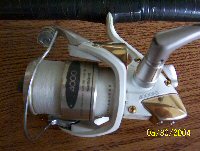 especially like the Stradic reels that Shimano makes. All Stradic’s are made
with 5 ball bearings and have proven over the years to be the smoothest most
dependable reels I have ever owned. I use the Stradic 4000 which has a
5.7:1 gear ratio on my soft plastic jerk bait rods. I spool one with 10 pound
test P-Line and the other with 8/20 Berkley Fireline.
especially like the Stradic reels that Shimano makes. All Stradic’s are made
with 5 ball bearings and have proven over the years to be the smoothest most
dependable reels I have ever owned. I use the Stradic 4000 which has a
5.7:1 gear ratio on my soft plastic jerk bait rods. I spool one with 10 pound
test P-Line and the other with 8/20 Berkley Fireline.
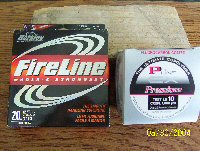 The
reason for 2 different lines is this (1) Fireline: The Stradic
4000 will handle up to 12lb test mono line very easily-over that I believe the
performance of the reel drops of rapidly. There are times when I need more
line strength and sensitivity. When I’m fishing boat docks and heavier cover
many times I can’t see the bait. I need a line that is super sensitive and
has zero stretch, that’s the reason for the Fireline. I can spool up with 8 lb
diameter line but have 20 lb test strength. I have also found that a
Prowler Pro Soft Shad will fall much slower on Fireline, and there are times
that this is a big plus. (2) P-Line 10 lb mono: First of all let me say
that P-Line is limp but very tough and is one of the most abrasion proof mono
lines that I have ever used. I use the P-Line when fishing the Soft Shad
around bridge pilings-grass beds with little heavy cover and rip rap areas
where I can keep good eye contact with the bait. Where the braided line helps
the bait fall slower-the P-line let’s it fall faster and once again there are
times when this works much better for me.
The
reason for 2 different lines is this (1) Fireline: The Stradic
4000 will handle up to 12lb test mono line very easily-over that I believe the
performance of the reel drops of rapidly. There are times when I need more
line strength and sensitivity. When I’m fishing boat docks and heavier cover
many times I can’t see the bait. I need a line that is super sensitive and
has zero stretch, that’s the reason for the Fireline. I can spool up with 8 lb
diameter line but have 20 lb test strength. I have also found that a
Prowler Pro Soft Shad will fall much slower on Fireline, and there are times
that this is a big plus. (2) P-Line 10 lb mono: First of all let me say
that P-Line is limp but very tough and is one of the most abrasion proof mono
lines that I have ever used. I use the P-Line when fishing the Soft Shad
around bridge pilings-grass beds with little heavy cover and rip rap areas
where I can keep good eye contact with the bait. Where the braided line helps
the bait fall slower-the P-line let’s it fall faster and once again there are
times when this works much better for me.
Hooks:
When it comes to hook selection I keep it very
simple. I prefer either a #4 or a #5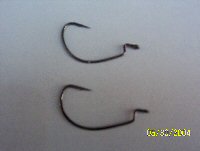 Owner Wide Gap hook. These hooks are super strong and you will never have to
worry about having one get straightened out by a big fish. For those of you
that have other big species of fish like Stripers in your lake these hooks
will solve your problem. Your line will break before these will bend.
Not only are they strong but they have a 3 sided cutting point that gives you
great hook ups. The reason for the 2 sizes is simple-the #4 weighs less than
the #5 and is what I use when I’m fishing the Soft Shad in a slower falling
presentation. The #5 on the other hand weighs more and I use this when
the fall is faster.
Owner Wide Gap hook. These hooks are super strong and you will never have to
worry about having one get straightened out by a big fish. For those of you
that have other big species of fish like Stripers in your lake these hooks
will solve your problem. Your line will break before these will bend.
Not only are they strong but they have a 3 sided cutting point that gives you
great hook ups. The reason for the 2 sizes is simple-the #4 weighs less than
the #5 and is what I use when I’m fishing the Soft Shad in a slower falling
presentation. The #5 on the other hand weighs more and I use this when
the fall is faster.
Prowler Pro Soft Shad Colors: Just like
plastic worm and lizards Prowler manufactures the Pro Soft Shad in many
different colors . They are currently available in 11 different colors
some solid and some with glitter. But once again I keep my color selection
very simple. 80% of all the fish I catch on a Soft Shad are caught on
Pearl White. The other 20% are caught on either a Bubblegum or Lemon Shad. I
keep an abundance of these in my boat and will have to restock several times
through the year. Are
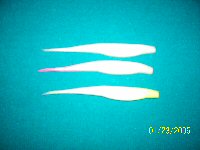 there other
colors that might work just as well? YES!!!!!! I’m sure there
are-BUT-these sure work for me day in and day out!
there other
colors that might work just as well? YES!!!!!! I’m sure there
are-BUT-these sure work for me day in and day out!
Changing
Or Adding Color To The Pro Soft Shad: There are
times that I will “ADD
COLOR” to a Pearl White Soft Shad. When this happens it is normally Red
or Chartreuse. I use JJ's Magic
www.jjsmagic.com to color the Soft
Shad in 3 different ways. (1) I take a cotton q-tip dipped in the dye and
color the slit in the belly (2) Dip just the head about ½ an inch down (3)
Dip the tail about ½ inch down. I can’t always explain it but there are times
that red and chartreuse will drive Largemouth and Smallmouth nuts. After using
the red or chartreuse I dip as much of the bait in the "Clear JJ's" as
possible . You may have a different color combo that will for you ….but
once again this sure works for me.
“ADD
COLOR” to a Pearl White Soft Shad. When this happens it is normally Red
or Chartreuse. I use JJ's Magic
www.jjsmagic.com to color the Soft
Shad in 3 different ways. (1) I take a cotton q-tip dipped in the dye and
color the slit in the belly (2) Dip just the head about ½ an inch down (3)
Dip the tail about ½ inch down. I can’t always explain it but there are times
that red and chartreuse will drive Largemouth and Smallmouth nuts. After using
the red or chartreuse I dip as much of the bait in the "Clear JJ's" as
possible . You may have a different color combo that will for you ….but
once again this sure works for me.
Adding a Good Quality Snap: Another
change that can make a big difference at times, is adding a good snap to your
line. I always use a #3 Fast lock Snap. I’m a firm believer that by adding the
snap you increase the side to side action of any soft plastic jerk bait. I
have also found that the snap will add a little extra weight but will not make
the Pro Soft Shad “Nose Dive” when it falls. But please let me warn you “Don’t
Get Cheap” buy good snaps, the difference is only a few pennies-but will
payoff in bigger dividends.
Areas
To Fish A Prowler Pro Soft Shad
In this section we will discuss the following areas that pay off
for me when fishing a Pro Soft Shad. (1) Bridge Pilings (2) Shallow Grass Beds
(3) Deep Grass Beds (4) Boat Houses/Boat Docks (5) Rip Rap Areas and (6)
Lay downs/Timber On Expansive Flats .
Bridge Pilings: I believe that bridge pilings
whether they are a main river channel bridges or a secondary creek bridge are
over looked by many fishermen today. Most bridges support a variety of
baitfish-crayfish-bluegill-crappie and other game fish as well. A literal
smorgasbord for hungry bass. I have had some great trips on different
lakes catching bass after bass running from one bridge area to another through
the course of the day. To help us understand bridge pilings a little
better let’s break this explanation down into 2 parts (1)
 Open Pilings: most
of these types of pilings will have a shelf you cannot see that connects the
columns that support the bridge. If the bass are in this area most likely they
will be on or near this shelf. When fishing a Pro Soft Shad in current I try
to put my boat upstream from the pilings and cast downstream, by doing this
you will maintain better lure control. Many times you will find the current to
be stronger toward the river channel and less as you progress toward the bank.
Be sure to work all 4 sides of each piling and the shelf that connects them.
At times the hit on top will be fantastic-other times it may take letting the
bait “Dead Stick” around the pilings-always watch your line for the bass to
hit your bait on the fall. (2) Solid Pilings: Most of the time shorter
bridges that cross various creeks that feed the main lake will have this type
of pilling only. One attribute that a small bridge has that larger ones don’t
(because of its height) is that it provides more shade to the structure
directly below the bridge. Most of these will have some degree of current and
always seem to have baitfish in some quantities around them. When fishing this
type of bridge and pilings concentrate on all 4 corner of the bank under the
bridge-the corners on the piling and make repeated casts directly parallel
down the entire length of the piling. Work the Pro Soft Shad much the same as
we discussed above.
Open Pilings: most
of these types of pilings will have a shelf you cannot see that connects the
columns that support the bridge. If the bass are in this area most likely they
will be on or near this shelf. When fishing a Pro Soft Shad in current I try
to put my boat upstream from the pilings and cast downstream, by doing this
you will maintain better lure control. Many times you will find the current to
be stronger toward the river channel and less as you progress toward the bank.
Be sure to work all 4 sides of each piling and the shelf that connects them.
At times the hit on top will be fantastic-other times it may take letting the
bait “Dead Stick” around the pilings-always watch your line for the bass to
hit your bait on the fall. (2) Solid Pilings: Most of the time shorter
bridges that cross various creeks that feed the main lake will have this type
of pilling only. One attribute that a small bridge has that larger ones don’t
(because of its height) is that it provides more shade to the structure
directly below the bridge. Most of these will have some degree of current and
always seem to have baitfish in some quantities around them. When fishing this
type of bridge and pilings concentrate on all 4 corner of the bank under the
bridge-the corners on the piling and make repeated casts directly parallel
down the entire length of the piling. Work the Pro Soft Shad much the same as
we discussed above.
Shallow
Grass Beds:
Grass has a way of holding bass. Even some of
the shallowest beds when fished early or late in the day can hold big numbers
and great quality fish. I’m speaking of depths from 1 foot to 5 feet deep.
Some of the grass you can see-some you can’t. If you are fortunate
enough to be on the lake when it is overcast and dreary the bite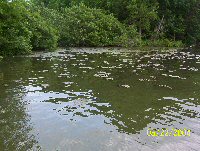 can last all day long in these shallow areas. The most important factor is
finding out where the bass are holding within the grass. For instance I have
noticed if you have a strong wind blowing directly into the grass the fish
seem to be more on the deepest outside edges of the grass beds. If it is calm
they can be scattered anywhere from the bank in zero feet of water to the far
outside edges. Many grass beds will have an open area (no grass) from the bank
out several feet before the growth begins. These areas can hold large
quantities of fish, early and late in the day and on stormy overcast
conditions. When the bass are in this area I like to throw the Pro Soft Shad
all the way up on the bank or sea wall and start from there….be ready the
strike can happen very quickly.
can last all day long in these shallow areas. The most important factor is
finding out where the bass are holding within the grass. For instance I have
noticed if you have a strong wind blowing directly into the grass the fish
seem to be more on the deepest outside edges of the grass beds. If it is calm
they can be scattered anywhere from the bank in zero feet of water to the far
outside edges. Many grass beds will have an open area (no grass) from the bank
out several feet before the growth begins. These areas can hold large
quantities of fish, early and late in the day and on stormy overcast
conditions. When the bass are in this area I like to throw the Pro Soft Shad
all the way up on the bank or sea wall and start from there….be ready the
strike can happen very quickly.
Deeper Grass Beds: Many times grass
beds that are adjacent to the main river channels will provide visible surface
vegetation on the channel edges or flats. But there may also be an abundance
of grass that will extend out further that you will not be able to see
visually. The visible grass can provide (as we just discussed in the
paragraph above) fantastic action under certain circumstances. But when the
day is bright and sunny these areas can die off quickly. This is when you need
to keep your boat positioned in the river channel just far enough away where
you can make a good long cast to the shallow water. Let your Pro Soft Shad
drop down gradually along the outside edges of the vegetation. At times I will
work it much like a worm probing all depths until we locate fish.
Sometimes the bass will strike on the fall-other times it will be when you
move or twitch the bait.
Boat Houses/Boat Docks: First let me say there is a
vast difference between a “Boat House” and a “Boat Dock”. Normally, boat
docks will have a walk way that varies in width, length and configuration.
Some times it will have a roof-other times not. A boat house on the
other hand is always covered and can be rather large “Garage Looking”
structure enclosed on at least 3 sides and many times all four. I have seen
boat houses that had as many as 6 slips in them.
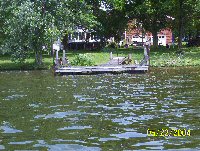 Although
these 2 structures look entirely different they do share some things in
common. Most of these will have some type of cable or strap that
attaches to the sides of the dock and then to the shore. Some will have a
“Boat Lift” system in the slip that has runners or straps that are used to
left the boat up out of the
Although
these 2 structures look entirely different they do share some things in
common. Most of these will have some type of cable or strap that
attaches to the sides of the dock and then to the shore. Some will have a
“Boat Lift” system in the slip that has runners or straps that are used to
left the boat up out of the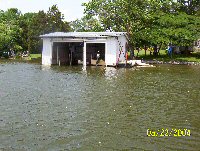 water. Some will have smaller attached jet ski platforms that will be attached
to the side of the dock. Also many of these will have sunken brush piles that
the dock owner has placed there to attract fish to his dock. If you’re fishing
a new area that has docks watch for floodlights-fishing pole holders-rods and
chairs-all of these can help you locate brush around docks. Also remember that
most of these sunken piles will be within a short cast from the dock.
There are other similarities but they all add up to the same thing-potential
holding places for bass.
water. Some will have smaller attached jet ski platforms that will be attached
to the side of the dock. Also many of these will have sunken brush piles that
the dock owner has placed there to attract fish to his dock. If you’re fishing
a new area that has docks watch for floodlights-fishing pole holders-rods and
chairs-all of these can help you locate brush around docks. Also remember that
most of these sunken piles will be within a short cast from the dock.
There are other similarities but they all add up to the same thing-potential
holding places for bass.
Let Me Say This Before We
Go Any Further. Always Pay Total Respect To Others. Remember The Dock Or Boat
House Is Someone Else’s Property- Act Accordingly.
Many people view cables-boat lift systems and jet ski platforms as
obstacles to their fishing. So consequently all they fish is both sides and
the front and then move on. What has happened at this point is they have
fished only 30% or less of the structure leaving 70% totally untouched.
I try to skip my
Pro Soft Shad in-between every opening-under every boat lifted out of the
water. In-between moored boat in the water and the sides of the dock. I work
my way around and skip the bait on the backside of the dock between the dock
and the shore. I like to pull right up to the cables that hold the boat house
or dock touching it lightly with my trolling motor and skip the Soft Shad into
every concealed area as possible. If you’re working Boat Houses that provide a
lot of shade you will need to skip the bait as far back into the structure as
possible. Always watch your line because your Soft Shad will be out of
your eye sight.
I remember
a trip I had on Lake Bruin in Louisiana a couple years ago with my oldest son
Rick Jr. and TBGI’s Mike Dial. The bass had moved all the way under
boats lifted out of the water. These boat house bass were holding right on the
bank. We would skip our baits at least 18 to 20 feet back into the boathouse
and the bass would hammer the bait. Time after time we lifted 3lb to 5lb plus
largemouth over the rail that was holding on this pattern.
If you are fishing
the brush around the dock and it is sunny and bright you may have to let the
Pro Soft Shad sink down into the brush making contact and work it much like
you would a worm. If it is overcast the bass will tend to hold more to the
area between the brush and the dock. When this happens many times you can have
terrific blow ups on the bait. Just some friendly advice-work these
areas slowly-carefully and be ready to set the hook at anytime.
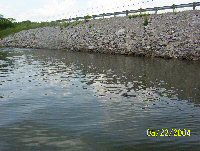 Rip
Rap Areas: Let me say right up-front “I like to Fish these areas! This is
one of my favorite types of structure to fish with a variety of baits
including a Pro Soft Shad. These areas will hold a variety of
baitfish-sunfish and crayfish all year long. There are times when bass-good
bass will hold so close to the rip rap you will wonder why you can’t see their
fins, but they won’t chase a bait. If you stay out away from the bank and
throw in you might catch one every now and then. When this happens your best
bet is to parallel the rocks so closely that you literally could step out of
the boat. Make good long casts and keep your bait within inches of the
shore line. Don’t get in a hurry-when you catch a fish stop your forward
movement and make repeated casts in the same area-chances are there will be
another fish there.
Rip
Rap Areas: Let me say right up-front “I like to Fish these areas! This is
one of my favorite types of structure to fish with a variety of baits
including a Pro Soft Shad. These areas will hold a variety of
baitfish-sunfish and crayfish all year long. There are times when bass-good
bass will hold so close to the rip rap you will wonder why you can’t see their
fins, but they won’t chase a bait. If you stay out away from the bank and
throw in you might catch one every now and then. When this happens your best
bet is to parallel the rocks so closely that you literally could step out of
the boat. Make good long casts and keep your bait within inches of the
shore line. Don’t get in a hurry-when you catch a fish stop your forward
movement and make repeated casts in the same area-chances are there will be
another fish there.
If you are fishing
rip rap that has irregular features such as points-big cracks-logs and sunken
brush you will want to key on these areas and make repeated casts. BE
PATIENT!!! I have spent several hours fishing the same stretch of rip rap
when bait fish are active and caught fish after fish. You may have to
sort through some smaller fish at times but there are always good fish mixed
in.
Lay Down Timber
On Flats: I realize that this might change from lake to lake but here in
middle Tennessee we have many lakes that have expansive flats that are located
close to deep water. These flats will have a variety of vegetation, rock piles
and lay down timber. Some of this timber will float in and out with high
water conditions but much of it remains all the time. Most of these flats
will have an abundance of logs against the bank and some will have vegetation
around it-which is a bonus!
Something else to
keep in mind when fishing flats is to be on the look out for isolated timber.
If the concentration of timber is large enough it can hold several bass not
just one or two. Don’t rush in on these areas be stealthy in your approach and
make every cast count.
A couple years ago in
June-July and August when it was so hot that you would have to either
pour water on your head or put you hat in the water just to cool off.
TBGI’s Jon Simmons and I caught several hundred bass with clients on flats
much like what I described above. We had to be very careful not to get
to close to the logs because we would kick up mud with our trolling motor. We
would zero in on our target and make long cast. We keyed on every log-grass
bed and weed line we could see. At times you couldn’t move the bait fast
enough and other times it would take a jerk and fall presentation. Like we
have all heard before “The Bass Will Tell You What They Want”!
Rigging And Fishing The
Prowler Pro Soft Shad
In this section we will talk about 3 different methods to rig a
Soft Shad and some basic techniques on fishing it.
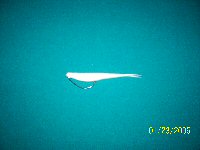 Texas
Style Rigging: This method is very easy. Hold the Soft
Shad in one hand with the slit in the belly facing you. Insert the point
of the hook into the blunt end of the bait, bring the point out about half way
from the tip of the bait and the beginning of the slit. Push the Soft Shad up
the hook and over the bend, when this is done rotate it 90 degrees until the
point of the hook is facing the belly slit. While holding the hook push the
bait forward slightly then insert the point of the hook into and through the
Soft Shad until the point is barely exposed. This method will keep you from
getting hung up in wood and grass. After a few casts and always after every
strike you will want to check you rigging out. There is nothing more
aggravating than being on fish in a small area and then getting hung up right
in the middle of it.
Texas
Style Rigging: This method is very easy. Hold the Soft
Shad in one hand with the slit in the belly facing you. Insert the point
of the hook into the blunt end of the bait, bring the point out about half way
from the tip of the bait and the beginning of the slit. Push the Soft Shad up
the hook and over the bend, when this is done rotate it 90 degrees until the
point of the hook is facing the belly slit. While holding the hook push the
bait forward slightly then insert the point of the hook into and through the
Soft Shad until the point is barely exposed. This method will keep you from
getting hung up in wood and grass. After a few casts and always after every
strike you will want to check you rigging out. There is nothing more
aggravating than being on fish in a small area and then getting hung up right
in the middle of it.
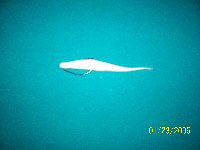 Up
Side Down Exposed Texas Rigging: There maybe times when you can get
away with this
method. The Soft Shad is rigged the exact same way with the exception that the
bait is turned upside down and the hook is left exposed outside of the
bait. I fish a Pro Soft Shad at times along rip rap areas and bridge
pilings when there is an absence of logs and grass. By rigging this way the
action of the bait become more erratic.
Up
Side Down Exposed Texas Rigging: There maybe times when you can get
away with this
method. The Soft Shad is rigged the exact same way with the exception that the
bait is turned upside down and the hook is left exposed outside of the
bait. I fish a Pro Soft Shad at times along rip rap areas and bridge
pilings when there is an absence of logs and grass. By rigging this way the
action of the bait become more erratic.
Wacky Style
Rigging: The first time I saw a soft jerk bait fished this way was a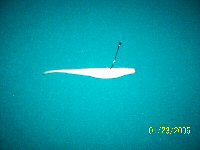 several years ago with a client I had out. When I told him we were going to
fish a soft plastic jerk bait and asked him if he knew how to rig it. He
replied yes and I didn’t think any more about it. When we began fishing at our
first stop I watched him catch 5 largemouth in a row using this method. It
doesn’t take me long to catch on so I rigged mine the same way and began to
catch fish as well. There are times this method works well. My only word of
caution is, this method IS NOT WEEDLESS in any manner shape or form. It
needs to be used in selected situations.
several years ago with a client I had out. When I told him we were going to
fish a soft plastic jerk bait and asked him if he knew how to rig it. He
replied yes and I didn’t think any more about it. When we began fishing at our
first stop I watched him catch 5 largemouth in a row using this method. It
doesn’t take me long to catch on so I rigged mine the same way and began to
catch fish as well. There are times this method works well. My only word of
caution is, this method IS NOT WEEDLESS in any manner shape or form. It
needs to be used in selected situations.
Fishing
A Prowler Pro Soft Shad 101: First take a look at a Soft Shad. What is
it suppose to look like or represent when in the water? A shad…it is suppose
to look like a shad. I guess in my life time I have spent several
thousands of hours on the water. And through the years I have watched shad
dart and dive in a frenzy as they were dying. I have also watched them
sink ever so slowly straight down until they were completely out of sight.
This is my 2 basic
retrieves that I want to emulate on a normal basis when fishing a Pro Soft
Shad. At times I want the bait to dart and dive quickly from side to side as
if it was hurt and trying to get away from a bass. There are times that I want
the same motion but at a reduced speed. And then there are times that I just
“Dead Stick” the bait and let it fall or settle down out of my sight.
Conclusion
Once again the
truth is “The Bass Will Let You Know” what they want. Experiment-go to the
lake and stand on a pier at a boat ramp and practice these retrieves.
Use your neighbors swimming pool when their not watching. Watch how the bait
responds rigged in the different styles that I listed above. Watch what a
difference it makes throwing a Pro Soft Shad on Fireline and then mono. Check
out some of the structure on your lake that I described above.
I hope this helps you to have a better insight into fishing a fun bait..the
Prowler Pro Soft Shad. As you fish them be sure to log onto my web site
www.tennesseebassguides.com
go to the “FISH REPORT TAB” and give us an update on how you did…or if you
have questions ask them there and I will respond to them.
As
always our goal is to be “THE” Bass Information Center in middle
Tennessee-thanks for taking time to read this article..Rick McFerrin
Cold Weather Injuries
Signs And Symptom's You Need
To Know
Written By:
Timothy Mason
www.tennesseebassguides.com
November 2005
Introduction
At
times we fishermen get so excited about going to the lake we forget to dress
properly and skip many small details that could help us from sustaining cold
weather injuries. I'm not a doctor but I am knowledgeable in the area of
Cold Weather Injuries. Yes like many outdoorsmen I had to learn it the hard
way as a young private in the United States Army where I fell victim to
severe frostbite. As a guide I always pay close attention to my friends and
clients during the winter months and I hope you will get some good
information from this article that will help you in the outdoors this
winter.
Signs And
Symptom's
Exposure to cold can lead to both (A) Frost Bite: Where your skin freezes
(B) Hypothermia: Where your core body temperature drops below normal. Both
of these conditions may start out with mild symptoms, but can worsen quickly
to a life or limb threatening situation. Frost Bite normally occurs
when you are outdoors, but Hypothermia can can not only outdoors but inside
as well. Lets look at these two a little closer.
Frost
Bite
First
you need to understand that Frost Bite is the freezing of the skin or
underlying tissue that occurs as a result of prolonged exposure to cold. Wet
clothes, high winds, poor circulation caused by tight clothing and boots,
cramped position, fatigue, certain medications, smoking, alcohol and
diabetes can all contribute to this injury. Skin becomes pale or blue and
stiff or rubbery to the touch. You will also have a numbing sensation that
can progress into 3 degrees of severity.
-
First Degree Is Frost Nip: Numbness and whitening of the skin,
blistering if not reversed quickly.
-
Second Degree Is Superficial Frost Bite: Outer skin feels hard and
frozen, blistering likely.
-
Third Degree Is Deep Frost Bite: Underneath skin becomes hard and very
cold
Frost
bite is most common on fingers, toes, earlobes, noses and cheeks on your
face. Prevention is simple. Stay dry and out of the wing in extreme cold.
Make sure all areas of your skin is covered. Keep your core body temperature
up by wearing layers of clothing. Wool and polypropylene are good
insulators. Wear wind and waterproof outer clothing and a head covering to
keep heat loss from occurring. Wear mittens rather than gloves. Keep
protective clothing and blankets in your car. Don't smoke or drink
when it is extremely cold.
First Aid For
Frostbite
If
the victim is mildly frostbitten, give first aid and get medical help
quickly. If the victims is more than mildly frostbitten call EMS. If the
victim has both Frost Bite and Hypothermia (which we will cover next) give
first aid for hypothermia first.
Don't
-
Don't thaw out a frostbitten area if you can't keep it thawed.
-
Don't direct heat from a radiator, campfire, heating pad or hair dryer
to the frostbitten area.
-
Don't disturb or break blisters. Don't massage the frost bitten area.
-
Don't move thawed areas any more than necessary.
Do's
-
Move victim to a warmer place and remove any restricting clothing or
jewelry
-
Warm the frostbitten area for at least 30 minutes
-
Hand and feet can be placed in warm water 100 to 105 degrees
-
Keep circulating the water to aid in the warming process.
-
Other areas can be warmed by applying warm compresses
-
Stay with victim until Professional Medical help arrives
Burning pain, swelling and color changes may occur during this warming
period. When completed the skin should be soft and sensation should have
returned. At this point you can apply sterile dressing between fingers or
toes. Wrapping prevents refreezing.
Hypothermia
Hypothermia occurs when the body temperature drops below normal. It occurs
when the body loses heat faster than it can be produced. Factors that
contribute to hypothermia include extreme cold, wet clothes, being in cold
water, spending long periods in a cold environment or unheated room.
Hypothermia can happen at temperatures of 45 degrees or higher if wet or in
high winds. Those who are most likely to have hypothermia are babies,
elderly, people with poor circulation, people that smoke and consume
alcohol, people with diabetes. This can happen to fail or inactive people
even in doors if not dressed properly. Hikers, fishermen and skiers can
loose heat rapidly without realizing it. Signs of hypothermia are.
-
Mild Hypothermia: Shivering, urge to urinate, loss of coordination,
confusing and arm pits are cold.
-
Severe Hypothermia: No shivering, stumbling, muscle stiffness, irregular
slow heat beat, drowsiness, weakness confusion, slurred speech,
difficulty seeing irrational behavior.
-
Can progress to ridged mussels, unconsciousness, coma and cardiac
arrest. Body heat may drop below 96 degrees.
Prevention
Dress warmly and wear waterproof clothing. Wear fabric that
remains warm even when it is wet such as wool or polypropylene. Wear a hat,
move to shelter if you get wet or cold. Eat well before going out and carry
extra food. Don't drink alcohol. Older less active people can prevent indoor
hypothermia by dressing warmly and keeping temperatures above 65 degrees.
First Aid
If
victim has mild hypothermia give first aid and get professional medical help
quickly. If victim is both frost bitten and has hypothermia give first
aid for hypothermia first.
Don't
-
Don't assume that someone found lying still in the cold is dead.
-
Don't use your own comfort to decide if an area is warm enough. People
respond differently.
-
Don't attempt to warm a severely hypothermic person without
professional medical help.
-
Don't use direct heat to warm the victim
Do's
-
Do check for open airways breathing and circulation.
-
Do Begin CPR if breathing rate is less than 6 breaths per minute.
-
Do control bleeding if present.
-
Do Handle victim gently. People with hypothermia are subject to cardiac
arrest.
-
Do keep the victim from getting any colder by seeking shelter and
removing wet clothes.
-
Warm victim by using blankets or aluminum foil.
-
Use your body heat in this process if necessary.
-
Stay with victim and call for professional medical help
Conclusion
I
hope this article will help and give you additional information you would
need in case of an emergency. I'm not a doctor or a medical person, I'm a
guide that spend countless hours fishing in cold weather. Take time to
RESEARCH Frost Bite and Hypothermia on the internet by going to the Red
Cross web site or other authoritative Medical Sites. If fishing alone always
let some one at the ramp or marina know where you will be at. Take your cell
phone and wear your life vests at all times. When possible don't fish by
your self take a friend along. Once again I hope this will help you. God
Bless and may He keep you safe. Timothy Mason Guide
www.tennesseebassguides.com
Tip's For The Beginner
Crank You Way To Fall Success
September 2005
Written By: Rick McFerrin
www.tennesseebassguides.com
Introduction
Recently I wrote a brief article entitled
Late Summer/Early Fall Transition Period that you can read by clicking on
the Tips Archive tab of our web site
www.tennesseebassguides.com.
In this article I tried to give you a good understanding of how water
temperature relates to triggering the fall transition process. It might help
you to read that article first before finishing this one. The "Fall
Transition" of Largemouth, Smallmouth and Spotted Bass just doesn't happen
overnight. It's not like you turn a switch on or off and magically it's
happened. Rather, the length of this process is almost totally
dependent on mother nature. How quickly the water temperature changes is the
key to this process. And during this change you will find bass holding in
different patterns in different parts of the lake.
Under normal conditions the upper regions
of the lake will be the first to experience that "Right Drop In Water
Temperature" that will propel bass into their Fall patterns. And depending
on how large the lake is, bass in the middle portion of the lake might still
be holding in "Late Summer Patterns" while bass further toward to lower end
may not even be at that stage yet. Faced with these multiple patterns and
changing water temperatures one of the best search baits I know of that can
help you probe various water depths and help you cover as much water
as possible is a crankbait. In the paragraphs below I want to share with you
several different baits that I use and why I use them. My hope is that this
information will help you crank your way to success this fall.
Deep Crankbaits
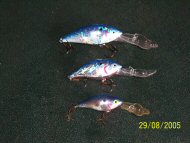 Let's start
with the deepest pattern fish and work our way on up. These would be
the bass that more than likely would be in the lower region on up to mid
lake during the late summer/early fall period. The water temperature that
these bass a
Let's start
with the deepest pattern fish and work our way on up. These would be
the bass that more than likely would be in the lower region on up to mid
lake during the late summer/early fall period. The water temperature that
these bass a re
holding in would still be more or less the warmest portion in the
lake. These fish may be holding on points that gradually get deeper as they
extend out into the lake, or ledges that offers semi shallow water on
it's crest then suddenly drops off into deep water at the main channel.
Depending on your type of lake they may be holding along old flooded river
channel bends that still have stumps and rock. Many times these ledges will
also have allot of sand and slit. But the one factor that always has to be
there to make it a productive place is "Structure". My favorite
crankbait to probe structure for these deep water bass is a Luhr-Jensen Hot
Lips in one of three sizes.
www.luhrjensen.com In the picture to the left the top bait is the 3/4
model, the middle bait is the 1/2 model and the bottom bait is the 1/4 size.
On 10lb test the 3/4 model will run 18-24 feet deep, the 1/2 model will run
15-18 feet deep and the 1/4 model will run 12-16 feet deep. I like the way
these baits "Dive" straight down immediately. Much of this can be attributed
to the Deep Dive Tri-Lobe Power Lip and it's computerized thin wall
construction. These baits offer fantastic vibration and track
incredibly straight. To get the most from these baits I use two different
All Pro APX series rods.
www.allpro.com The first is model number APX80HCA. This is a heavy
action 8 foot casting rod with a forgiving tip that is absolutely fantastic
for throwing big deep diving crankbaits like the 3/4 and 1/2 Hot Lips. If
you have ever thrown a big deep bait like these on a rod that wasn't suited
for this technique you are well aware of how tired your arms and wrists can
get. Having the right rod makes a tremendous difference. The second is the
APXCS7MHCA. This is a 7 foot medium heavy casting crankin rod that is ideal
for the 1/4 model Hot Lips. All APX rods have unmatched sensitivity that is
transmitted through the graphic rings on the handle that will allow you to
feel every piece of structure that you pull these Hot Lips over. This is an
important ingredient that I can't emphasize enough. You need to be able to
feel the Hot Lips beating and banging it's way through-around and on the
structure you are fishing looking for a reaction strike. When you catch a
bass work that area completely, many times there will be several holding on
the same piece of structure. Using my electronics I always like to start on
the shallow part of the point or ledge and work my way out to the deeper
water varying my retrieve as I work my way along. Color selection is
something that you will have to experiment with. I always lean toward a shad
colored bait when I can, but other colors can be just as deadly. Lure Jensen
makes the three Hot Lips models in over 40 colors that can help you match
your water color needs.
re
holding in would still be more or less the warmest portion in the
lake. These fish may be holding on points that gradually get deeper as they
extend out into the lake, or ledges that offers semi shallow water on
it's crest then suddenly drops off into deep water at the main channel.
Depending on your type of lake they may be holding along old flooded river
channel bends that still have stumps and rock. Many times these ledges will
also have allot of sand and slit. But the one factor that always has to be
there to make it a productive place is "Structure". My favorite
crankbait to probe structure for these deep water bass is a Luhr-Jensen Hot
Lips in one of three sizes.
www.luhrjensen.com In the picture to the left the top bait is the 3/4
model, the middle bait is the 1/2 model and the bottom bait is the 1/4 size.
On 10lb test the 3/4 model will run 18-24 feet deep, the 1/2 model will run
15-18 feet deep and the 1/4 model will run 12-16 feet deep. I like the way
these baits "Dive" straight down immediately. Much of this can be attributed
to the Deep Dive Tri-Lobe Power Lip and it's computerized thin wall
construction. These baits offer fantastic vibration and track
incredibly straight. To get the most from these baits I use two different
All Pro APX series rods.
www.allpro.com The first is model number APX80HCA. This is a heavy
action 8 foot casting rod with a forgiving tip that is absolutely fantastic
for throwing big deep diving crankbaits like the 3/4 and 1/2 Hot Lips. If
you have ever thrown a big deep bait like these on a rod that wasn't suited
for this technique you are well aware of how tired your arms and wrists can
get. Having the right rod makes a tremendous difference. The second is the
APXCS7MHCA. This is a 7 foot medium heavy casting crankin rod that is ideal
for the 1/4 model Hot Lips. All APX rods have unmatched sensitivity that is
transmitted through the graphic rings on the handle that will allow you to
feel every piece of structure that you pull these Hot Lips over. This is an
important ingredient that I can't emphasize enough. You need to be able to
feel the Hot Lips beating and banging it's way through-around and on the
structure you are fishing looking for a reaction strike. When you catch a
bass work that area completely, many times there will be several holding on
the same piece of structure. Using my electronics I always like to start on
the shallow part of the point or ledge and work my way out to the deeper
water varying my retrieve as I work my way along. Color selection is
something that you will have to experiment with. I always lean toward a shad
colored bait when I can, but other colors can be just as deadly. Lure Jensen
makes the three Hot Lips models in over 40 colors that can help you match
your water color needs.
Medium Depth Crankbait
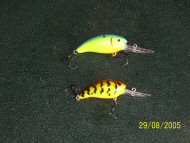
 Under
normal conditions as the water temperature begins to cool the bass will
begin to move to and stay around shallower structure. Instead of the 20-30
foot plus water they may migrate to the 10-15 foot range. This migration is
what I call a Pre-Fall which is that short window of time between late
summer and early fall. This may happen in the same geographical areas of the
lake that you found summer pattern bass. The only difference is the bass
just move up shallower on the points or will hold on structure nearer to the
crest of a ledge or channel bend. Remember I said we were dependent upon
Mother Nature? A good example of this is early Fall rains and cold fronts.
When the rains and cold fronts come 9 times out of 10 it will cause
the bait fish to move further back into the creeks and pockets and what's
the next step? Your Right! The bass will follow right along taking up
residency around the shallower structure that lines the creek channels
waiting to gulp down bait fish as they swim by or chase bait out in open
water. When this happens I turn to the Luhr-Jensen Radar 10 and Radar 13
crankbaits. These are super tough baits that you can beat and bang through
some of the heaviest structure and they will just keep running true.
They cast like a bullet and have a tight vibration that not only is
appealing to feeding fish but will entice a reaction strike as well.
I have a tendency to keep my crankbaits moving right along when fishing
around allot of bait fish. The reason is I don't want the bass to have a
chance at a real close look and be able to determine that it isn't real.
During this time of the year I always have at least two sometimes three
Radars tied on at the same time, some on 8lb test and others on 10lb test.
Colors once again is something that you may have to experiment with (20
colors to choose from) but I always will have a shad color of some sort tied
on. I use the following All Pro APX rods when throwing these baits. First is
the 7 foot crankin rod APXCS7MHCA that we talked about above and the
other is the APX7MST 7 foot medium spinning rod. The APX 7 foot
spinning rod is a beauty. It's extremely light (in weight) unbelievably
strong and ultra sensitive. These rods are manufactured with a reel seat or
with a Tennessee handle. For those of you that might not be familiar with a
Tennessee handle....there is no reel seat-you tape your reel to the handle
where it suits you best. This gives you the ability to balance the rod
exactly as you want it. I joke with my clients that I can feel a bass
getting ready to nail a crankbait before the strike actually happens with
this rod. All joking aside these rods are phenomenal. And when you match the
APX and Radar Crankbaits together you better get the net!
Under
normal conditions as the water temperature begins to cool the bass will
begin to move to and stay around shallower structure. Instead of the 20-30
foot plus water they may migrate to the 10-15 foot range. This migration is
what I call a Pre-Fall which is that short window of time between late
summer and early fall. This may happen in the same geographical areas of the
lake that you found summer pattern bass. The only difference is the bass
just move up shallower on the points or will hold on structure nearer to the
crest of a ledge or channel bend. Remember I said we were dependent upon
Mother Nature? A good example of this is early Fall rains and cold fronts.
When the rains and cold fronts come 9 times out of 10 it will cause
the bait fish to move further back into the creeks and pockets and what's
the next step? Your Right! The bass will follow right along taking up
residency around the shallower structure that lines the creek channels
waiting to gulp down bait fish as they swim by or chase bait out in open
water. When this happens I turn to the Luhr-Jensen Radar 10 and Radar 13
crankbaits. These are super tough baits that you can beat and bang through
some of the heaviest structure and they will just keep running true.
They cast like a bullet and have a tight vibration that not only is
appealing to feeding fish but will entice a reaction strike as well.
I have a tendency to keep my crankbaits moving right along when fishing
around allot of bait fish. The reason is I don't want the bass to have a
chance at a real close look and be able to determine that it isn't real.
During this time of the year I always have at least two sometimes three
Radars tied on at the same time, some on 8lb test and others on 10lb test.
Colors once again is something that you may have to experiment with (20
colors to choose from) but I always will have a shad color of some sort tied
on. I use the following All Pro APX rods when throwing these baits. First is
the 7 foot crankin rod APXCS7MHCA that we talked about above and the
other is the APX7MST 7 foot medium spinning rod. The APX 7 foot
spinning rod is a beauty. It's extremely light (in weight) unbelievably
strong and ultra sensitive. These rods are manufactured with a reel seat or
with a Tennessee handle. For those of you that might not be familiar with a
Tennessee handle....there is no reel seat-you tape your reel to the handle
where it suits you best. This gives you the ability to balance the rod
exactly as you want it. I joke with my clients that I can feel a bass
getting ready to nail a crankbait before the strike actually happens with
this rod. All joking aside these rods are phenomenal. And when you match the
APX and Radar Crankbaits together you better get the net!
Semi-Medium/Shallow Crankbaits
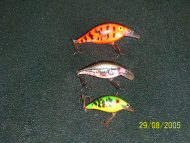 Now let's assume
that we are in a full fledge Fall pattern. The water temperature has dropped
to that "magic number" for your lake and the bass have one thing on their
mind and that's lunch! The bass have moved into the major creeks that have
plenty of cover such as standing timber-fallen logs-brush along the shore
line-maybe some grass and plenty of bait fish. The best creeks will also
have flowing water and creek channels that will bend in close to the shore
line. On some larger lakes the major creeks will also have smaller streams
that feed them as well. The mouths of these feeder streams are always a
great place to look for feeding fish. Bass at this point of the year can be
found in varying depths of water but many active feeding fish will be
shallow. Shallow water conditions anytime of the year is tailor made for the
Luhr-Jensen Speed Trap. These baits are offered in three sizes 1/16 which is
approximately 2 inches long, 1/8 which is 2 1/2 inches long and the 1/4
which is 3 inches long. The Speed Trap is one of the best shallow crankbaits
that I have ever used in my near 50 years of bass fishing. These baits have
a thin wall construction that produces the action and vibration of wood
lures but retains the consistency of an injected mold body. I have two
rods set up for fishing the Speed Traps. The first is the APX 7 foot medium
rod we discussed above with 8lb test line. The other is the same rod filled
with 6lb test line. I throw the 3/4 Speed Trap on 8lb test when I want to
reach the 8 foot level and the 1/8 and 1/16 on 6lb test for 6 foot or less.
I love throwing these baits on light line in and around shallow structure
but I have also watched huge Smallmouth in some of our clear lakes come up
from deep water to nail these small baits. What a bait! The Speed Traps are
available in more that 40 colors that will meet all your shallow crankbait
needs.
Now let's assume
that we are in a full fledge Fall pattern. The water temperature has dropped
to that "magic number" for your lake and the bass have one thing on their
mind and that's lunch! The bass have moved into the major creeks that have
plenty of cover such as standing timber-fallen logs-brush along the shore
line-maybe some grass and plenty of bait fish. The best creeks will also
have flowing water and creek channels that will bend in close to the shore
line. On some larger lakes the major creeks will also have smaller streams
that feed them as well. The mouths of these feeder streams are always a
great place to look for feeding fish. Bass at this point of the year can be
found in varying depths of water but many active feeding fish will be
shallow. Shallow water conditions anytime of the year is tailor made for the
Luhr-Jensen Speed Trap. These baits are offered in three sizes 1/16 which is
approximately 2 inches long, 1/8 which is 2 1/2 inches long and the 1/4
which is 3 inches long. The Speed Trap is one of the best shallow crankbaits
that I have ever used in my near 50 years of bass fishing. These baits have
a thin wall construction that produces the action and vibration of wood
lures but retains the consistency of an injected mold body. I have two
rods set up for fishing the Speed Traps. The first is the APX 7 foot medium
rod we discussed above with 8lb test line. The other is the same rod filled
with 6lb test line. I throw the 3/4 Speed Trap on 8lb test when I want to
reach the 8 foot level and the 1/8 and 1/16 on 6lb test for 6 foot or less.
I love throwing these baits on light line in and around shallow structure
but I have also watched huge Smallmouth in some of our clear lakes come up
from deep water to nail these small baits. What a bait! The Speed Traps are
available in more that 40 colors that will meet all your shallow crankbait
needs.
Conclusion
Let's do a quick recap. (1) Always select
a Luhr-Jensen crankbait that will run deeper than the water you are fishing.
You want the bait to be bouncing off of everything between you and the boat.
(2) Don't be fooled into believing that small crankbaits like the Speed
Traps don't catch big fish...This is a myth that is proven wrong over and
over every year. (3) Use a ultra sensitive rod like the AllPro APX series at
least 7 feet long that is designed for crankbait fishing. You will be amazed
at the additional hook ups you will have during the year. (4) Watch the
water temperature in the upper regions of your lake for the "Right Temp" (5)
Watch for bait fish movement back in the major creeks (6) Don't oversize
your line....give the crankbait the ability to work like it is designed to
do. (6) Most important "Have Fun This Fall" crankin in those bass!
Tips For The Beginner
Late Summer/Early Fall Transition
Period
August 2005
Written By: Rick McFerrin
www.tennesseebassguides.com
This isn’t
intended to be an exhaustive article but rather one that will hopefully give
you something to think about as we head into the early fall transition
period. I don’t know how the weather has been in your part of the world this
summer, but here in Middle Tennessee it has been Hot! Like I tell everyone,
I’m 57 years old I sure don’t want to wish any days away, but I must admit
I’m looking forward to some cooler temperatures and the fall fishing season.
One of these days soon the leaves will
turn brown, red and yellow and will begin to fall. Those incredibly crisp
mornings will creep up on us. You know the ones where jeans and a
sweatshirt will replace shorts a thin t-shirt. Man that’s going to
great. But if you’re a bass fisherman other than a change in your physical
comfort what will that mean to you? How does this time of the year differ?
Or how is this time of the year similar to other seasonal changes? I hope
that some of the information below will help you to be successful in this
time of the year.
What Is Going On This Time Of The Year Anyway?
I guess when
you use the term seasonal, most people will automatically think
Spring-Summer-Fall and winter. In allot of respects they would be correct.
But to us bass fishermen we know that it go’s much deeper than that. Spring
has to broken down into three segments or patterns (1) Pre-Spawn (2) Spawn
(3) Post Spawn. And the truth is in most larger lakes each of these
three patterns can overlap somewhere all at the same time. For
example. One of the lakes I guide full time here in Tennessee is Old
Hickory. It is a very large river lake that stretches well over 60 miles.
During the spring you can actually fish each one of these patterns somewhere
in that 60 mile stretch as I said, all at the same time. It’s not unusual to
have spawning fish in the upper end and pre-spawn fish in the middle and
lower sections of the lake. Then post spawn fish in the upper end and
spawning fish in the middle, see where I’m going? The same is true with
late summer early fall patterns. These developing patterns may not be as
radical because we normally won’t have the huge swings in air and water
temperatures in the fall as we do in the spring. But there are a lot of
similarities. Let’s take a look at a few of these.
Late Summer/Early Fall Water Temperatures
On Old Hickory I always find
the earliest fall pattern bass in the same place I found the first spring
spawning bass. Where? The upper end of the lake. Those upper end
creeks and pockets that offer allot of cover and fresh water in running into
the creek. And just like in the spring, when I find these fall pattern bass
in the upper end I can find a different pattern (late summer pattern) bass
in the mid and lower sections of the lake. Through the years of fishing Old
Hickory and keeping records of each trip I have compiled what I feel is some
interesting data. Now, before you saw the limb out from under me, please
read this ENTIRE paragraph. OK here we go, let me jump right in. I
have noticed that water temperature change most definitely triggers these
seasonal pattern changes. I can hear someone right now…”Well Whoop-T-Do- big
deal that’s not new news Rick” As I said easy with the saw there buddy. Read
on.
Have you ever heard the term “Myth”?
Back in the mid 1960’s when I first started to seriously bass fish the hard
fast rule was that bass wouldn’t spawn unless the water temperatures hit 65
degrees and they wouldn’t move into their fall patterns until the water
temperatures fell back to 70 degrees or less. You see this premise is
based on specific temperatures. And I would almost bet that there are many
bass fishermen today that still live by that same premise. But through these
40 plus years I have found out that this just isn’t true. You see as well
intentioned as it was, this was a myth, information that has been passed
down through the years that isn’t always accurate or even sometimes true. A
recent example (that can be duplicated every year) is this past spring when
I saw huge female bass on the nest when the water temperature was still in
the mid to upper 50’s. Like wise my records show that on Old Hickory the key
for early fall patterns isn’t 70 degrees but rather an 8-10 degree drop in
water temperature. Right now we are running in the mid to high 80’s in much
of our water on Old Hickory. So instead of a fall pattern kicking in at 70
degrees they actually can happen in the mid to upper 70’s. And once again
this water temperature drop will always occur in the upper end of the lake
first verses areas closer to the dam. I really believe that many bass
fishermen are missing an early jump on fall bass by not realizing this fact
about water temperatures.
Another ingredient that normally will
help push bass into a fall pattern is late summer/early fall rains. I’m not
talking about a nice shower, but rather a good hard rain. In recent years
this heavy down pours have drawn the shad population up river into secondary
ditches and creeks. I’m not sure what will happen this year because we have
the largest shad population in Old Hickory from one end of the lake to the
other that I have seen for a long time. What we need on Old Hickory this
winter is a good shad kill, but that is a whole different article.
Conclusion
As we move into this late summer/early
fall transition period I can’t emphasize enough the importance of watching
you water temperatures in the upper regions of your lakes not for a specific
temperature but rather those 8 to 10 degree drops that will happen it seems
in a blink of an eye. Also watch for those heavy rains and bait fish
movement. In my opinion fall offers some of the absolute best bass fishing
that most people can enjoy.
Tip's For The Beginner
Hot Weather Danger
Heat
Exhaustion-Heat Stroke
July 2005
Written By; Rick
McFerrin
www.tennesseebassguides.com
Introduction
 First let me say
this. I'm not a doctor, a paramedic or any kind of medical specialist. The
symptoms and first aid advice that you read here in this article can be
checked out and confirmed by the American Red Cross. I'm not a doctor but
rather a full time fishing guide that encounters all types of weather
situations throughout the 12 months of the year. My clients and I fish in
everything from freezing temperatures to snow, sleet, rain and during this
time of the year "Extreme Heat"
First let me say
this. I'm not a doctor, a paramedic or any kind of medical specialist. The
symptoms and first aid advice that you read here in this article can be
checked out and confirmed by the American Red Cross. I'm not a doctor but
rather a full time fishing guide that encounters all types of weather
situations throughout the 12 months of the year. My clients and I fish in
everything from freezing temperatures to snow, sleet, rain and during this
time of the year "Extreme Heat"
I
have found that every person is different when it comes to physical
tolerances on the water. Some people (like me) can handle colder weather far
better than the heat. For others it might be the other way around. I have
also found that AGE isn't always the determining factor. When
it comes to this time of the year, my concerns for myself and those with me
are heighten greatly. When it comes to age Extreme Heat is no respecter of
person. Why? Let me tell you a quick incident that happened to me 3 years
ago on a very hot sunny day on Old Hickory Lake here in middle Tennessee.
I was
fishing with a medical doctor (thankfully) from North Carolina. True to my
normal routine back then I didn't eat anything before I got to the lake
because I was always concerned about the possibility of having a upset
stomach during the guide trip. No port a potties on the water you know. We
started at daylight and by 11:00am the sun was straight up and air
temperatures hovered near 98 actual degrees. No telling what it was with the
heat index. I was feeling great. I had drank a couple bottles of water
through the morning, the doc and I was on fish, and
THEN IT HAPPENED!!
I was instantly sick! I turned to the doc and said "Man I don't
feel good and then the next thing I knew I didn't have the strength in my
legs to hold myself up and I more or less collapsed on the front deck. His
first reaction was to ask if I was having a heart attack. I knew it wasn't
that, but I had become pale-dizzy-nauseous-and began to (sorry) vomit.
The doc knew right away that I was in the stages of either "Heat Exhaustion"
or a "Heat Stroke". He quickly motored us to the nearest shade we
could find, which isn't easy on Old Hickory Lake. He helped me loosen my
clothing and since there was no access to cold compresses began to pour
water on me from the lake until it looked like it had rained inside the
boat. When I was able, he had me drink some water, drove us back to the
ramp, helped me to the Tahoe, and put my head directly into the air
conditioner vents. Over a hour period I began to gradually feel better but I
was still weak and washed out. What Happened To Me? Heat
Exhaustion!!!!! Oh yes, Big Bad Me, the guy that could handle any
weather....Wrong! I shutter to think what would have happened to me if I had
been by myself that day....I most likely wouldn't be around to write this
article.
Yesterday when we launched the Stratos at 4:45am it was already 84 degrees.
Temps yesterday reached the high 90's and the heat index was soaring well
above 100 degrees. This weeks forecast is much of the same. Please take some
advise from someone that had a not so subtle wake-up call- Stay Safe,
Don't Take Chances On The Water. No fish is worth it. I hope the following
information will help you.
If Your Fishing
During A Heat Wave
First
of all a heat wave is what we are going through right now here in middle
Tennessee and most of the country. It's a prolonged period of
excessive heat and humidity. Temperatures with the heat index factored in
can reach well above the 100 degree mark very early in the day. Let
me say that again very early in the day! You don't have to wait until
mid day for the danger level to rise excessively, it can happen by 9 or 10
am easily. The National Weather Service has been issuing warnings concerning
the dangers of heat related problems. Warning have gone out for everything
from humans to animals. Slow down and avoid as much strenuous activity on
the water as possible. If you like to fish at night this might be a good
alternative. If your fishing during the day start as early as you can and
get off the water as early as possible. I know the fish aren't always where
we want them to be-but try to utilize the shaded areas as much as possible.
Wear lightweight-light colored clothing and head gear. Drink plenty of water
regularly and often. Drink fluids even if you don't feel thirsty. Contrary
to some national beverage companies advertising campaigns, studies have
proven that water is the safest liquid to drink during heat emergencies.
Avoid drinks with alcohols or caffeine, these just make the effects on
you're body during extreme heat worse. Eat small snacks several times while
on the water. Avoid using salt tablets unless directed to do so my your
physician.
What Are Some
Signal Of Heat Danger?
(1)
Heat Cramps: Heat cramps are muscle contractions, normally in the hamstring
muscles in the back calve area of the legs. I have experienced these before
and I can tell you that they can be very forceful and very painful. These
cramps seem to happen in extreme heat. Particularly if you are
dehydrated or are in poor physical condition. OOP's How many of us qualify
there? I always thought that these cramps were due to some type of mineral
imbalance, but from all the reports that I have read this doesn't seem to be
true.
(2)
Heat Exhaustion: This is brought on by excessive heat and dehydration. The
signs of a heat stroke is exactly as I described in the paragraphs above.
Paleness, dizziness, nausea, vomiting, fainting and a normal to moderately
increased temperature. This increase in body temperature isn't a fever
but rather caused by the heat.
(3)
Heat Stroke: Folks I can't stress this enough. A Heat Stroke is a life
threatening situation. It is the most severe form of heat illness. It can
occur even in people who are NOT EXERCISING if the weather is hot
enough. Signs of a heat stroke is warm flushed skin and little
to no sweat, rapid weak pulse and rapid shallow breathing. Body temperatures
can be very high, as high as 105 degrees and the person may be delirious,
become unconscious or go into seizures.
Treatment Of
Heat Related Emergencies
(1)
Heat Cramps: Get to a cool place and try to rest in a comfortable position.
Lightly stretch the affected muscle and drink a 1/2 glass of cool water
every 15 minutes. Do not drink any liquids with alcohol or caffeine in them,
they can only make things worse.
(2)
Heat Exhaustion: Get the person out of the heat and to a cool place. Remove
or loosen tight clothing and apply cool, wet cloths such as towels or
sheets. If available ice packs and a fan blowing on the person may also
help. If the person is conscious, give cool water to drink. Make sure they
drink slowly. Give 1/2 glass of cool water every 15 minutes/ No alcohol or
caffeinated drinks. Rest and watch for a change in conditions.
(3)
Heat Stroke: Remember this can be LIFE THREATENING! Get the person to a cool
location out of the sun. Loosen or remove clothing and pour very cool water
on the person if possible. Use cold compresses-especially to the head and
neck area, also to the arm-pit and groin areas. SEEK MEDICAL ATTENTION
IMMEDIATELY. Do not give medications, do not use rubbing alcohol...DO NOT
give them anything to EAT or Drink....Continue first aid until medical help
takes over.
Conclusion
We
can prevent heat related illnesses. It's important to stay well hydrated to
make sure that your body can get rid of the extra heat. Be sensible about
exertion in this heat wave that we are currently in. The hotter more humid
the harder it will be to get rid of excessive heat. Wear the right clothing,
drink plenty of water, stay in the shade and if you begin to feel bad at all
get off the water and into a cool place. I hope this will give you some food
for thought.........like I said it's just a fish and it's just not worth the
risk.
Tip's For The Beginner
Old Hickory Lake
Written By; Rick McFerrin
June 19-05
www.tennesseebassguides.com
Old Hickory can be a fairly tuff lake from time to time. I
thought it might be of benefit to those of you that are new to fishing Old
Hickory Lake, or maybe your struggling some there, to show you what is
working for us right now-June 2005. Are these the only methods to catch fish
on Old Hickory now? No Way! But they are what is working for us! Also
this ISN'T a commercial for anyone-it's just the absolute honest truth! As
always take what you want and disregard the rest.
Small Worms-Small Jigs-Strong Scent-Sensitive Rods and
Light Line
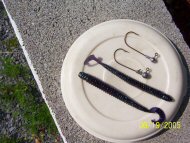 It's hard to tell
how many bass that the Tennessee Bass Guides Team have caught this year on
Old Hickory-Center Hill and Tim's Ford using this technique. Take a look at
the picture to the left.....when we are talking about throwing a little or
small worm this is the rig. Some time ago we heard about a company in
Alabama that was selling a jig head that was made with a 2/0 or 3/0 long
shank hook that would allow you to Texas rig a worm. We got a package and
found out that they work great. I decided that with a little help from a
good friend of mine we would just pour our own and as they say the rest is
history! If I told you how many bass and how many bragging bass we have
caught on this rig this year you might not believe me.
It's hard to tell
how many bass that the Tennessee Bass Guides Team have caught this year on
Old Hickory-Center Hill and Tim's Ford using this technique. Take a look at
the picture to the left.....when we are talking about throwing a little or
small worm this is the rig. Some time ago we heard about a company in
Alabama that was selling a jig head that was made with a 2/0 or 3/0 long
shank hook that would allow you to Texas rig a worm. We got a package and
found out that they work great. I decided that with a little help from a
good friend of mine we would just pour our own and as they say the rest is
history! If I told you how many bass and how many bragging bass we have
caught on this rig this year you might not believe me.
We use two different sizes of jig heads depending on the
depth of the water. On Old Hickory with all the shallow water we fish we use
the 1/16th head almost exclusively. When fishing deep water on Old
Hickory, Tim's Ford or Center Hill, or when the wind is blowing hard and you
can't feel the 1/16th head we opt for the 1/8th size. But let me also add
that there are times on deeper lakes when the bass will hit the worm on the
"Fall" and this plays right into the 1/16th ounce size because it sinks much
slower. There are a few versions of this jig head on the market now. The
best places to look would be at your nearest major sporting goods and
discount stores.
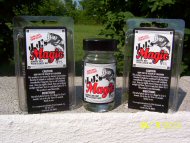
Now let's talk about worm color and scent. June Bug by far
has been the best color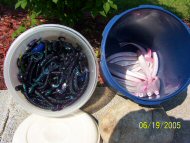 for us on all the lakes this year. The worm of choice has been the 4 inch
Zoom Dead Ringer soaked in a fantastic new product called JJ's Magic. JJ's
is heavy garlic scented liquid dip that is available in Chartreuse,
Methylate-Blue and clear. I first heard of JJ's Magic this past winter and
am I every glad I did. If your looking to get the maximum benefit from JJ's
Magic I suggest that you put your plastic worms-flukes etc in Tupperware
bowls and soak them completely with the CLEAR garlic oil. Once again I'm
telling you this stuff really works!!
for us on all the lakes this year. The worm of choice has been the 4 inch
Zoom Dead Ringer soaked in a fantastic new product called JJ's Magic. JJ's
is heavy garlic scented liquid dip that is available in Chartreuse,
Methylate-Blue and clear. I first heard of JJ's Magic this past winter and
am I every glad I did. If your looking to get the maximum benefit from JJ's
Magic I suggest that you put your plastic worms-flukes etc in Tupperware
bowls and soak them completely with the CLEAR garlic oil. Once again I'm
telling you this stuff really works!!
Recently I was fishing with a very good tournament fisherman
on Old Hickory Lake, pre-fishing him for a major event that is coming up. We
had several telephone conversation prior to our trip where we discussed what
I was throwing at the time, presentations, line size, you name it we covered
it. We started out strong that morning and then the bite began to get a
little tuff mid morning. Now remember we both were using the exact same worm
rig I showed you above-with the same exact line size and we stood side by
side as we worked several areas with these worms. The only difference was
that he was using another nationally know scent and I was in my little
Tupperware bowl.......after I had put 8 or 10 bass in the boat to his one he
decided "Maybe there is something to this JJ's Magic". It's just that good.
The best way to get JJ's right now is off his web site at
www.jjsmagic.com Try it and you
will see for yourself.
 Another key element in
fishing this rig correctly is having the right rod and line size.
Remember we are using a 1/6th ounce head and a four inch worm, the last
thing you would want to do is overpower your lure with a heavy action rod
and heavy line. That is why I throw these light baits on a AllPro 7 foot Med
action APX Rod and 6 pound test exclusively. The light line gives the
jig/worm rig freedom to work almost like it's swimming free. The 7 foot rod
allows me to gain distance on my cast and additional leverage at the boat
when fighting a big fish. For me if there is a sweeter set up I don't know
where it is!
Another key element in
fishing this rig correctly is having the right rod and line size.
Remember we are using a 1/6th ounce head and a four inch worm, the last
thing you would want to do is overpower your lure with a heavy action rod
and heavy line. That is why I throw these light baits on a AllPro 7 foot Med
action APX Rod and 6 pound test exclusively. The light line gives the
jig/worm rig freedom to work almost like it's swimming free. The 7 foot rod
allows me to gain distance on my cast and additional leverage at the boat
when fighting a big fish. For me if there is a sweeter set up I don't know
where it is!
This set up is perfect for using this type of technique. The
sensitivity in the APX rod is unmatched in the industry. Much of that is due
to the graphite rings that are strategically placed on the handle of the rod
that "transmit" the smallest of strikes up the line, down the rod,
into the handle and your hand. I know right now that there is someone
reading this saying that's just a bunch of #$@^&*%. I have had my
share of skeptics in the boat with me this year that have read past article
on the APX....but after they see the results in the net...and I put a APX in
their hands-they just can't believe the difference. It's like day and
night....it's like like holding a telegraphing feather compared to the base
ball bat they were fishing with. These are first class rods
manufactured and sold by some first class people. Check them out at
www.allprorods.com
The next bait that has been producing well for us is the Case
Sinking Salty Shad. I always tel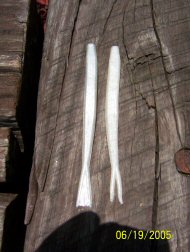 l
everyone that these baits are like putting candy in front of a kid. Fished
around weeds-wood-rock -boat docks-bridge pilings and bluffs this is one
fish catching tool. The bass just can't help themselves, they have to have
it. I want to point out why I believe that the Case Sinking Salty Shad is
superior to other nationally known plastic jerk baits.
l
everyone that these baits are like putting candy in front of a kid. Fished
around weeds-wood-rock -boat docks-bridge pilings and bluffs this is one
fish catching tool. The bass just can't help themselves, they have to have
it. I want to point out why I believe that the Case Sinking Salty Shad is
superior to other nationally known plastic jerk baits.
(1) It is full and I do mean full of salt. Because of the
salt the bait little weighs a little more which helps you with longer and
truer cast especially when the wind kicks up. As the salt dissolves the bass
tend to hold onto this bait longer which also helps with additional hook
up's.
(2) If you notice the Sinking Salty Shad is longer, thinner,
the nose of the bait is blunter (is that a real word) and the tail is more
of a paddle design than the nationally marketed bait. What this means
to you is simple. Because of the thinness of the bait and it's nose design
it displaces more water and cause the bait to dart erratically much easier.
The paddle tail also displaces more water and helps increase additional
action as well. I have fished these two brands side by side and the Case
bait wins hands down. These baits are available in many hologram finishes
check them out at www.madtoms.com
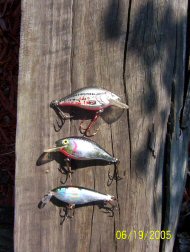 Last but never
least nor very far from my heart is the the Luhr-Jensen Speed Traps and the
#5 Shallow Shad Rap. I fish these baits on the exact same rod/line
combination that we talked about above. It has been my experience over and
over that you will have many more strikes on these baits when you use 6 lb
test line. Much of that I believe is due to the small size and light weigh
of these baits.
Last but never
least nor very far from my heart is the the Luhr-Jensen Speed Traps and the
#5 Shallow Shad Rap. I fish these baits on the exact same rod/line
combination that we talked about above. It has been my experience over and
over that you will have many more strikes on these baits when you use 6 lb
test line. Much of that I believe is due to the small size and light weigh
of these baits.
It seems that everything we have today to catch bass with is
high tech. And the Speed Trap is no exception. These baits are designed with
an expensive computerized mold system that creates a "Thin Wall" lure body
that increases the action and vibration.
The wide lip and intermediate width body makes them
exceptional around wood and rock cover. But one area where I believe they
excel is over shallow grass. I have a tendency to move my baits along fairly
quickly and the Speed Trap fits in perfectly. Bleeding Shiner-Chrome and
Black and Chrome and blue seem to be working the best right now. The Shad
Rap is also a tough one to beat as well. I think there are times when a
Non-Rattling bait is more effective. I always have two shallow to mid depth
crank bait rods ready at all times. One with a Speed Trap and the other with
the Shad Rap. Check out the line of Luhr-Jensen baits at
www.luhrjensen.com
Well other than marking your map for you there it is...150%
truth. I sure hope it helps you on your next trip to the lake. If you have
any questions e mail me at
rickm@dtccom.net or through our web site fishing reports page.
Rick
Fishing A Drop Shot In Deep Water
Tips For The Beginner Jan/Feb 2005
Written By: Rick McFerrin
Owner Guide
www. Tennessee Bass Guides. Com
Introduction
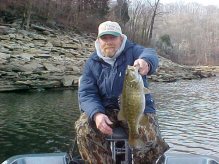 One of the great
benefits that we bass fishermen have here in middle Tennessee is that we can
chase our prey all year long. Under normal conditions our lakes never freeze
over. Most of the time even with the winter draw down we have great boat ramps
that are always assessable. We have shallow water lakes and river type
lakes that have a constant current and flow. We have lakes that have hot water
discharge plants that keep several miles of water with spring like
temperatures all winter. We also have several clear deep lakes like
Center Hill located near Smithville Tennessee in middle Tennessee where the
water temperatures will get down into the 40's and offers fantastic "Deep"
water Smallmouth-Largemouth and Spotted Bass fishing. How "Deep" is "Deep"?
How about consistently catching bass straight down in 25 feet-35 feet-45 feet
or even 50 feet of water or more?
One of the great
benefits that we bass fishermen have here in middle Tennessee is that we can
chase our prey all year long. Under normal conditions our lakes never freeze
over. Most of the time even with the winter draw down we have great boat ramps
that are always assessable. We have shallow water lakes and river type
lakes that have a constant current and flow. We have lakes that have hot water
discharge plants that keep several miles of water with spring like
temperatures all winter. We also have several clear deep lakes like
Center Hill located near Smithville Tennessee in middle Tennessee where the
water temperatures will get down into the 40's and offers fantastic "Deep"
water Smallmouth-Largemouth and Spotted Bass fishing. How "Deep" is "Deep"?
How about consistently catching bass straight down in 25 feet-35 feet-45 feet
or even 50 feet of water or more?
There are several techniques that seasoned bass fisherman like Tennessee Bass
Guide Billy Campbell (pictured above) uses to reach these deep water bass. But
none more enjoyable than a "Drop Sot" rig. Over the next several
paragraphs it is our intention to give you some useable information that Billy
passed on to me that will help you immediately on you next deep water bass
trip.
What Is A Drop Shot
And How Is It Rigged?
Billy explained it this w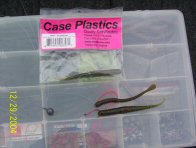 ay.
A Drop Shot is simply a finesse worm technique that is is rigged with a
plastic worm or small shad type bait fished on a #1 wide gap hook tied
approximately 18 to 24 inches ABOVE a 3/16th ounce weight attached to
the end of the line. The picture to the left is a little deceiving so let me
repeat this again. The worm is tied ABOVE THE WEIGHT.
ay.
A Drop Shot is simply a finesse worm technique that is is rigged with a
plastic worm or small shad type bait fished on a #1 wide gap hook tied
approximately 18 to 24 inches ABOVE a 3/16th ounce weight attached to
the end of the line. The picture to the left is a little deceiving so let me
repeat this again. The worm is tied ABOVE THE WEIGHT.
How Is The Hook And
Weight Tied On? Billy stressed the importance of tying the hook on
correctly. I watched as he tied the hook to the line 18 inches
above the loose end with a Palomar Knot. He then took the loose end of
the line and brought it back through the eye of the hook-when he did this it
left the hook standing straight out away from the line. By using this rigging
method Billy believes it increases your successful hook sets. He then attached
the 3/16th ounce drop shot weight to the loose end with another Palomar knot.
Very simple very easy procedure. Now what do you do?
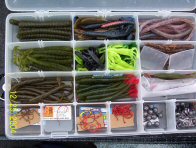 Choosing You
Bait: I guess the word "Finesse" defines where you start.
As with many innovative techniques it appears that western bass fishermen gave
drop shotting it's birth. It is critical much of the time that a "Small" bait
be used in their ultra clear lakes. So you can see how this technique
fits perfectly in lakes like Center Hill. Once again Billy's bait
selection is very simple, he stays with 3 and 4 inch worms and shad type
imitations. The Case Plastics Company of Clarksville Va. offers many great
plastic baits that the entire Tennessee Bass Guides Team uses for finesse
technique fishing. (see www.Madtoms.com)
Bait color is dictated by water color. Billy uses watermelon and green shades
in clear water and reds and June bug in stained water.
Choosing You
Bait: I guess the word "Finesse" defines where you start.
As with many innovative techniques it appears that western bass fishermen gave
drop shotting it's birth. It is critical much of the time that a "Small" bait
be used in their ultra clear lakes. So you can see how this technique
fits perfectly in lakes like Center Hill. Once again Billy's bait
selection is very simple, he stays with 3 and 4 inch worms and shad type
imitations. The Case Plastics Company of Clarksville Va. offers many great
plastic baits that the entire Tennessee Bass Guides Team uses for finesse
technique fishing. (see www.Madtoms.com)
Bait color is dictated by water color. Billy uses watermelon and green shades
in clear water and reds and June bug in stained water.
How Do You Rig It?
There is basically three methods used. (1) Texas Rigged- where the hook point
is buried back into the worm to make it weed less. This is the preferred
method if fishing structure such as deep timber and logs. (2) Hooked
directly through the tip of the nose where the hook is left exposed (3) Wacky
Style where the hook is placed through the center of the worm and left
exposed. The last two rigging methods work great out in deep open water
where the fish are suspended away from structure.
Rod And Line Selection
Lets start with the
rod: It's no secret that the All Pro APX Series Spinning Rods in the
medium 6 to 7 foot range is our rods of choice for this technique. Why? It's
simple. These rods are the most sensitive graphite rods we have ever used.
When you have a 4 inch worm with a 3/16th ounce weight hanging in 50 feet of
water directly below your boat you must be able to feel even the lightest
"TAP". There are times the bass will almost rip the rod out of your hands, but
there are also times that the hit is very subtle. That is exactly why we
use the APX series rod. (see
www.allprorods.com)
Next lets talk about
line: Billy explained that line weight and color depends much upon
water clarity. Under most conditions on Center Hill you can easily use 6 and
8lb test line. Billy had rods rigged with both clear blue fluorescent and lo-vis
green high quality line.
Where And How Is The Drop Shot
Fished In Deep Water?
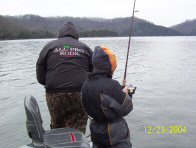 Take
a look at the picture to the left. What do you see? Much of the time
Take
a look at the picture to the left. What do you see? Much of the time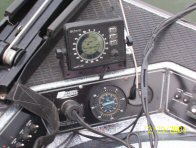 on Center Hill you will find the bass suspended in and around pods of shad out
in "Open Water" When this situation occurs it is extremely important that you
rely on "GOOD" electronics. Billy's approach to finding shad is to probe
various coves and creeks starting with the deepest water and working his way
in by zigzagging back and forth across from bank to bank until a good pod of
bait fish was found. Some of the fish were found in 50 feet of water
some in 30 feet or less. At that point Billy would man his trolling motor and
look for suspended bass (This Is Important) on the out side edges of the pod.
Billy would then search out the larger fish and watch his electronics as the
drop shot fell into the strike zone. Billy would make the bait "Quiver" as he
gently twitched the rod tip. He explained that this presentation is much
different from using a spoon where you want to impart a more erratic motion.
If you have good electronics you can actually see the the bass move up or down
to attack your bait and immediately feel that "Tap" we talked about earlier.
Billy explained that another method of presenting these little baits is
called "Strolling". This method is used when you know which direction the bass
are pushing the shad and you simply drag the bait along as you move with the
trolling motor, letting the motion and boat movement impart all action.
on Center Hill you will find the bass suspended in and around pods of shad out
in "Open Water" When this situation occurs it is extremely important that you
rely on "GOOD" electronics. Billy's approach to finding shad is to probe
various coves and creeks starting with the deepest water and working his way
in by zigzagging back and forth across from bank to bank until a good pod of
bait fish was found. Some of the fish were found in 50 feet of water
some in 30 feet or less. At that point Billy would man his trolling motor and
look for suspended bass (This Is Important) on the out side edges of the pod.
Billy would then search out the larger fish and watch his electronics as the
drop shot fell into the strike zone. Billy would make the bait "Quiver" as he
gently twitched the rod tip. He explained that this presentation is much
different from using a spoon where you want to impart a more erratic motion.
If you have good electronics you can actually see the the bass move up or down
to attack your bait and immediately feel that "Tap" we talked about earlier.
Billy explained that another method of presenting these little baits is
called "Strolling". This method is used when you know which direction the bass
are pushing the shad and you simply drag the bait along as you move with the
trolling motor, letting the motion and boat movement impart all action.
Conclusion
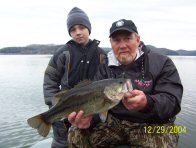 Will this
technique work? I guess the proof is in the picture to the left. A beautiful 4
pound plus largemouth that came out of 55 feet of water (Yes 55 feet)
suspended on the out side edge of a pod of shad.
Will this
technique work? I guess the proof is in the picture to the left. A beautiful 4
pound plus largemouth that came out of 55 feet of water (Yes 55 feet)
suspended on the out side edge of a pod of shad.
Just a couple reminders if
your planning to try this technique on Center Hill or another clear deep water
lake near you. (1) Remember that under normal conditions shad won't
suspend around cover like bass do. They prefer open water where they can mill
around and travel freely. (2) You have to rely on your electronics to help you
find and stay on the bait fish. (3) The Drop Shot method is deadly on both
active and not so active fish "IF" you get it in front of his face. (4) Don't
over power your finesse baits with rods and line that are to heavy for this
technique. (5) Stay alert watch the birds for feeding action and last
but not least don't get discouraged if your results the first trip or two is
slim. Like all other effective methods there is a learning curve to this
technique. Have fun....enjoy and let us know how you do fishing the "Drop
Shot"
Fishing A SpinnerBait: Tips For The Beginner
Written
By: Rick McFerrin Sept/Oct 2004
Owner/guide
www.tennesseebassguides.com
Introduction
One of the reasons that
I have loved fishing for largemouth bass now for over 40 years is their
inbreed tendencies to ambush their prey. Or to put it a little closer
to home, ambush the particular artificial bait that I might be using at the
time. I have always leaned toward running type baits such as crankbaits,
jerk baits, buzzbaits and spinnerbaits as my main lures of choice.
Having a bass smash a diving crankbait so hard it almost jerks the rod out
of your hand is a feeling that is hard to describe. The only thing that
could make it better would be if you could “See” the bass hit, which you
don't most of the time unless you are fishing clear water. But on the other
hand, there is a versatile bait that can be used not only in deep water, but
in mid range and shallow water presentations that will allow you many times
to “See” the strike. This, of course would be the safety pin type “spinnerbait”.
Over the next several paragraphs I want to share (1) how I choose a spinner
bait; (2) the rod and reel combinations that I use; (3) where and how I fish
the bait.
How
To Choose A Good SpinnerBait
Let’s
get this out of the way up front. The “Price Tag” on the spinnerbaits
isn’t always an indication of how well the bait is made or how well it will
perform under heavy usage. “Cheaper” seldom is “better”.
But, the most expensive” isn’t always the answer either. To me there are
seven tests that spinnerbaits must pass to make it a good tool. Some of
these elements can be determined with the bait still in the package;
unfortunately others can only be determined by using the bait. That is why I
would suggest not purchasing more than one until you know it is worth an
additional purchase. Now for a little Q&A.
1) What
kind wire is the bait made of and what is the wire gauge?
I’m sure there are those that are saying right now, why is this important?
It is very simple. I have found that spinner baits made with wire that is
less Than
.045 gauge just won’t hold up under rigorous usage. The price on the
bait might look attractive when you pay for it at the store, but how good
does it look to you when it bends beyond repair after you have used it a
time or two and you have to throw it away? The wire in my opinion that holds
up the best is stainless steel. I have used spinnerbaits made
of everything from small gauge wire cable to titanium. Wire cable was so
flexible that it created too much shaft movement it negated the blade action
and Titanium spinnerbaits have a tendency to snap because the
compound is very brittle when heated as they are at the head and bends. For
my $$$$$ stainless is the best choice.
2)
Where is the hook
point in relationship to the line tie? This is another test you can
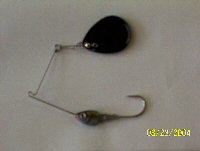 do while the bait is
still in the package. Again why is this important? Back in the mid 70’s I
was burning the roads up between home and the famed Toledo Bend Reservoir on
the Louisiana-Texas border when I made friends with a great fisherman from
Monroe Louisiana. He introduced me to Louisiana lakes with names such as
“Black Bayou,” Lake Bruin,” “Lake Providence,” and more. All these
lakes are full of cypress tress and custom made for spinner baits. I watched
him “open” the hook up on his spinnerbaits explaining that this was
done to get better hook up’s. What he was saying was the absolute
truth. But the reason for having to do this was that the line tie was higher
than the hook point which meant when my friend set the hook he would
actually be jerking the hook downward and out of the bass mouth. This is why
it is so important….and believe me, it will make a difference at the lake.
The next time you are in a fishing tackle section just take a few minutes to
look at the various spinner baits and you will see what I’m talking about.
do while the bait is
still in the package. Again why is this important? Back in the mid 70’s I
was burning the roads up between home and the famed Toledo Bend Reservoir on
the Louisiana-Texas border when I made friends with a great fisherman from
Monroe Louisiana. He introduced me to Louisiana lakes with names such as
“Black Bayou,” Lake Bruin,” “Lake Providence,” and more. All these
lakes are full of cypress tress and custom made for spinner baits. I watched
him “open” the hook up on his spinnerbaits explaining that this was
done to get better hook up’s. What he was saying was the absolute
truth. But the reason for having to do this was that the line tie was higher
than the hook point which meant when my friend set the hook he would
actually be jerking the hook downward and out of the bass mouth. This is why
it is so important….and believe me, it will make a difference at the lake.
The next time you are in a fishing tackle section just take a few minutes to
look at the various spinner baits and you will see what I’m talking about.
3)
What brand of hook is used on the bait?
Why is this important? Simple! There is nothing
worse than having a bait with a hook that won’t penetrate butter. As I said
earlier many baits look good at the store. But they loose
their looks at the lake when you see a big fish jump and throw the bait
because of bad hooks. I would just suggest this rule of thumb. If a spinner
bait manufacturer doesn’t list on the package the type of hook used (such as
Laser Hooks-Mustad Needle Point and others) I would pass on by. Believe me
if they used a premium hook on their bait they would sure want you to know
about it! No hook information on the packaging might even indicate cutting
corners in other parts of the manufacturing process. Just food for thought.
4)
Is the spinner bait equipped with a good premium
silicone skirt? How many times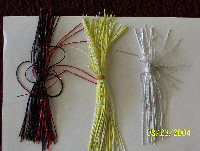 in the past have you bought a spinner bait and put it in you boat storage or
tackle box to use on your next trip? Trip day is here... you reach
down to get this new bait only to find that the skirt had melted together
and is unusable? Now not only do you have an additional expense replacing
the skirt-but more annoying is the sticky mess the skirt has made in your
tacklebox. I do believe however that there is a slight difference in
the way a 100% rubber skirt will perform in cold water verses a silicone
skirt. When that time rolls around and it is necessary, I change the shirts
out. But it is very rare that I leave a 100% rubber skirt in my boat during
hot weather. It may sound like a small thing,but it isn’t when you have to
clean up the mess.
in the past have you bought a spinner bait and put it in you boat storage or
tackle box to use on your next trip? Trip day is here... you reach
down to get this new bait only to find that the skirt had melted together
and is unusable? Now not only do you have an additional expense replacing
the skirt-but more annoying is the sticky mess the skirt has made in your
tacklebox. I do believe however that there is a slight difference in
the way a 100% rubber skirt will perform in cold water verses a silicone
skirt. When that time rolls around and it is necessary, I change the shirts
out. But it is very rare that I leave a 100% rubber skirt in my boat during
hot weather. It may sound like a small thing,but it isn’t when you have to
clean up the mess.
5)
What about blades? A test for the lake!
Do you buy a spinnerbait with willowleaf Blades, or Colorado
Blades, or Indiana Blades? Should the blades be painted, or hammered nickel,
or hammered copper, or mirror finished, or metallic finished? Do I need
tandem blades or single blades? And the answer is yes! You may need a
combination of all of these to effectively fish different water conditions.
But no
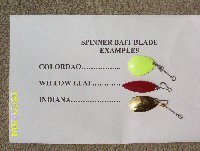 mater what the
combination, the blades need to be made of high quality material where they
will hold up under heavy usage. The finish on the blades need to last and
not discolor or flake off after you have bang it into various structure a
few times. And each blade style needs to provide you with maximum vibration
and water displacement for their size. At the lake, blade performance
can be determined rather quickly. The durability test may take a little
longer. To help you understand the difference in blade types look at the
attached picture to the left. (1) This is a Colorado blade. This blade will
put off more vibration and is the blade that I turn to in heavily
stained to muddy water and at night in deep water. I also like to use it in
areas where I’m fishing more wood than grass. (2) This blade is called a
“Willow Leaf. “ For the water that I fish the most here in Tennessee it is
probably the best over all style. It is good in clear and stained water and
will put off a fair amount of flash based on it’s finish. I fish a lot of
weeds on Old Hickory and the willow leaf tends to come through them much
better that other styles. (3) This is a Indiana Blade. It is a mixture of
the willow leaf and Colorado blade/ It also will put off a “good
vibration” (little Beach Boys there) and a lot of flash based on the
blades finish. Size of blade is normally dependent upon how fast I intend
to retrieve the bait. The smaller the bade the faster the retrieve. The
larger the blade the slower the retrieve.
mater what the
combination, the blades need to be made of high quality material where they
will hold up under heavy usage. The finish on the blades need to last and
not discolor or flake off after you have bang it into various structure a
few times. And each blade style needs to provide you with maximum vibration
and water displacement for their size. At the lake, blade performance
can be determined rather quickly. The durability test may take a little
longer. To help you understand the difference in blade types look at the
attached picture to the left. (1) This is a Colorado blade. This blade will
put off more vibration and is the blade that I turn to in heavily
stained to muddy water and at night in deep water. I also like to use it in
areas where I’m fishing more wood than grass. (2) This blade is called a
“Willow Leaf. “ For the water that I fish the most here in Tennessee it is
probably the best over all style. It is good in clear and stained water and
will put off a fair amount of flash based on it’s finish. I fish a lot of
weeds on Old Hickory and the willow leaf tends to come through them much
better that other styles. (3) This is a Indiana Blade. It is a mixture of
the willow leaf and Colorado blade/ It also will put off a “good
vibration” (little Beach Boys there) and a lot of flash based on the
blades finish. Size of blade is normally dependent upon how fast I intend
to retrieve the bait. The smaller the bade the faster the retrieve. The
larger the blade the slower the retrieve.
6)
This test you unfortunately won’t know until you
get to the lake. When you “Burn” the spinnerbait
just under the surface (I’ll explain this technique later) does the bait
come back straight to you or does it roll on one side or the other? So what
if it rolls? If it rolls the blades won’t displace the maximum amount of
water possible and your percentages of provoking a reaction strike
diminishes. Even with .045 gauge stainless steel wire after you have beat
and banged the bait into structure over and over again it will sometimes
bend to the point where the bait will roll. When this happens, gently
straighten the wire with a pair of pliers the problem can normally be
corrected. Other reasons that spinner baits roll is that the blade or blades
are too large for that size spinnerbait or the wire gauge is to flimsy. In
the last two cases you have just bought a bad spinner bait which more than
likely will be added to your “I wish I hadn’t bought that bait pile”
7)
Another test you can only perform at the lake.
The
opposite of “Burning” a spinner bait just under the surface would be
“Slow Rolling” (Another technique we will discuss later) the bait in deeper
water. It seems that most smallmouth fishermen here in the south love to
slow roll big bladed spinner baits in deep water. Most of the time they
literally “drag” or “crawl” the bait. But that’s hard to do when you
continually have to increase your speed just to get the blades to turn. To
me a good spinner bait is one where the blades begin to turn immediately
upon retrieve, and you can feel the thump of the blades when you slow it
down to a crawl.
This is my seven tests that
I use when selecting a spinnerbait that will perform and last over a
reasonable amount of time on the water. I have fishermen ask me what my
favorite spinnerbait is and hands down I have to reply Secret Weapon! Why?
Because they pass all 7 tests in flying colors and the value to cost ratio
is the best available today! Check out our links page or
www.secretweaponlures.com But
we aren’t done yet. Next you need to determine colors and the weight or bait
size needed for each fishing situation. We will address that next.
Choosing Size And Colors Of SpinnerBaits
I’m
going to try my best to keep this fairly simple. One of the most important
considerations that needs to be addressed in any lake is the size of the
predominate bait fish that the bass are feeding on. If I can I try to match
the size as closely as possible. But (and there is always a but) there are
other factors that need to be addressed as well. Such as water color,
cloud cover density and are you fishing daylight or darkness. If your
fishing at night is it the light or the dark of the moon?
Let’s start with size.
Do I use a 1/4ounce, 3/8 ounce, 1/2 oun, e-3/4 ounce or 1 ounce bait? This
explanation is going to be very basic. If I’m fishing water that is stained
to muddy or if I’m fishing slowly in deeper water at night I will use larger
spinnerbaits. 1/2 ounce and up. The reason for this is that larger spinner
baits are bulkier and the larger blades will create more vibration which
will help a bass locate the bait. If the water is real muddy or if it is
pitch black dark, I might even add a big trailer of some sort to add to
increase the bulk. If I’m fishing daytime clear water (or) shallower clear
water at night with a moon I prefer smaller baits, 3/8 ounce and down
because the bass can see them much easier and most of the time without a
trailer.
Now what about color?
Once again I will try to keep this simple. In clearer water I like to use
white-chartreuse & white-off white sliver pepper and a see through silver
flaked skirts. If I’m fishing moderately stained water I will almost
always opt for chartreuse and white or chartreuse and blue. If it is muddy I
like pure bright chartreuse. At night I like combinations of solid black,
solid purple, black & blue, black & purple, -lack & red. And at night if the
water is clear with a moon and I’m fishing in shallow to moderate depths I
even like pure white or pink.
There is no doubt in my
mind that other solid colors or color combination work for other fishermen.
But these are the sizes and colors that produce for me most consistently.
Now that we have the right spinner bait what rod and reel combo do I use?
Choosing
The Right SpinnerBait Rod/Reel Combo
This will be one area where there will be some disagreement.
So I will just preface this portion by saying I’m going to explain what
works for me. Having the “right” rod and reel combination for a specific
technique in your hands makes all the difference in the world. I
wouldn’t use a flipping stick/casting reel combo filled with 20lb test line
to throw a small # 5 Shallow Shad Rap. Nor on the other hand would I use a 5
½ foot ultra light rod/micro spinning reel with 4lb test to fish a 3/8oz
spinnerbait. Once again having the right rod/reel set up for fishing a
spinnerbait makes a big difference. The “One Rod Fits All Techniques” just
doesn’t work. Over the next few paragraphs my goal is to explain why I use
what I use. I hope this will help you.
I guess I need to go
all the way back to my friend from Monroe Louisiana to help explain why I
use what I use. Rods have come a long way over the past 30 years. I
can remember getting into Everett’s 14 foot Jon boat and he would have 5 or
6 fiberglass rods rigged with different baits. He swore by those fiberglass
rods, and I must admit he sure could put the hurt on largemouth every time
he went. Graphite rods were just becoming somewhat popular-but he was dead
set against these new rods. More than once I heard him say “Why
change something that isn’t broke?” To some degree back 30 years ago he was
right. But as time and technology has raced by those new rods have become
much more sensitive. Now I use two different AllPro APX Series rods for
fishing spinnerbaits.
First is the AllPro
APX7MSTN which is a 7 foot Medium action spinning rods for lighter baits and
the AllPro
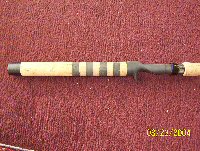 APX610MHCA which is a
6 foot 10 inch medium heavy casting rod for my heavier baits. Both of
these rods have soft tips and the sensitivity is amazing. One real point of
difference that sets these APX rods apart from all other graphite rods no
matter the brand or cost is the “Graphite Rings” on the handle. (See picture
to the left) Other graphite rods are made where the graphite blank runs
through a cork handle. The cork inadvertently acts as a buffer or insulator
which diminishes some of the “Feel” or sensitivity. But the APX is designed
where the strike is transmitted from the tip of the rod through the blank
and into these graphite rings and then into the palm of your hand.
Absolutely maximizing sensitivity. No buffer-no insulator just “Direct
Feel”!!!
APX610MHCA which is a
6 foot 10 inch medium heavy casting rod for my heavier baits. Both of
these rods have soft tips and the sensitivity is amazing. One real point of
difference that sets these APX rods apart from all other graphite rods no
matter the brand or cost is the “Graphite Rings” on the handle. (See picture
to the left) Other graphite rods are made where the graphite blank runs
through a cork handle. The cork inadvertently acts as a buffer or insulator
which diminishes some of the “Feel” or sensitivity. But the APX is designed
where the strike is transmitted from the tip of the rod through the blank
and into these graphite rings and then into the palm of your hand.
Absolutely maximizing sensitivity. No buffer-no insulator just “Direct
Feel”!!!
I have been fortunate to
own some very nice rods in my life time. But these new AllPro APX series
rods are the best I have ever had in my hands. The APX rod is 100% American
made (which is unusual these days) is a light as a feather but extremely
powerful and once again very sensitive. They are made of the finest 100%
graphite with Fuji ECS Reel Seats and Titanium guides. When you throw a
spinnerbait on these rods you can feel the “Thump” of the blade all the way
through the rod handle. Even the slightest bite is magnified. It is so much
more sensitive than fiberglass rods which have a very slow response when you
set the hook. I like the longer handles which helps with two handed long
casts. I also like the longer rods because they give you an extra advantage
fighting a fish right at the boat. You can visit the AllPro site by
going to our links page or by
www.allprorods.com .
Back about 3 years ago
I bought a 7 foot fiberglass cranking rod that I thought I just had to have.
I used it 4 times and was so disappointed in the “FEEL” that I
“WASN’T GETTING” that I hung it up on the wall, and it hasn’t been used
since. Another $100.00 that could have been put to better use. I have become
so accustomed to the quick hook sets and feel that I get with my graphite
rods that the fiberglass rod was just plain disappointing.
I guess for me it just
plain comes down to feel. I want to be able to detect those subtle hit’s
when a big fish engulfs the bait and all you can “Feel” is something
different. Have you been there before? Not a slashing-bone jarring strike;
just a subtle difference. If you can’t feel that subtle difference you are
going to miss out on a lot of fish. I can hear some boooo’s from the
fiberglass fans that are reading this right now;that’s why I prefaced in the
beginning I just want to explain what works for me. If you can put a
bunch of bass in the boat on a regular basis using fiberglass “Don’t change
what’s not broke” But if your having trouble detecting those subtle
hit’s you might just want to think about buying a good (let me say it again)
good-graphite rod.
All graphite rods are
not created equal. If you buy a cheap rod-expect cheap results. I
always urge new bass fishermen to buy the best they can afford. Use it until
you can afford something even better then move up. Everyone’s disposable
income isn’t the same. But we all have the same ability to use what we have
wisely.
 Now
to the reel department. As I have said before, I settled in with Shimano
reels and just stayed right there. I use a Shimano Stradic ST4000FH on my
spinning rod. This reel retrieves 35 inches of line per crank-has 5
bearings-a 5.7:1 gear ratio and weighs 13.4 oz. I fill the reel with 200
yards of 10lb test P-line. The 5.7:1 ratio gives me enough speed when I need
it but also works extremely well at a slower presentation.
Now
to the reel department. As I have said before, I settled in with Shimano
reels and just stayed right there. I use a Shimano Stradic ST4000FH on my
spinning rod. This reel retrieves 35 inches of line per crank-has 5
bearings-a 5.7:1 gear ratio and weighs 13.4 oz. I fill the reel with 200
yards of 10lb test P-line. The 5.7:1 ratio gives me enough speed when I need
it but also works extremely well at a slower presentation.
On my casting rod I use
the Shimano Calcutta reel which retrieves line at 23 inches per crank-has 3
bearings-a 5.0:1 gear ratio and weighs 11.1 ounces.
I fill this reel with 200 yards of 12 pound test P-Line. This reel
combined with my APX rod gives me a very powerful combination with medium to
larger baits. I guess it’s like a guy that will only buy a Ford or a
Chevy…you just like what you like and stay with it.
Locations And Techniques
I
have heard it said that you can use a spinnerbait just about everywhere and
I believe that to be true. You can fish this bait shallow, mid range or deep
water. You can fish it in open water or around heavy timber, grass, rock and
other obstacles. You can burn it, slow roll it, crawl it and just use an
in-between retrieve. The safety pin style spinnerbait is truly a versatile
lure.
Next we will explore
where and how I fish the spinnerbait. I’m sure there are other techniques
and locations that might work even better for you on your area lakes. To
find those it just takes time on the water and patience. Hopefully this will
give you a starting place.
1)
Lay Down Timber: One of
my favorite places to fish a spinner bait is in and around fallen timber
that has several limbs remaining. Some of the limps will be visible while
much of it may not. My home water here in middle Tennessee is Old Hickory
Lake. This lake has an abundance of fallen timber in all depths of water.
Some of this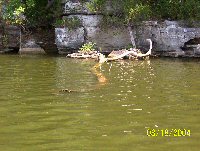 timber
will remain stationary all the time. Some of it will move with the rise and
fall of the lake level. Some will be in the backs of coves and pockets. Some
are wedged in and around docks and piers. Some have come to rest right at or
near the main river channel with a lot of current while others are isolated
on expansive flats that have little current. But no matter where the
timber is located all of it under the right conditions is prospective cover
for largemouth bass. I would have to say that “Isolated” timber located
near or on a channel ledge has historically been the best producer of bass
for me. These areas normally will have deep water close by, current, bait
washing in and shade on some area of the timber. The more limbs on the
fallen tree the more shaded areas that will be present. I always make
repeated casts to the shaded portion of the timber trying to stay as
parallel as possible. Bass like shaded areas and truthfully they don’t have
to be large areas. Work the timber completely, pick it apart section by
section. Let your spinner bait helicopter (free-fall) down in and around
intersections of limbs where it is attached to the trunk. Hold on you might
just have a fight on your hands.
timber
will remain stationary all the time. Some of it will move with the rise and
fall of the lake level. Some will be in the backs of coves and pockets. Some
are wedged in and around docks and piers. Some have come to rest right at or
near the main river channel with a lot of current while others are isolated
on expansive flats that have little current. But no matter where the
timber is located all of it under the right conditions is prospective cover
for largemouth bass. I would have to say that “Isolated” timber located
near or on a channel ledge has historically been the best producer of bass
for me. These areas normally will have deep water close by, current, bait
washing in and shade on some area of the timber. The more limbs on the
fallen tree the more shaded areas that will be present. I always make
repeated casts to the shaded portion of the timber trying to stay as
parallel as possible. Bass like shaded areas and truthfully they don’t have
to be large areas. Work the timber completely, pick it apart section by
section. Let your spinner bait helicopter (free-fall) down in and around
intersections of limbs where it is attached to the trunk. Hold on you might
just have a fight on your hands.
2)
Visible Logs Without Branches and Stumps: I
approach
visible straight logs (one’s without branches) by fishing the
shaded side of first. If part of the log is resting on bank I try to cast as
closely to the bank as possible and bring the spinnerbait
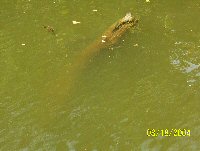 slowly down the
entire length of the log. Then I work the other side of the log. If the log
is running out into deep water I position my boat where I can cast my
spinnerbait well past the end of the log and retrieve it very slowly letting
the bait bump the log as I go by. On visible stumps I make my cast on
the shaded side beyond the stump. By casting past the stump you can work the
side and back of the stump at the same time. Plus it isn’t as likely that
you will spook a bass that might be there. Some stumps have very little root
system attached, while others might have an extensive system. Here’s a tip
beginning bass fishermen. Always wear a good pair of polarized sun glasses.
They will help you greatly in visually determining what you are fishing.
Years ago I fished a lake that had the “Text Book” example of stumps
situated directly on a creek channel bank. Many of the stumps were 4 to 5
feet across and all had extensive roots still attached. The base of the
stumps was located in 3 feet of water with some of their roots actually
hanging over the channel drop into 15 feet of water. I spent many exciting
hours working this stump row over and over again. The water was just clear
enough that you could see the bass come out of the roots and smash the
spinner bait as it bumped and banged along. Early, late, and on cloudy
days the bass would be located up in the shallow water but at other times
with clearer brighter sky’s they would be staged on roots right at the
break. Areas like these will produce fish over and over again through out
the year.
slowly down the
entire length of the log. Then I work the other side of the log. If the log
is running out into deep water I position my boat where I can cast my
spinnerbait well past the end of the log and retrieve it very slowly letting
the bait bump the log as I go by. On visible stumps I make my cast on
the shaded side beyond the stump. By casting past the stump you can work the
side and back of the stump at the same time. Plus it isn’t as likely that
you will spook a bass that might be there. Some stumps have very little root
system attached, while others might have an extensive system. Here’s a tip
beginning bass fishermen. Always wear a good pair of polarized sun glasses.
They will help you greatly in visually determining what you are fishing.
Years ago I fished a lake that had the “Text Book” example of stumps
situated directly on a creek channel bank. Many of the stumps were 4 to 5
feet across and all had extensive roots still attached. The base of the
stumps was located in 3 feet of water with some of their roots actually
hanging over the channel drop into 15 feet of water. I spent many exciting
hours working this stump row over and over again. The water was just clear
enough that you could see the bass come out of the roots and smash the
spinner bait as it bumped and banged along. Early, late, and on cloudy
days the bass would be located up in the shallow water but at other times
with clearer brighter sky’s they would be staged on roots right at the
break. Areas like these will produce fish over and over again through out
the year.
3)
Shallow Water Grass:
Another favorite area of mine to fish a spinnerbait is in standing weeds
like the ones in the picture to the left. Some of these weed lines are
in very shallow water-some will extend out into 4 feet of water or more.
Some will be located on flats very near channel drops. As you can see in the
attached picture there is a sizeable opening between the grass and the bank.
Early and late in the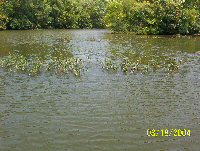 day as well as cloudy days this can be your key area to focus on. I make
long casts and work the spinner bait back to me always having visual contact
with the bait. There are some areas like this that will have patches of
standing grass within the opening. These are key areas as well. As the sun
comes up I concentrate on the outside “deeper” edges of the grass
weaving the spinnerbait through as much of the vegetation as possible.
I have also noticed that on windy days when it is blowing directly into the
weeds the bass seem to be staged more to the out side edges of the weed
line. When this is the situation I always start there no matter the time of
day or what amount of cloud cover I have. Lure speed varies you may have to
adjust several times before you find what the bass want.
day as well as cloudy days this can be your key area to focus on. I make
long casts and work the spinner bait back to me always having visual contact
with the bait. There are some areas like this that will have patches of
standing grass within the opening. These are key areas as well. As the sun
comes up I concentrate on the outside “deeper” edges of the grass
weaving the spinnerbait through as much of the vegetation as possible.
I have also noticed that on windy days when it is blowing directly into the
weeds the bass seem to be staged more to the out side edges of the weed
line. When this is the situation I always start there no matter the time of
day or what amount of cloud cover I have. Lure speed varies you may have to
adjust several times before you find what the bass want.
4)
Bluffs: I may be
wrong, but I believe that many beginning bass fishermen look at bluffs (main
channel and creek channel) and think they will have to throw a jig or worm
to have a chance of catching bass. Or maybe the thought of the deep water
associated with the bluff keeps them from fishing it all together. But you
know there are times, under the right circumstances, that much
shallower running lures
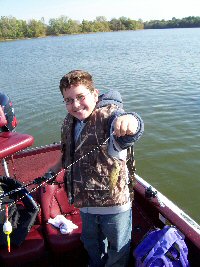 can be big producers
in these areas. One of first mistakes that many fishermen make is staying
too far off the bluff wall with their boats. I have found to fish these
areas correctly, no matter what the water color is, you have to
fish parallel so close that you can reach out and touch the bluff with your
hands. By doing this you keep your bait in the strike zone all the way. When
the water color is clear you can burn the spinner bait back to you just
under the surface. Many times that I have had suspended fish come up from
deep water on these bluffs to bust a spinner bait. When the water color is
dingier I work the ledges of these bluffs by slow rolling the spinnerbait
trying to stay in contact with the rock and wood as much as possible.
I also always look for changes in the bluff wall such as indentations and
rock slides. Indentions are recessed areas in the face of the wall that will
give you two defined corners for bass to ambush from as well as the recessed
area that many times will hold timber or a series of stair step ledges.
Rock slides, on the other hand are almost always a signal that the
water around the side will be shallower. These areas hold bait fish and
crayfish continually. When you get to the end of the bluff you will come to
a “Point” much like the one in the upper right hand corner of the picture
above. We will discuss this next.
can be big producers
in these areas. One of first mistakes that many fishermen make is staying
too far off the bluff wall with their boats. I have found to fish these
areas correctly, no matter what the water color is, you have to
fish parallel so close that you can reach out and touch the bluff with your
hands. By doing this you keep your bait in the strike zone all the way. When
the water color is clear you can burn the spinner bait back to you just
under the surface. Many times that I have had suspended fish come up from
deep water on these bluffs to bust a spinner bait. When the water color is
dingier I work the ledges of these bluffs by slow rolling the spinnerbait
trying to stay in contact with the rock and wood as much as possible.
I also always look for changes in the bluff wall such as indentations and
rock slides. Indentions are recessed areas in the face of the wall that will
give you two defined corners for bass to ambush from as well as the recessed
area that many times will hold timber or a series of stair step ledges.
Rock slides, on the other hand are almost always a signal that the
water around the side will be shallower. These areas hold bait fish and
crayfish continually. When you get to the end of the bluff you will come to
a “Point” much like the one in the upper right hand corner of the picture
above. We will discuss this next.
5)
Points: Think about this
for just a minute. Some lake are shallow, some are deep. Some are clear,
and some are dingy to muddy. Some have vegetation, and others don’t. Some
have an abundance of wood, while other are void of wood. This could go
on and on so let’s get to the bottom line. One feature that at least 90% of
all lakes will have in common is that they have “Points” located in various
areas of the lake. Some lakes because of size or shape may have more or
less, but most will have some.
Using a spinnerbait on points can be some of the most
rewarding trips that you might ever have. Points offer bass a change in
depth. And it’s that change that leads from shallow to deeper water that
helps hold bass on them year around in many lakes. I like points that extend
out into the lake and then take a sudden drop. This type of point seems to
hold more and larger fish over all. I try to position my boat deep water but
close enough to reach the shallow portion of the point with a long cast. I
cast the spinnerbait across the point and drag it back to me making as much
contact with the point as possible with out getting hung up. I make repeated
casts going a little deeper and a little deeper to ensure that I have worked
to area completely. I then move my boat where I can work both sides and the
center portion of the point. Points like this can be good all year
around-spring –summer-fall and winter.
6)
Boat Docks: What
3 key features do docks offer bass? (1) Shade (2) Cover (3) Bait Fish.
If you fish older lakes that have docks on them you will find they vary in
size-construction and in depth of water. My favorite type of dock is one
that is low to the water has openings either between the wood or floatation
has submerged cover around them and is close to deep water. Lower built
docks offer bass more shade and the openings give bass a variety of areas to
hide in. And the submerged cover (most likely there for crappie) attracts
bait fish which attracts the bass. I like to work my spinner bait parallel
slowly against outside edges of the dock-letting it drop and then pick back
up the speed. I also work inside the covered area of the dock as much as
possible. Many times if bass are suspended under the dock the helicopter
action of the spinner bait blades will provoke a reaction strike. If the
dock has house boats, pontoon boats or jet ski platforms attached to it I
treat them as part of the dock and fish them accordingly. Just a word of
advice. I have found that some docks “never” produce fish for me-so when I’m
fishing a line of docks I only fish those that have produced regularly in
the past. No need in beating dead water……..keep
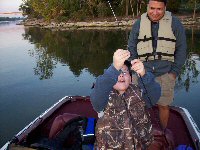 moving!
moving!
7)
Rip Rap Areas: I really
like fishing rip rap areas. And although most of these areas may look the
same it couldn’t be further from the truth. I like to look for areas of the rip rap that is
different from everything else around it. Such as small points that extend
out even slightly. Logs that have wedged themselves in close to the bank.
Weed growth that extends a foot or more out from the rocks. It’s this type
of areas that seem to hold the most fish. I like to work these areas
parallel keeping my boat as close as possible to the rocks. I make long cast
and start out by keeping visual contact with the spinner bait all the way
back to the boat. If the bass aren’t holding that close to the rocks a move
out a little deeper but still fish parallel slowing my spinner bait down
checking out various depth levels. Rip rap areas hold bait fish,
crawfish and other goodies for a hungry bass to dine on. If the section of
rip rap you are fishing has a culvert or bridge on it, be sure to work all
four corners that have been created by the bridge. You will also need to
determine if there is current coming through the culvert or bridge. If
current is present the four corners of rip rap under the bridge can be even
more productive.
further from the truth. I like to look for areas of the rip rap that is
different from everything else around it. Such as small points that extend
out even slightly. Logs that have wedged themselves in close to the bank.
Weed growth that extends a foot or more out from the rocks. It’s this type
of areas that seem to hold the most fish. I like to work these areas
parallel keeping my boat as close as possible to the rocks. I make long cast
and start out by keeping visual contact with the spinner bait all the way
back to the boat. If the bass aren’t holding that close to the rocks a move
out a little deeper but still fish parallel slowing my spinner bait down
checking out various depth levels. Rip rap areas hold bait fish,
crawfish and other goodies for a hungry bass to dine on. If the section of
rip rap you are fishing has a culvert or bridge on it, be sure to work all
four corners that have been created by the bridge. You will also need to
determine if there is current coming through the culvert or bridge. If
current is present the four corners of rip rap under the bridge can be even
more productive.
Conclusion
I hope that some of what you have read above will help you on
your next trip to the lake. Spinnerbaits may very well be one of the most
versatile baits that you will ever have in you tackle box. A lure for all
depths, seasons and weather conditions. Be careful in the spinnerbaits you
buy-use the correct rod and reel combo for fishing spinner baits-and be
thorough when and where you use them. If you will do these things you will
increase your changes greatly of having good productive spinner bait days on
the water. Rick McFerrin
www.tennesseebassguides.com
Fall Transition Bass
Tips For The Beginner
By:
Rick McFerrin
Tennessee Bass Guides.Com
When Mother Nature
takes her brush and paints the leaves on our trees orange, yellow and brown.
When Friday night and Saturday afternoons are spent cheering on your
favorite high school or college football team. When the air temp gets a
little cooler at night and not nearly as
high at mid-day. When the water temps in the upper
regions of the lake begins to turn downward, it’s a signal that “Fall
Transition” bass fishing is getting ready to “CRANK UP”!
Over the next several
paragraphs within this article, it is my intention to share with you some of
the techniques and patterns that I look for during this time of the year.
There is one thing you must keep in mind concerning “Season
Change”. It doesn’t always mean that there will be a hungry bass next
to every log, under every boat house, hiding in every weed bed or suspended
off every creek channel point. But under normal circumstances it does
mean this…Largemouth will almost always repeat the same migration routes
that they used in the spring. If you will stop right there, and think about
that for a moment it will give you some real insight where you can begin
your search for Fall Transition Bass. Let’s examine this fact a little
further.
Where Do You Begin?
It
has been my experience over the years that bass will travel in the Fall
right back to the same areas that I found them in during the spring spawning
season. I begin to search out creeks and pockets in the upper region
of the lake that has a lot of cover and where fresh water runs into the
creek. This is an important fact that many beginning bass fishermen either
overlook or don’t understand completely. Remember “Spawn” and “Fall
Transition” bass patterns will always appear nearer where the river comes in
verses areas nearer the dam. The larger the body of water the truer this
fact becomes.
If weather patterns are
normal, the fall season will bring us rain and falling temps. Fall
also will bring “Cold Fronts” that we will talk more about later. Influx of
fresh water will almost always result in greater oxygen levels, a greater
shad population within the creeks, which in turn results in bass following
the shad into these areas. Let’s talk a little bit about creeks.
Concentrate on
Creeks In the Fall
As
I stated earlier I like to concentrate on major creeks toward the head of
the river first before in I attack small creeks, ditches and mid lake
creeks. I like creeks that have plenty of cover. Creeks that are laden
with lay down timber along the bank. Creeks with stump rows, chunk rock,
sunken brush around boat docks and when possible grass and other aquatic
weeds. I like creeks that have arms that provide multiple points.
The ideal creek would be one where this structure is close to the dominate
channel.
The reason for being
close to the channel is four fold (1) Most of your major reservoir creek
channels will have “Current” (2) Current means “Oxygen” (3) Current means
“Food” “Shad & Bait Fish” (4) And “Deeper Water Access” .
If the creek that I
have chosen is a big creek, that is wide at it’s mouth I always by pass the
first portion and head straight toward the back where the creek narrows at
it’s source and the channel is more defined. There is three reason for this
(1) If a good shad population is present-it is much easier to stay on the
bait, which is a vital link in being successful (2) Your chance of being
closer to the creek current is much greater, which will help you take
advantage of the structure that is available. (3) If your area should happen
to experience a substantial rain, the influx of this dingier water many
times will ignite bass into feeding frenzies.
To help you locate
creeks and areas like we have discussed above you can use (1) a good
topographical lake map (2) GPS with Maps capabilities (3) your electronics
or (4) LUCK……I think I’ll try the first three. If you’re serious about being
successful on the water you have to do your home work.
What About Fall
Cold Fronts And Water Temp’s
In
many respects we bass fishermen are a lot like the bass we pursue. For
several months now everything has been more or less the same. It may been
hot-but it’s been “Consistently Hot” We learned to adapt to that and so did
the fish. The bass found the right depth that provide them with the thermo
cline and oxygen that they needed. If you worked at it, you were
rewarded by catching bass in a fairly unchanging pattern. But now change is
in the air. Even as I write this article-day time temps are reaching the low
80’s but instead of those 70 degree nights we were experiencing just a few
weeks ago the norm is now the high 40’s to mid 50’s.
Just like you and I
feel the temperature change and begin to reach for that sweat shirt or light
jacket in the mornings the bass feel it to. Their metabolism and activity
levels will begin to slow as we head into the late fall-early winter time
frame. Am I painting a picture of “Gloom & Doom for Fall bass fishing? No,
not at all. I’m convinced that everything that I have outlined above
can have a “GREATER” effect on the fisherman than it does the bass they say
they want to catch. This time of the year it becomes a preparation and
mental game. You have to be willing and able to adjust to these changes
around you. Let me give you an example.
Let’s say your lake has
experienced several days of cloudy conditions and then a moderately severe
cold front comes through and you’re left with no clouds and only blue bird
skies. What do you do? Pack up and go home? Watch football instead of fish?
Not me! I stick with my creek game plan and work even more closely to the
cover nearest the channel and slow my lure presentation down. But let
me also add that in lakes like my home lake Old Hickory in Nashville
Tennessee a two or three degree drop in the surface temperature will have
little to no effect on shallow fish. Those in 4 feet of water or less. But
if the sudden drop is greater than three degrees it can have a negative
effect. This again enforces that fact that you need to know your
creeks and where structure is close to the deeper channel areas that has
moving water or current so that you can adjust accordingly.
I guess the worst
conditions would be if you experienced a drastic temperature drop that was
accompanied by heavy cold rains that elevated the lake level. This cold
water instead of pulling shad and baitfish up into the backs of the creek
will push them out instead. My suggestion at that point would be to begin to
move out further and further in the creek to try to find some stability in
water temperature and shad activity. And there are times when you just have
to let these situations pass and let the lake settle back down.
I’ve had days in the
Fall that were unbelievable in numbers and quality of fish. And then I’ve
had days that I had to remind myself to stick to what I preach and be slow
and methodical in my approach and my lure selection. Which brings us to
lures for the Fall season.
Fall Lure
Selection
It will come as no surprise
that my first choice for fishing the Fall transition period is a “Small
Crank bait”. I like crank baits in 1/16th 1/8th and ½
ounce sizes that are no more than 2 ½ inches long. I like those that run 2
feet to 12 feet deep-some with bills and some lipless.
One of the very first
thoughts that enter the mind of many fisherman when I talk about these small
baits is that the only catch small fish. If that’s what you’re thinking let
me put it to you this way. “You Sir Are Dead Wrong!” Time and time
again through out the fall and early winter months I have caught lunker size
Largemouth, Smallmouth and Spots on small crank baits.
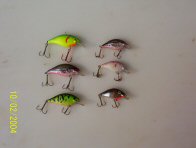 I
like to use the Luhr-Jensen Speed Traps and a local favorite, the Buckeye
Shad as my crank baits of choice. There are some distinct differences
between these two types of baits that I need to explain. The Speed Trap as
your can see has a bill and are fairly wide
I
like to use the Luhr-Jensen Speed Traps and a local favorite, the Buckeye
Shad as my crank baits of choice. There are some distinct differences
between these two types of baits that I need to explain. The Speed Trap as
your can see has a bill and are fairly wide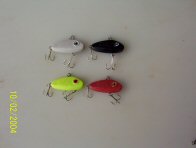 bodied floating baits which have rattles inserted inside. The wobble of the
baits are wider and therefore moves more water. You also have the ability to
stop these baits in mid-retrieve and they will slowly float back up toward
the surface. This technique many times is very deadly in the Fall. The
Buckeye Shad on the other hand is a thinner bait that doesn’t float or have
a rattle and has a very tight wobble. I’m convinced that just like in the
early Spring, there are times that bass just don’t want a bait that rattles.
I can’t always explain the why, but I have experienced this to be true many
times. I also like to stay with at least 2 different shad colors and a
chartreuse or fire tiger combination in that fall.
bodied floating baits which have rattles inserted inside. The wobble of the
baits are wider and therefore moves more water. You also have the ability to
stop these baits in mid-retrieve and they will slowly float back up toward
the surface. This technique many times is very deadly in the Fall. The
Buckeye Shad on the other hand is a thinner bait that doesn’t float or have
a rattle and has a very tight wobble. I’m convinced that just like in the
early Spring, there are times that bass just don’t want a bait that rattles.
I can’t always explain the why, but I have experienced this to be true many
times. I also like to stay with at least 2 different shad colors and a
chartreuse or fire tiger combination in that fall.
One of the reasons I
like to use these types of baits is that you can drop your trolling motor
and cover water. Lakes like Old Hickory tend to always have color in
the water so I try to stay in a shallow pattern as much as possible covering
the structure nearest to the channel current. I like throwing these small
baits on a AllPro APX 7 foot Medium action spinning rod with 6lb and 8lb
test line and always use a good snap which I believe helps give these crank
baits additional action.
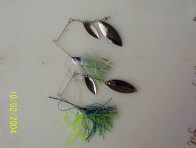 There
are times that even with bait fish present the bass seem reluctant to hit a
crank bait, or after you have caught several in one area the bite slows
down. This is when I pick up a rod rigged with a Secret Weapon Spinner bait.
If the bass have been in the cover I will continue to run my spinner bait
through the limbs and then just it die in opening, or next to stumps or
brush piles. I believe this is where the Secret Weapon really shines. Both
blades on these baits will helicopter down with equal freedom which isn’t
true with most spinner baits on the market today. If the fish have
been on the outside edge of the brush I make repeated cast in every
direction to make sure that all sides of the cover have been fished. I like
to use the 3/8oz willow leaf model with sliver blades with either a
blue/chartreuse, white/chartreuse or a translucent skirt with silver metal
flakes.
There
are times that even with bait fish present the bass seem reluctant to hit a
crank bait, or after you have caught several in one area the bite slows
down. This is when I pick up a rod rigged with a Secret Weapon Spinner bait.
If the bass have been in the cover I will continue to run my spinner bait
through the limbs and then just it die in opening, or next to stumps or
brush piles. I believe this is where the Secret Weapon really shines. Both
blades on these baits will helicopter down with equal freedom which isn’t
true with most spinner baits on the market today. If the fish have
been on the outside edge of the brush I make repeated cast in every
direction to make sure that all sides of the cover have been fished. I like
to use the 3/8oz willow leaf model with sliver blades with either a
blue/chartreuse, white/chartreuse or a translucent skirt with silver metal
flakes.
Conclusion
I can’t emphasis enough
the importance of staying in the creeks and on the bait fish during the Fall
transition period. Your chances of loading the boat or having a very few
strikes almost always hinges on the presence of shad in the areas your
fishing. As Fall begins to give way to early winter and the water
temperatures lowers even more I begin to work my way back out further and
further toward the mouth of the creeks until the water temperatures reach 50
degrees then it’s winter fishing time and everything changes again.
But that’s another
article and another story. I wish you the best in this Fall season….Good
Luck and Good Fishing Rick McFerrin Tennessee Bass
Guides.com
e

For the
Competitive Angler
Written By: Rick
McFerrin
November 2005
www.tennesseebassguides.com
Introduction
Recently Tennessee Bass Guides had the honor of teaming up with the Prowler
Lure Company which is located in Leitchfield Kentucky due north of Bowling
Green. From prior use I knew how good their product was, so I was excited to
have them aboard. Prowler is one of the fastest growing soft plastic
bait companies in the United States and is owned and operated by the Van
Meter family. One of the very first things that impressed me was that
Prowler is a fishing lure company that is still operated by tournament
fishermen. Mr. Van Meter is an avid tournament bass fisherman and keep a
torrid tournament schedule. I really believe this is one of the reasons why
Prowler continues to be so successful. Nothing compares to (1) being
in the trenches for years and seeing for yourself what works and what
doesn't (2) surrounding yourself with a professional fishing staff that
assists in new product ideas and design enhancements. Unfortunately in
many large bait companies today it's the lure designers and marketing
departments (which rarely fish) that determine what go's to market and what
doesn't. But not true with Prowler, they only produce baits made by
bass fishermen for bass fishermen. With this "on water" approach it enables
Mr. Van Meter and the Prowler Pro Team to meet the needs of a ever changing
fishing climate. Innovative life like baits that are available in a
multitude of colors to meet every water situation. Since the Prowler Lure
Company produces such a extensive line of plastic baits it would be
difficult for me to cover all of them in one article. So, to do justice to
these fine baits and to give you the reader a better understanding of each,
there will be a series of articles that hopefully will be of great value
you. The Tennessee Bass Guides Team members have personally tested these
baits and I can tell you that each guide has been very impressed with the
results. My policy hasn't changed "We only promote items that we use
on a regular basis-that works for us" by doing so you get an honest straight
forward assessment.
Prowler Chunks

Looking over the reports for the past several months our guide team members have been
catching largemouth and smallmouth bass on several different Tennessee lakes
and rivers pitching and flipping a variety of jigs. For those of you that
are "Jig Fanatics" you know that many times the "Jig/Chunk Size" and bulk in
the water can make all the difference in the world on catching or not
catching fish. I guess in some respects a bass is allot like us...sometimes
we want a "Big Meal" and sometimes we want a "Small Meal" When throwing
small jigs and hair fly's that are 1/16th to 3/32nds in weight, on 4lb and
6lb test I like to use a small chunk. This is where the Prowler Eel
and Prowler Small Pro Chunks come on strong for me. I have found that when
the bite has been very tough the Prowler Eel is the chunk I turn to. I'm not
sure if it's, for lack of better words the "Slenderness" of the bait or the
longer configuration of it's tail that makes a difference. It make very well
be that it just doesn't move as much water upon entry. But what ever the
case this is one great multi-use trailer. Combined with the right size jig
it just becomes a snack for a Smallmouth. The Eel also works extremely well
on spinner baits as a trailer and inserting into tubes. Both sizes of the
Prowler Ell comes in 18 different colors to meet any need.
the reports for the past several months our guide team members have been
catching largemouth and smallmouth bass on several different Tennessee lakes
and rivers pitching and flipping a variety of jigs. For those of you that
are "Jig Fanatics" you know that many times the "Jig/Chunk Size" and bulk in
the water can make all the difference in the world on catching or not
catching fish. I guess in some respects a bass is allot like us...sometimes
we want a "Big Meal" and sometimes we want a "Small Meal" When throwing
small jigs and hair fly's that are 1/16th to 3/32nds in weight, on 4lb and
6lb test I like to use a small chunk. This is where the Prowler Eel
and Prowler Small Pro Chunks come on strong for me. I have found that when
the bite has been very tough the Prowler Eel is the chunk I turn to. I'm not
sure if it's, for lack of better words the "Slenderness" of the bait or the
longer configuration of it's tail that makes a difference. It make very well
be that it just doesn't move as much water upon entry. But what ever the
case this is one great multi-use trailer. Combined with the right size jig
it just becomes a snack for a Smallmouth. The Eel also works extremely well
on spinner baits as a trailer and inserting into tubes. Both sizes of the
Prowler Ell comes in 18 different colors to meet any need.
 Then
there are times that the Prowler Small Pro Chunk is what I turn to. I like
using this size chunk on 6
Then
there are times that the Prowler Small Pro Chunk is what I turn to. I like
using this size chunk on 6 and 8lb test and a 1/8th and 3/16th ounce jig. I like this size because it
adds a little bulk to the jig and the wider tail seems to move more water.
This jig and chunk combo is a in between size for me that I like to use in
lay downs and in rivers when there is moderate current. There is enough
weight not to get swept away but still light enough to have a slower fall.
On jigs 1/4 ounce and up I like the Prowler Medium (picture to the
left) and Jumbo Chunks. These add a little more water displacement and
weight. The tails of these chunks are very flexible and have a fantastic
action. All three sizes of these Prowler Chunks are available in 20
different colors many of which are unavailable on any other manufactures
plastic baits.
and 8lb test and a 1/8th and 3/16th ounce jig. I like this size because it
adds a little bulk to the jig and the wider tail seems to move more water.
This jig and chunk combo is a in between size for me that I like to use in
lay downs and in rivers when there is moderate current. There is enough
weight not to get swept away but still light enough to have a slower fall.
On jigs 1/4 ounce and up I like the Prowler Medium (picture to the
left) and Jumbo Chunks. These add a little more water displacement and
weight. The tails of these chunks are very flexible and have a fantastic
action. All three sizes of these Prowler Chunks are available in 20
different colors many of which are unavailable on any other manufactures
plastic baits.

 Another
valuable tool in the Prowler treasure chest is the Pro Craw and the Jr. Pro
Craw Chunk. Both of these Pro Craws are Salt and Garlic Injected. The "NEW"
patent pending design of the Pro Craw gives a realistic appearance to any
jig or spinner bait. Take time to check these baits out in clear shallow
water, you will see what I mean. The pinchers create a almost natural
defense stance that just begs a big fish to take a bite. Once again just as
a personal choice I like to use the Jr. Pro Craw Chunk on 1/8th and 3/16th
ounce jigs and the larger Pro Craw Chunk on larger jigs. Experiment, other
size and jig weight combos may work better for you. These baits are also
fantastic spinner bait trailers and are you have a great selection of 30
colors to choose from.
Another
valuable tool in the Prowler treasure chest is the Pro Craw and the Jr. Pro
Craw Chunk. Both of these Pro Craws are Salt and Garlic Injected. The "NEW"
patent pending design of the Pro Craw gives a realistic appearance to any
jig or spinner bait. Take time to check these baits out in clear shallow
water, you will see what I mean. The pinchers create a almost natural
defense stance that just begs a big fish to take a bite. Once again just as
a personal choice I like to use the Jr. Pro Craw Chunk on 1/8th and 3/16th
ounce jigs and the larger Pro Craw Chunk on larger jigs. Experiment, other
size and jig weight combos may work better for you. These baits are also
fantastic spinner bait trailers and are you have a great selection of 30
colors to choose from.

Prowler Tubes
 What
a selection for you to choose from. Prowler manufactures 7 different Tubes
in multiple lengths and sizes. All Prowler Tubes are a soft double dipped
tube with long tentacles that deliver incredible action. These are truly
some of the hottest baits in the industry today. From the Super Tube-Big
Butt Tube-Stubby Tube-Pro Super Tube-Pro Flipping Tube-Finesse Tube to the
Crappie Tubes Prowler has it covered with the highest quality fish catching
baits available any where. Some one might ask "Why so many choices of size
and colors of the same type bait"? Well lets see how I can answer this.
(1) Bass have varying degrees of taste when it comes to eating. There
are times their pray may be small like crayfish and small bait fish. Other
times the may be feeding on larger bluegill-shad and other larger available
bait. (2) Water clarity also plays a big part in making your lure choice. In
stained to muddy water I like a larger bait like the Prowler Super Tube or
Big Butt Tube that creates more water movement which helps the bass zero in
on the bait. In clearer water I like to go to the Prowler Finesse and Stubby
Tube which has a more subtle movement. (3) Water clarity many times
will help you make color choices. Normally in darker water I try to stay
with darker colors like Black-Dark Reds and Deep Purples. In clearer water I
like watermelon, smoke pepper, pearls and pumpkin . But sometimes there are
glaring exceptions to this scenario. I fish a clear deep lake near my home
for Smallmouth. June bug always seems to be my best go to color which defies
some of my earlier thoughts. This is where you need to experiment to find
out what works best for you. Through years of fishing experience Mr. Van
Meter realized the necessity of making multiple sizes (7) and colors (26)
available because of the very reasons we just talked about.
What
a selection for you to choose from. Prowler manufactures 7 different Tubes
in multiple lengths and sizes. All Prowler Tubes are a soft double dipped
tube with long tentacles that deliver incredible action. These are truly
some of the hottest baits in the industry today. From the Super Tube-Big
Butt Tube-Stubby Tube-Pro Super Tube-Pro Flipping Tube-Finesse Tube to the
Crappie Tubes Prowler has it covered with the highest quality fish catching
baits available any where. Some one might ask "Why so many choices of size
and colors of the same type bait"? Well lets see how I can answer this.
(1) Bass have varying degrees of taste when it comes to eating. There
are times their pray may be small like crayfish and small bait fish. Other
times the may be feeding on larger bluegill-shad and other larger available
bait. (2) Water clarity also plays a big part in making your lure choice. In
stained to muddy water I like a larger bait like the Prowler Super Tube or
Big Butt Tube that creates more water movement which helps the bass zero in
on the bait. In clearer water I like to go to the Prowler Finesse and Stubby
Tube which has a more subtle movement. (3) Water clarity many times
will help you make color choices. Normally in darker water I try to stay
with darker colors like Black-Dark Reds and Deep Purples. In clearer water I
like watermelon, smoke pepper, pearls and pumpkin . But sometimes there are
glaring exceptions to this scenario. I fish a clear deep lake near my home
for Smallmouth. June bug always seems to be my best go to color which defies
some of my earlier thoughts. This is where you need to experiment to find
out what works best for you. Through years of fishing experience Mr. Van
Meter realized the necessity of making multiple sizes (7) and colors (26)
available because of the very reasons we just talked about.
Prowler Grubs
 Prowler
manufactures 5 grubs for you to choose from. The 4.5 inch Pro Fat
Grub-3.5 inch Pro Grub and the Pro Crappie Grub. All have extra wide
tails that vibrates immediately when you begin your retrieve. These baits
come in 14 different colors. There are times just like yesterday
when the wind was up to 20mph and the Smallmouth were on the windiest points
that a Prowler Grub is hard to beat. You can rig the Pro Fat Grub on a 1/4
ounce jig head and cast extremely well into the wind. The action of the bait
begins immediately and many time smallmouth will hammer the grub on the
fall. There are also times when a smaller grub and jig head is needed. Those
times when the bass are a little more finicky. That's when I turn to the 3.5
inch Pro Grub. Both sizes are great baits and with 14 colors to choose from
you just can't go wrong.
Prowler
manufactures 5 grubs for you to choose from. The 4.5 inch Pro Fat
Grub-3.5 inch Pro Grub and the Pro Crappie Grub. All have extra wide
tails that vibrates immediately when you begin your retrieve. These baits
come in 14 different colors. There are times just like yesterday
when the wind was up to 20mph and the Smallmouth were on the windiest points
that a Prowler Grub is hard to beat. You can rig the Pro Fat Grub on a 1/4
ounce jig head and cast extremely well into the wind. The action of the bait
begins immediately and many time smallmouth will hammer the grub on the
fall. There are also times when a smaller grub and jig head is needed. Those
times when the bass are a little more finicky. That's when I turn to the 3.5
inch Pro Grub. Both sizes are great baits and with 14 colors to choose from
you just can't go wrong.


The
New C Leggs is a innovative bait that combines twin tails with a flat belly
that helps slow the baits fall. The legs of the bait is just a tad thicker
which keeps the tails from sticking together. The C-Leggs can be fished
alone as a grub. On a jig as a trailer and effectively as a drop shot bait.
You will have to see the action of these baits to believe it. Once again
being a light line guy I really like the C-Leggs Minus on a 1/16th ounce jig
head. This little tid-bit is just a snack for those big brown fish. Two
sizes and 26 colors to choose from....This ones a real winner, you need to
check them out.
Conclusion
This
time around we covered Prowler Chunks-Tubes and Grubs and we didn't get half
way through the great selection of soft plastic baits that Prowler
manufactures. There will be at least 2 more follow up articles to cover the
remaining items. You have many choices when you stand in front of soft
plastic sections in your favorite tackle store. Some brands are price
driven, some brands are name recognition driven, some brands are quality
driven and others are just driven. The next time you need a soft plastic
bait give Prowler a try-you won't regret it. As a matter of fact if you buy
one item you will buy more they are just that good. Check them out on our
web site at
www.tennesseebassguides.com scan down to the bottom of the first page
and click on the Prowler logo....If you have any questions just send them to
me I will be happy to help
rickm@dtccom.net
Thanks for reading
Rick McFerrin Tennessee Bass Guides.com
Product Review
J.J.'s Magic
Dippin Dye With Garlic
April 2005
Written By: Rick McFerrin
www.tennesseebassguides.com
Introduction
Fish attractants have been around for a long time. Attractants
have been manufactured in sprays, liquids, creams, pastes, and gels in a
variety of scents and colors. Some work and truthfully some don't. The
retail price really doesn't seem to be a valid indication of how good the
product will be, so unless you have a good reliable source of information or
recommendation from someone buying scents and dyes are a roll of the dice at
best. If you are like me all you have to do is look at the baits and
equipment you never caught fish on to prove my point. Fess Up! Several
hundred dollars worth right?
So in my old age I have become (Rena my wife says cranky) but
more to the point very very selective in what I buy and more importantly
what I endorse. If you were sitting here in my office with me tonight you
would see several boxes of baits-tackle and accessories that companies have
sent to me asking for an endorsement on our site. If you click on the
Product Archive Tab you will find all the products that I have written
reviews on. You will also find that each has earned a positive endorsement.
Why? Because they work like they are suppose to. They are good products that
I as a full time guide and owner of Tennessee Bass Guides Inc. personally
use on a regular basis and find reliable.
You see, if I try something and it doesn't work I simply just
won't write a review. I guess it go's back to how I was raised. You
know "If you can't say something good, just don't say anything at all." So
any product review you read on my site will be about products that most
definitely works for me and my team of guides. As a matter of fact just this
week on four guide trips my clients and I caught a combination of 84
Smallmouth-Largemouth and Spotted Bass on 4 inch plastic worms I soaked with
this product. We will talk more about this in the paragraphs below.
You can see pictures of the fish on my site. JJ Polak and Alan Summer have
formulated a fantastic product that has ALREADY helped me catch more fish
and it will do the same for you if you will use it correctly.
Company History
Alan Summer invented a dye for soft plastic baits back in the
early 1980's. Alan having a start up business marketed his dye locally and
this is
 when
he met JJ Polak. Alan told JJ about the product and urged him to try it. JJ
put the product to a rigorous test on the water and determined that if Alan
would add garlic oil to the dye it would enhance the product greatly as a
fish attractant. The result was a new formula that would allow the dye
to penetrate into soft plastic baits. Let me emphasize this again, it
penetrates into the plastic and the scent will remain in the bait.
When Alan and JJ tested this new formula they found that their bites
increased and that the fish held onto the bait longer. They had other
tournament anglers test it as well and the rest is now history. Alan-JJ and
JJ's two sons Andy and Marty formed a company that is now known as Fish
Chemicals and market the product known as J.J.'s Magic.
when
he met JJ Polak. Alan told JJ about the product and urged him to try it. JJ
put the product to a rigorous test on the water and determined that if Alan
would add garlic oil to the dye it would enhance the product greatly as a
fish attractant. The result was a new formula that would allow the dye
to penetrate into soft plastic baits. Let me emphasize this again, it
penetrates into the plastic and the scent will remain in the bait.
When Alan and JJ tested this new formula they found that their bites
increased and that the fish held onto the bait longer. They had other
tournament anglers test it as well and the rest is now history. Alan-JJ and
JJ's two sons Andy and Marty formed a company that is now known as Fish
Chemicals and market the product known as J.J.'s Magic.
What Does The Product Do?
First of all J.J.'s Magic is a dippin dye solution that is
designed to let you customize your
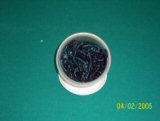 soft
plastic baits which is a great benefit. BUT.....To me the greatest benefit
is that it penetrates the bait and the scent won't wear off. Every
since JJ sent me this product I have put it to the test. One of the lakes
that I guide here in middle Tennessee is Tim's Ford which is located between
Nashville and Chattanooga. Tim's is known for it's Smallmouth population but
also has an abundance of Largemouth and Spotted Bass as well. I had been on
a fairly good bite on a small 4 inch worm fished on a jig head. Many times
the bite was very subtle and I found that some of my clients would have
trouble "Feeling" the hit. Well, when JJ sent me his product to test, my
attention was drawn immediately to the Clear Garlic scent, and let me
explain why. The bass like the little Junebug colored worm that I have been
using so I certainly didn't want to alter the color...BUT.....I sure wanted
to add the garlic scent to the worm hoping to get the fish to hold on just a
little longer. So I dumped 50 or more 4 inch worms in one of Rena's
Tupperware bowls (I hope she doesn't miss it) and being advised by JJ in
advance of how strong the garlic scent was I carefully poured some onto the
worms. I was like a little kid waiting until the next day to see what would
happen on my new JJ's Magic scented worms....What was the results? I can sum
it up in one 3 letter word..........WOW! The results speak for themselves.
I can't and won't tell you that I have realized X % of increased bites using
this product....but I can tell you this. I have watched my clients hook ups
increase dramatically and watched them put more fish in the boat using the
same 4 inch worms soaked in J.J.'s Magic than they did before. Folks, when
the bass grabs this worm soaked in this product they just won't hardly let
go. That's the key-that is the BIG DIFFERENCE-that the additional edge
between J.J.'s Magic and other dye type products that I have used in the
past. So for a guide-tournament fisherman or just a casual week end bass
fisherman it can make a BIG difference on the number of bass you will put in
the boat.
soft
plastic baits which is a great benefit. BUT.....To me the greatest benefit
is that it penetrates the bait and the scent won't wear off. Every
since JJ sent me this product I have put it to the test. One of the lakes
that I guide here in middle Tennessee is Tim's Ford which is located between
Nashville and Chattanooga. Tim's is known for it's Smallmouth population but
also has an abundance of Largemouth and Spotted Bass as well. I had been on
a fairly good bite on a small 4 inch worm fished on a jig head. Many times
the bite was very subtle and I found that some of my clients would have
trouble "Feeling" the hit. Well, when JJ sent me his product to test, my
attention was drawn immediately to the Clear Garlic scent, and let me
explain why. The bass like the little Junebug colored worm that I have been
using so I certainly didn't want to alter the color...BUT.....I sure wanted
to add the garlic scent to the worm hoping to get the fish to hold on just a
little longer. So I dumped 50 or more 4 inch worms in one of Rena's
Tupperware bowls (I hope she doesn't miss it) and being advised by JJ in
advance of how strong the garlic scent was I carefully poured some onto the
worms. I was like a little kid waiting until the next day to see what would
happen on my new JJ's Magic scented worms....What was the results? I can sum
it up in one 3 letter word..........WOW! The results speak for themselves.
I can't and won't tell you that I have realized X % of increased bites using
this product....but I can tell you this. I have watched my clients hook ups
increase dramatically and watched them put more fish in the boat using the
same 4 inch worms soaked in J.J.'s Magic than they did before. Folks, when
the bass grabs this worm soaked in this product they just won't hardly let
go. That's the key-that is the BIG DIFFERENCE-that the additional edge
between J.J.'s Magic and other dye type products that I have used in the
past. So for a guide-tournament fisherman or just a casual week end bass
fisherman it can make a BIG difference on the number of bass you will put in
the boat.
 As
I started to say in the paragraph above J.J.'s Magic is currently packaged
in 4 colors. Blue-Methylate, Chartreuse and Clear. All, except the
clear scent is designed to let you customize your baits But unlike
some of the more well known dyes on the market today this product will
penetrate your baits and the scent will remain there cast after cast. No
additional dipping is needed. I can see where the Chartreuse will be the
most versatile, but each will play an important part of my fishing
throughout the year when faced with various water colors and conditions. I
have also found by doing a double dipping experiment that you can create
various degrees of green-orange and purple. I like to add red many
times when throwing a soft plastic jerk type bait-the Methylate is going to
be dynamite for that no doubt! I'm sure you have different color
combinations that work well for you....now just think of what would happen
if the bass would hold onto your bait and not want to let go. Like I said
Wow! Bass truly love this stuff!
As
I started to say in the paragraph above J.J.'s Magic is currently packaged
in 4 colors. Blue-Methylate, Chartreuse and Clear. All, except the
clear scent is designed to let you customize your baits But unlike
some of the more well known dyes on the market today this product will
penetrate your baits and the scent will remain there cast after cast. No
additional dipping is needed. I can see where the Chartreuse will be the
most versatile, but each will play an important part of my fishing
throughout the year when faced with various water colors and conditions. I
have also found by doing a double dipping experiment that you can create
various degrees of green-orange and purple. I like to add red many
times when throwing a soft plastic jerk type bait-the Methylate is going to
be dynamite for that no doubt! I'm sure you have different color
combinations that work well for you....now just think of what would happen
if the bass would hold onto your bait and not want to let go. Like I said
Wow! Bass truly love this stuff!
Conclusion
I guess I haven't been this excited about a new product and all
the possibilities that it affords in a long time. Being a full time guide
and owner of a guide service I'm always looking for ways to help my clients
 catch
more fish when there are with us. I really believe that J.J.'s Magic will
play a big part in doing just that this year. I'm sure by now your
saying, Rick where can I get some of this stuff? As with all new companies
getting product out into the market is a tough situation at best. So the
Fish Chemical team decided to aim their initial campaign via the internet.
The best way to get this fantastic product is by going to our links page and
simply clicking on the J.J.'s Magic logo or ordering over the internet at
www.jjsmagic.com . The process is very
quick and easy to follow and you have your choice of shipping options.
catch
more fish when there are with us. I really believe that J.J.'s Magic will
play a big part in doing just that this year. I'm sure by now your
saying, Rick where can I get some of this stuff? As with all new companies
getting product out into the market is a tough situation at best. So the
Fish Chemical team decided to aim their initial campaign via the internet.
The best way to get this fantastic product is by going to our links page and
simply clicking on the J.J.'s Magic logo or ordering over the internet at
www.jjsmagic.com . The process is very
quick and easy to follow and you have your choice of shipping options.
As I said in the beginning of this review. If I didn't believe
in this product and have seen it work time and time again with my own eyes I
wouldn't give it my endorsement. But friends J.J.'s Magic is a winner.
Try it yourself and you will see why I'm excited about this product.
Product Review
The Buckeye Shad

March 2005
Written By: Rick McFerrin
www.tennesseebassguides.com
Introduction
It's a well known fact that professional bass fishermen have
a tendency to keep secrets when it comes to lures, presentations and just
about anything that's working for them. As a matter of fact sometimes the
secret can be kept for long periods of time. But, it seems like every year
you will read articles that have titles like, "XYZ The Lure The Pro's Tried
To Keep Secret" or " The Technique The Pro's Didn't Want You To Know About"
or "My Close Encounter With Alien Bass Fishermen". Well maybe the last one
went a little far...I just got carried away.
You see, keeping secrets when it comes to bass fishing
doesn't just stop with the pro's. I live and guide full time in middle
Tennessee. I have the privilege of being around some of the best bass
fishermen that I have ever known. Fishermen that have a tendency of keeping
everything "Close To The Vest" even with friends. Some of these fishermen
have mastered deep clear lakes like Dale Hollow, Center Hill, Tim's Ford and
others. Many have concentrated on river lakes like Old Hickory,
Kentucky Lake, Wheeler and Pickwick. And through the years there has been a
lure that has remained a regional secret with many of these great fishermen.
A lure that works in clear or stained water. A lure that works deep or
shallow. A lure that works in rock-grass and wood equally as well. A lure
that works in all 4 seasons of the year and that lure is the Buckeye Shad.
When you mention the Buckeye to serious bass fishermen in
towns here in Tennessee like "Smithville" " Sparta" "Cookeville"
"McMinnville" "Tullahoma" and other you can see their eyes light up, and
most will proudly tell you they still have Buckeyes that are years and years
old that they just can't bring themselves to use. I think the Buckeye is
even listed in some of the Last Will And Testaments of many of these men
just like UT Football season tickets. To my wife I leave my
house-car and bank account...BUT....to my son I leave my tuck-boat and my
Buckeye Shads.
Folks, you may think I'm going a little to far, but I tell
you it is hard to tell how many huge Smallmouth-Largemouth and Spots have
fallen victim to this deadly little bait. For more than 50 years now the
dream of Robert Richardson and his family has been living up to it's
"Legendary" reputation. And for 50 years it has been a fairly well kept
southern secret.
What Is A
Buckeye Shad?
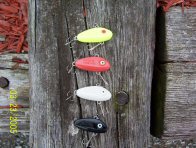 What
makes the Buckeye Shad a very unique lipless crank bait? It's 1 1/2
inches long, casts like a bullet and will sink like a rock. The nose of the
bait is more rounded than pointed and the tail is rounded and tapered all at
the same time. The mid portion of the body is wider in it's belly and
narrows toward the top. Most lipless crank baits have a tight wiggle-BUT-one
big difference with the Buckeye Shad is that it has a VERY TIGHT wiggle and
will tack straight as an arrow on every cast and rarely will turn up on it's
side and loose track. This true tracking is achieved by the precise
positioning of the line tie, which is located just at the crest of the nose
where it begins to slope. The Buckeye has two sets of treble hooks-one
positioned on the bottom of the bait almost directly below the line tie and
the other in the tail section. The bait is topped off with either a
Red-Silver or Gold reflective eyes that is recessed into it's head that
gives off a prism like effect in clearer water.
What
makes the Buckeye Shad a very unique lipless crank bait? It's 1 1/2
inches long, casts like a bullet and will sink like a rock. The nose of the
bait is more rounded than pointed and the tail is rounded and tapered all at
the same time. The mid portion of the body is wider in it's belly and
narrows toward the top. Most lipless crank baits have a tight wiggle-BUT-one
big difference with the Buckeye Shad is that it has a VERY TIGHT wiggle and
will tack straight as an arrow on every cast and rarely will turn up on it's
side and loose track. This true tracking is achieved by the precise
positioning of the line tie, which is located just at the crest of the nose
where it begins to slope. The Buckeye has two sets of treble hooks-one
positioned on the bottom of the bait almost directly below the line tie and
the other in the tail section. The bait is topped off with either a
Red-Silver or Gold reflective eyes that is recessed into it's head that
gives off a prism like effect in clearer water.
What Colors
Are Available?
I like to call the Buckeye a "Blue Collar Bait". Not
much glitz and glitter-just "Solid And Steadfast". These baits are currently
manufactured in the four no-nonsense colors that you see in the picture
above. Chartreuse-Blood Red- White and Black. Do you ever get
tired of throwing a lipless crank bait a few times and the color begins to
come off? This won't happen with the Buckeye Shad! The Buckeyes color is
molded into the bait so no matter how much beating and banging it gets the
color will always remain the same. No sparkle-No translucent paint-No
flaking-No loss of color-just one steady rugged bass catching tool.
When Do You
Fish The Buckeye Shad?
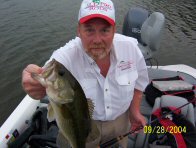 There
is no doubt that the Buckeye Shad gained it's original fame in the cold
winter months here in
There
is no doubt that the Buckeye Shad gained it's original fame in the cold
winter months here in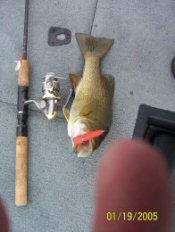 Tennessee. In low water conditions when the wind and snow is blowing
almost side ways hardy souls armed with light line-small hair jigs and
Buckeye Shads would (and still do) consistently load the boat with big brown
fish. But there is more to the story! This is not just a winter bait!
Let me stress this point again. This is not just a winter bait! The
Buckeye is a fantastic ALL YEAR CRANK BAIT. The Buckeye works in all types
of structure. Timber or rock, anytime anyplace all seasons. Anytime you
would think about throwing a lipless crank bait the Buckeye Shad will
produce hands down.
Tennessee. In low water conditions when the wind and snow is blowing
almost side ways hardy souls armed with light line-small hair jigs and
Buckeye Shads would (and still do) consistently load the boat with big brown
fish. But there is more to the story! This is not just a winter bait!
Let me stress this point again. This is not just a winter bait! The
Buckeye is a fantastic ALL YEAR CRANK BAIT. The Buckeye works in all types
of structure. Timber or rock, anytime anyplace all seasons. Anytime you
would think about throwing a lipless crank bait the Buckeye Shad will
produce hands down.
For those of you that might not be familiar with Old Hickory
Lake here in middle Tennessee. It's a TVA river lake that stretches from the
cities of Cathage all the way to the city of Old Hickory just east of
Nashville. In-between you can find every type of structure and conditions
that bass love. River current-protected bays and flats.
Ledges-drops-rock-timber-grass-boat docks-bluffs-islands-boat
ramps-bridges-rip rap and more. During the HOTTEST months of the summer many
big largemouth will stay in water so shallow that you wonder why you can't
see their fins sticking out of the water. During these times the bass
will slam a Buckeye worked correctly around wood and grass in these shallow
areas. It's also fantastic for schooling bass that we find on a regular
basis in protected bays. Take a look at the dates on the 3 fish pictures
October-September and January..... I could add pictures from every
month.....Like I said.....It's a All Year Bait!
How Do You
Fish A Buckeye Shad?
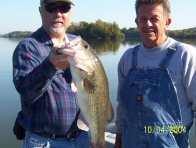 The
best way to fish a Buckeye is to do so fearlessly! I toss this bait in and
around every type of structure that I possibly can. I keep in contact with
the structure as much as possible. This rugged little bait is designed to
slam off underwater rock and wood. It is designed to be ripped through grass
and weeds. It's designed to be cranked through and bounced off of everything
that you can. Some of the most violent strikes will take place when you use
this bait in heavy cover.
The
best way to fish a Buckeye is to do so fearlessly! I toss this bait in and
around every type of structure that I possibly can. I keep in contact with
the structure as much as possible. This rugged little bait is designed to
slam off underwater rock and wood. It is designed to be ripped through grass
and weeds. It's designed to be cranked through and bounced off of everything
that you can. Some of the most violent strikes will take place when you use
this bait in heavy cover.
There are times when you can't retrieve this bait fast
enough. Then there are times that a slow steady grinding retrieve will
produce more strikes. I keep changing up until the bass tell me what they
want. Choices of rods/reels and line sizes varies by the structure and water
color your fishing. But 90% of the time I opt for a spinning rod and no more
than 10 pond test line. Remember I stressed Fearless!
Conclusion
The Buckeye Shad has a big winter reputation but it is truly
a bait for all seasons. I know there is a lot of hype when it comes to
fishing lures-but take it from someone that shoots straight and makes his
living on the water. The Buckeye Shad...A one time middle and upper east
Tennessee secret----is a secret no more. If you buy one and fish it...you
will be as hooked on the Buckeye as a 5 pound Smallmouth. For more
information go to our links page or
www.buckeyeshad.com Let me know how you do
with this fantastic little bait. Rick McFerrin Owner Tennessee Bass Guides.
Com
Product Review

Written By: Rick McFerrin Tennessee Bass
Guides .com
May 2004
Company History
The Luhr-Jensen Company was created in 1932 by Mr.
Luhr Jensen Sr. which produced spinnerbaits out of a backyard chicken coop in
Hood River Oregon. Currently the company produces a variety of artificial
baits and has a 60,000 square foot distribution center in Hood River and employ’s more than
250 people. In this review we will discuss one of these products the “Speed
Trap”.
Opening
Thoughts
Being a full time bass guide here in Tennessee I make
my living on the water. If I don’t produce, if I don’t catch fish eventually
there will be no income-no guide service. There are many elements that go into
making sure that your clients have the opportunity to catch good quality fish.
Most importantly you have to know where the fish are. But after that, you have to
know what will trigger them into striking, you have to know what the fish
want. What type of lure-what type of action-what depth-what color will produce
the best for your clients that day. Any long term guide will tell you that
this information only comes by spending hundreds of hours on the water
learning.
In a recent monthly article that I wrote on
“CrankBait Fishing For The Beginner” (see Tip’s Archive Tab
www.tennesseebassguides.com) I confessed that I have been a “CrankBait
Junkie” from a very early age. There is something about putting the right
cranbait on the right rod with the right line and making the right
presentation and feeling the bass slam the bait that still gives me a rush.
Much was the case on April 21-2004 when I met Jeff Glowacki at Old Hickory
Lake here in the Nashville area. Jeff is the area representative for the Luhr-Jensen
Bait Company and we had agreed to meet and perform a product review on the new
Luhr-Jensen “Speed Trap” crankbait. Prior to our meeting I had fished the
Speed Trap only briefly, so I was able to go into this day of fishing with a
completely open mind and with no predetermined opinions.
Beginning The Review
 First
order of business for Jeff and I was to take a look at the variety of lures
that Jeff brought with him. We separated these baits (Speed Traps-Radars-Hot
Lips) by running depth and color. I then showed Jeff different crankbaits
that I had been using to catch fish and the colors that seemed to be working
best at that time. Most of the good fish that I had been catching were in very
shallow water (2ft-3ft) so that helped us our depth selection. Next was color.
Naturally all crankbait manufactures have their own version of particular
colors, but we were able to match up a Speed Trap with a shad pattern that had
been producing for me. With our Speed Traps tied on we proceeded to the creeks
in search of some big largemouth.
First
order of business for Jeff and I was to take a look at the variety of lures
that Jeff brought with him. We separated these baits (Speed Traps-Radars-Hot
Lips) by running depth and color. I then showed Jeff different crankbaits
that I had been using to catch fish and the colors that seemed to be working
best at that time. Most of the good fish that I had been catching were in very
shallow water (2ft-3ft) so that helped us our depth selection. Next was color.
Naturally all crankbait manufactures have their own version of particular
colors, but we were able to match up a Speed Trap with a shad pattern that had
been producing for me. With our Speed Traps tied on we proceeded to the creeks
in search of some big largemouth.
Shallow
Water Example
 One
of the first things I noticed when I began using the Speed Trap was it’s
ability to run true or stay straight even when you are “Burning” the bait.
This is not always true with some other crankbaits that I have used in the
past. Many other baits can be “Over Reeled” and they tend to loose their
track. This isn’t the case with the Speed Trap. The body action and vibration
remained true even at these higher speeds. Many times these big fish even when
they are in super shallow water on Old Hickory want a bait that is moving
Fast-Very Fast! Up until now I could only achieve this by using a lipless
rattling bait. Another great feature of the Speed Trap is that
they float.
One
of the first things I noticed when I began using the Speed Trap was it’s
ability to run true or stay straight even when you are “Burning” the bait.
This is not always true with some other crankbaits that I have used in the
past. Many other baits can be “Over Reeled” and they tend to loose their
track. This isn’t the case with the Speed Trap. The body action and vibration
remained true even at these higher speeds. Many times these big fish even when
they are in super shallow water on Old Hickory want a bait that is moving
Fast-Very Fast! Up until now I could only achieve this by using a lipless
rattling bait. Another great feature of the Speed Trap is that
they float. This feature will pay off in big dividends on lakes where the bass
hold in the 3 feet of water or less. The 4 fish that Jeff is holding (we
caught over 40) were all caught in the 1 1/2ft to 3ft depth range. We would
cast the 1/16oz Speed Trap up into a foot of water then ease it out slightly
over the weed growth then burn it back. The buoyancy of the bait allowed us
the fish the entire length of the strike zone correctly. It is very difficult
to achieve this with a conventional lipless crankbait because of their body
weight and lack of buoyancy.
This feature will pay off in big dividends on lakes where the bass
hold in the 3 feet of water or less. The 4 fish that Jeff is holding (we
caught over 40) were all caught in the 1 1/2ft to 3ft depth range. We would
cast the 1/16oz Speed Trap up into a foot of water then ease it out slightly
over the weed growth then burn it back. The buoyancy of the bait allowed us
the fish the entire length of the strike zone correctly. It is very difficult
to achieve this with a conventional lipless crankbait because of their body
weight and lack of buoyancy.
Mid
Depth Example
 The
pictures in this section is of a different fishing trip 5 days later on the
same lake. We were in a different creek and fishing different structure. These
fish (and 18 more) were caught on the 1/8oz Speed trap fishing the sloping
side of a long creek point. These fish were holding in approximately 5 feet of
water. The young man in the picture is Austin Qualkinbush. Austin's mom gave
him a full day guided trip as his birthday present.
The
pictures in this section is of a different fishing trip 5 days later on the
same lake. We were in a different creek and fishing different structure. These
fish (and 18 more) were caught on the 1/8oz Speed trap fishing the sloping
side of a long creek point. These fish were holding in approximately 5 feet of
water. The young man in the picture is Austin Qualkinbush. Austin's mom gave
him a full day guided trip as his birthday present. Austin is holding a 7lb lagemouth in the first picture which is the largest
bass he has ever caught. This big fish inhaled the 1/8oz Speed Trap. The 2nd
picture is a 5 1/2lb largemouth I caught off this same point break on the same
bait. Another feature of the Speed Traps is their ability to make a sharp dive
on your first few cranks. I truly believe that these baits get to their
running depths quicker than any crankbait I have ever fished. This is perfect
for fishing sloping points, tapered banks and deeper weedlines.
Austin is holding a 7lb lagemouth in the first picture which is the largest
bass he has ever caught. This big fish inhaled the 1/8oz Speed Trap. The 2nd
picture is a 5 1/2lb largemouth I caught off this same point break on the same
bait. Another feature of the Speed Traps is their ability to make a sharp dive
on your first few cranks. I truly believe that these baits get to their
running depths quicker than any crankbait I have ever fished. This is perfect
for fishing sloping points, tapered banks and deeper weedlines.
I also like the way that the Speed Trap will “Float”
themselves back off of snags. Much of this is possible because of the wide lip
that is attached to their intermediate sized body. (see picture below) There's
one area in a favorite creek of mine that is “Hang City” with a crankbait.
Many times it is also full of good quality fish that will hammer a fast moving
bait which is beating and banging off the structure.
 I
fished this area with one of my favorite crankbaits on one rod and a Speed
Trap on another. The Speed trap out performed the other bait hands down with
it’s ability to float back off the snags and allow you to fish the entire
length back to the boat instead of disturbing the fish by going in to get free
from the snag. Also several times as the Speed Trap floated back off the snag it
created a reaction strike from a bass that was near by. We have covered the
1/16oz and 1/8oz Speed Trap but the lure also come in a 1/4oz size which will
dive to 10 feet easily on 10lb test line. I haven't fished this bait yet
since the fish are very shallow, but I have tossed it a couple times and can
tell you that it digs straight down and has a deal of vibration and
resistance. As fish move out to the mid-range drops I can see where this bait
will be very effective.
I
fished this area with one of my favorite crankbaits on one rod and a Speed
Trap on another. The Speed trap out performed the other bait hands down with
it’s ability to float back off the snags and allow you to fish the entire
length back to the boat instead of disturbing the fish by going in to get free
from the snag. Also several times as the Speed Trap floated back off the snag it
created a reaction strike from a bass that was near by. We have covered the
1/16oz and 1/8oz Speed Trap but the lure also come in a 1/4oz size which will
dive to 10 feet easily on 10lb test line. I haven't fished this bait yet
since the fish are very shallow, but I have tossed it a couple times and can
tell you that it digs straight down and has a deal of vibration and
resistance. As fish move out to the mid-range drops I can see where this bait
will be very effective.
Final Thoughts
 Each
of us have our favorite type lures that we depend on more than any other. Mine
to no surprise is a crankbait. Since the early 1960’s I have fished with many
different crankbaits under many different circumstances. I have a whole
Each
of us have our favorite type lures that we depend on more than any other. Mine
to no surprise is a crankbait. Since the early 1960’s I have fished with many
different crankbaits under many different circumstances. I have a whole wall
of them in my boat building that I no longer use because of some flaw in them.
Maybe they wouldn’t track right or the action just wasn’t there. But every now
a then a crankbait comes along that I know from the beginning that it’s going
to be a winner-something that will work for me on a consistent basis. The Luhr-Jensen
Speed Trap is a winner. If you haven’t tried them they are available locally
in a variety of colors here
in the Nashville area in the larger tackle stores. Buy one of each size and
see how they work for you-I know you won’t be disappointed.
wall
of them in my boat building that I no longer use because of some flaw in them.
Maybe they wouldn’t track right or the action just wasn’t there. But every now
a then a crankbait comes along that I know from the beginning that it’s going
to be a winner-something that will work for me on a consistent basis. The Luhr-Jensen
Speed Trap is a winner. If you haven’t tried them they are available locally
in a variety of colors here
in the Nashville area in the larger tackle stores. Buy one of each size and
see how they work for you-I know you won’t be disappointed.
Rick McFerrin Full Time Guide and Owner Of Tennessee
Bass Guides Inc


 the reports for the past several months our guide team members have been
catching largemouth and smallmouth bass on several different Tennessee lakes
and rivers pitching and flipping a variety of jigs. For those of you that
are "Jig Fanatics" you know that many times the "Jig/Chunk Size" and bulk in
the water can make all the difference in the world on catching or not
catching fish. I guess in some respects a bass is allot like us...sometimes
we want a "Big Meal" and sometimes we want a "Small Meal" When throwing
small jigs and hair fly's that are 1/16th to 3/32nds in weight, on 4lb and
6lb test I like to use a small chunk. This is where the Prowler Eel
and Prowler Small Pro Chunks come on strong for me. I have found that when
the bite has been very tough the Prowler Eel is the chunk I turn to. I'm not
sure if it's, for lack of better words the "Slenderness" of the bait or the
longer configuration of it's tail that makes a difference. It make very well
be that it just doesn't move as much water upon entry. But what ever the
case this is one great multi-use trailer. Combined with the right size jig
it just becomes a snack for a Smallmouth. The Eel also works extremely well
on spinner baits as a trailer and inserting into tubes. Both sizes of the
Prowler Ell comes in 18 different colors to meet any need.
the reports for the past several months our guide team members have been
catching largemouth and smallmouth bass on several different Tennessee lakes
and rivers pitching and flipping a variety of jigs. For those of you that
are "Jig Fanatics" you know that many times the "Jig/Chunk Size" and bulk in
the water can make all the difference in the world on catching or not
catching fish. I guess in some respects a bass is allot like us...sometimes
we want a "Big Meal" and sometimes we want a "Small Meal" When throwing
small jigs and hair fly's that are 1/16th to 3/32nds in weight, on 4lb and
6lb test I like to use a small chunk. This is where the Prowler Eel
and Prowler Small Pro Chunks come on strong for me. I have found that when
the bite has been very tough the Prowler Eel is the chunk I turn to. I'm not
sure if it's, for lack of better words the "Slenderness" of the bait or the
longer configuration of it's tail that makes a difference. It make very well
be that it just doesn't move as much water upon entry. But what ever the
case this is one great multi-use trailer. Combined with the right size jig
it just becomes a snack for a Smallmouth. The Eel also works extremely well
on spinner baits as a trailer and inserting into tubes. Both sizes of the
Prowler Ell comes in 18 different colors to meet any need.  Then
there are times that the Prowler Small Pro Chunk is what I turn to. I like
using this size chunk on 6
Then
there are times that the Prowler Small Pro Chunk is what I turn to. I like
using this size chunk on 6 and 8lb test and a 1/8th and 3/16th ounce jig. I like this size because it
adds a little bulk to the jig and the wider tail seems to move more water.
This jig and chunk combo is a in between size for me that I like to use in
lay downs and in rivers when there is moderate current. There is enough
weight not to get swept away but still light enough to have a slower fall.
On jigs 1/4 ounce and up I like the Prowler Medium (picture to the
left) and Jumbo Chunks. These add a little more water displacement and
weight. The tails of these chunks are very flexible and have a fantastic
action. All three sizes of these Prowler Chunks are available in 20
different colors many of which are unavailable on any other manufactures
plastic baits.
and 8lb test and a 1/8th and 3/16th ounce jig. I like this size because it
adds a little bulk to the jig and the wider tail seems to move more water.
This jig and chunk combo is a in between size for me that I like to use in
lay downs and in rivers when there is moderate current. There is enough
weight not to get swept away but still light enough to have a slower fall.
On jigs 1/4 ounce and up I like the Prowler Medium (picture to the
left) and Jumbo Chunks. These add a little more water displacement and
weight. The tails of these chunks are very flexible and have a fantastic
action. All three sizes of these Prowler Chunks are available in 20
different colors many of which are unavailable on any other manufactures
plastic baits.
 Another
valuable tool in the Prowler treasure chest is the Pro Craw and the Jr. Pro
Craw Chunk. Both of these Pro Craws are Salt and Garlic Injected. The "NEW"
patent pending design of the Pro Craw gives a realistic appearance to any
jig or spinner bait. Take time to check these baits out in clear shallow
water, you will see what I mean. The pinchers create a almost natural
defense stance that just begs a big fish to take a bite. Once again just as
a personal choice I like to use the Jr. Pro Craw Chunk on 1/8th and 3/16th
ounce jigs and the larger Pro Craw Chunk on larger jigs. Experiment, other
size and jig weight combos may work better for you. These baits are also
fantastic spinner bait trailers and are you have a great selection of 30
colors to choose from.
Another
valuable tool in the Prowler treasure chest is the Pro Craw and the Jr. Pro
Craw Chunk. Both of these Pro Craws are Salt and Garlic Injected. The "NEW"
patent pending design of the Pro Craw gives a realistic appearance to any
jig or spinner bait. Take time to check these baits out in clear shallow
water, you will see what I mean. The pinchers create a almost natural
defense stance that just begs a big fish to take a bite. Once again just as
a personal choice I like to use the Jr. Pro Craw Chunk on 1/8th and 3/16th
ounce jigs and the larger Pro Craw Chunk on larger jigs. Experiment, other
size and jig weight combos may work better for you. These baits are also
fantastic spinner bait trailers and are you have a great selection of 30
colors to choose from.
![]() What
a selection for you to choose from. Prowler manufactures 7 different Tubes
in multiple lengths and sizes. All Prowler Tubes are a soft double dipped
tube with long tentacles that deliver incredible action. These are truly
some of the hottest baits in the industry today. From the Super Tube-Big
Butt Tube-Stubby Tube-Pro Super Tube-Pro Flipping Tube-Finesse Tube to the
Crappie Tubes Prowler has it covered with the highest quality fish catching
baits available any where. Some one might ask "Why so many choices of size
and colors of the same type bait"? Well lets see how I can answer this.
(1) Bass have varying degrees of taste when it comes to eating. There
are times their pray may be small like crayfish and small bait fish. Other
times the may be feeding on larger bluegill-shad and other larger available
bait. (2) Water clarity also plays a big part in making your lure choice. In
stained to muddy water I like a larger bait like the Prowler Super Tube or
Big Butt Tube that creates more water movement which helps the bass zero in
on the bait. In clearer water I like to go to the Prowler Finesse and Stubby
Tube which has a more subtle movement. (3) Water clarity many times
will help you make color choices. Normally in darker water I try to stay
with darker colors like Black-Dark Reds and Deep Purples. In clearer water I
like watermelon, smoke pepper, pearls and pumpkin . But sometimes there are
glaring exceptions to this scenario. I fish a clear deep lake near my home
for Smallmouth. June bug always seems to be my best go to color which defies
some of my earlier thoughts. This is where you need to experiment to find
out what works best for you. Through years of fishing experience Mr. Van
Meter realized the necessity of making multiple sizes (7) and colors (26)
available because of the very reasons we just talked about.
What
a selection for you to choose from. Prowler manufactures 7 different Tubes
in multiple lengths and sizes. All Prowler Tubes are a soft double dipped
tube with long tentacles that deliver incredible action. These are truly
some of the hottest baits in the industry today. From the Super Tube-Big
Butt Tube-Stubby Tube-Pro Super Tube-Pro Flipping Tube-Finesse Tube to the
Crappie Tubes Prowler has it covered with the highest quality fish catching
baits available any where. Some one might ask "Why so many choices of size
and colors of the same type bait"? Well lets see how I can answer this.
(1) Bass have varying degrees of taste when it comes to eating. There
are times their pray may be small like crayfish and small bait fish. Other
times the may be feeding on larger bluegill-shad and other larger available
bait. (2) Water clarity also plays a big part in making your lure choice. In
stained to muddy water I like a larger bait like the Prowler Super Tube or
Big Butt Tube that creates more water movement which helps the bass zero in
on the bait. In clearer water I like to go to the Prowler Finesse and Stubby
Tube which has a more subtle movement. (3) Water clarity many times
will help you make color choices. Normally in darker water I try to stay
with darker colors like Black-Dark Reds and Deep Purples. In clearer water I
like watermelon, smoke pepper, pearls and pumpkin . But sometimes there are
glaring exceptions to this scenario. I fish a clear deep lake near my home
for Smallmouth. June bug always seems to be my best go to color which defies
some of my earlier thoughts. This is where you need to experiment to find
out what works best for you. Through years of fishing experience Mr. Van
Meter realized the necessity of making multiple sizes (7) and colors (26)
available because of the very reasons we just talked about. ![]()
![]() Prowler
manufactures 5 grubs for you to choose from. The 4.5 inch Pro Fat
Grub-3.5 inch Pro Grub and the Pro Crappie Grub. All have extra wide
tails that vibrates immediately when you begin your retrieve. These baits
come in 14 different colors. There are times just like yesterday
when the wind was up to 20mph and the Smallmouth were on the windiest points
that a Prowler Grub is hard to beat. You can rig the Pro Fat Grub on a 1/4
ounce jig head and cast extremely well into the wind. The action of the bait
begins immediately and many time smallmouth will hammer the grub on the
fall. There are also times when a smaller grub and jig head is needed. Those
times when the bass are a little more finicky. That's when I turn to the 3.5
inch Pro Grub. Both sizes are great baits and with 14 colors to choose from
you just can't go wrong.
Prowler
manufactures 5 grubs for you to choose from. The 4.5 inch Pro Fat
Grub-3.5 inch Pro Grub and the Pro Crappie Grub. All have extra wide
tails that vibrates immediately when you begin your retrieve. These baits
come in 14 different colors. There are times just like yesterday
when the wind was up to 20mph and the Smallmouth were on the windiest points
that a Prowler Grub is hard to beat. You can rig the Pro Fat Grub on a 1/4
ounce jig head and cast extremely well into the wind. The action of the bait
begins immediately and many time smallmouth will hammer the grub on the
fall. There are also times when a smaller grub and jig head is needed. Those
times when the bass are a little more finicky. That's when I turn to the 3.5
inch Pro Grub. Both sizes are great baits and with 14 colors to choose from
you just can't go wrong.

 when
he met JJ Polak. Alan told JJ about the product and urged him to try it. JJ
put the product to a rigorous test on the water and determined that if Alan
would add garlic oil to the dye it would enhance the product greatly as a
fish attractant. The result was a new formula that would allow the dye
to penetrate into soft plastic baits. Let me emphasize this again, it
penetrates into the plastic and the scent will remain in the bait.
When Alan and JJ tested this new formula they found that their bites
increased and that the fish held onto the bait longer. They had other
tournament anglers test it as well and the rest is now history. Alan-JJ and
JJ's two sons Andy and Marty formed a company that is now known as Fish
Chemicals and market the product known as J.J.'s Magic.
when
he met JJ Polak. Alan told JJ about the product and urged him to try it. JJ
put the product to a rigorous test on the water and determined that if Alan
would add garlic oil to the dye it would enhance the product greatly as a
fish attractant. The result was a new formula that would allow the dye
to penetrate into soft plastic baits. Let me emphasize this again, it
penetrates into the plastic and the scent will remain in the bait.
When Alan and JJ tested this new formula they found that their bites
increased and that the fish held onto the bait longer. They had other
tournament anglers test it as well and the rest is now history. Alan-JJ and
JJ's two sons Andy and Marty formed a company that is now known as Fish
Chemicals and market the product known as J.J.'s Magic.  soft
plastic baits which is a great benefit. BUT.....To me the greatest benefit
is that it penetrates the bait and the scent won't wear off. Every
since JJ sent me this product I have put it to the test. One of the lakes
that I guide here in middle Tennessee is Tim's Ford which is located between
Nashville and Chattanooga. Tim's is known for it's Smallmouth population but
also has an abundance of Largemouth and Spotted Bass as well. I had been on
a fairly good bite on a small 4 inch worm fished on a jig head. Many times
the bite was very subtle and I found that some of my clients would have
trouble "Feeling" the hit. Well, when JJ sent me his product to test, my
attention was drawn immediately to the Clear Garlic scent, and let me
explain why. The bass like the little Junebug colored worm that I have been
using so I certainly didn't want to alter the color...BUT.....I sure wanted
to add the garlic scent to the worm hoping to get the fish to hold on just a
little longer. So I dumped 50 or more 4 inch worms in one of Rena's
Tupperware bowls (I hope she doesn't miss it) and being advised by JJ in
advance of how strong the garlic scent was I carefully poured some onto the
worms. I was like a little kid waiting until the next day to see what would
happen on my new JJ's Magic scented worms....What was the results? I can sum
it up in one 3 letter word..........WOW! The results speak for themselves.
I can't and won't tell you that I have realized X % of increased bites using
this product....but I can tell you this. I have watched my clients hook ups
increase dramatically and watched them put more fish in the boat using the
same 4 inch worms soaked in J.J.'s Magic than they did before. Folks, when
the bass grabs this worm soaked in this product they just won't hardly let
go. That's the key-that is the BIG DIFFERENCE-that the additional edge
between J.J.'s Magic and other dye type products that I have used in the
past. So for a guide-tournament fisherman or just a casual week end bass
fisherman it can make a BIG difference on the number of bass you will put in
the boat.
soft
plastic baits which is a great benefit. BUT.....To me the greatest benefit
is that it penetrates the bait and the scent won't wear off. Every
since JJ sent me this product I have put it to the test. One of the lakes
that I guide here in middle Tennessee is Tim's Ford which is located between
Nashville and Chattanooga. Tim's is known for it's Smallmouth population but
also has an abundance of Largemouth and Spotted Bass as well. I had been on
a fairly good bite on a small 4 inch worm fished on a jig head. Many times
the bite was very subtle and I found that some of my clients would have
trouble "Feeling" the hit. Well, when JJ sent me his product to test, my
attention was drawn immediately to the Clear Garlic scent, and let me
explain why. The bass like the little Junebug colored worm that I have been
using so I certainly didn't want to alter the color...BUT.....I sure wanted
to add the garlic scent to the worm hoping to get the fish to hold on just a
little longer. So I dumped 50 or more 4 inch worms in one of Rena's
Tupperware bowls (I hope she doesn't miss it) and being advised by JJ in
advance of how strong the garlic scent was I carefully poured some onto the
worms. I was like a little kid waiting until the next day to see what would
happen on my new JJ's Magic scented worms....What was the results? I can sum
it up in one 3 letter word..........WOW! The results speak for themselves.
I can't and won't tell you that I have realized X % of increased bites using
this product....but I can tell you this. I have watched my clients hook ups
increase dramatically and watched them put more fish in the boat using the
same 4 inch worms soaked in J.J.'s Magic than they did before. Folks, when
the bass grabs this worm soaked in this product they just won't hardly let
go. That's the key-that is the BIG DIFFERENCE-that the additional edge
between J.J.'s Magic and other dye type products that I have used in the
past. So for a guide-tournament fisherman or just a casual week end bass
fisherman it can make a BIG difference on the number of bass you will put in
the boat. As
I started to say in the paragraph above J.J.'s Magic is currently packaged
in 4 colors. Blue-Methylate, Chartreuse and Clear. All, except the
clear scent is designed to let you customize your baits But unlike
some of the more well known dyes on the market today this product will
penetrate your baits and the scent will remain there cast after cast. No
additional dipping is needed. I can see where the Chartreuse will be the
most versatile, but each will play an important part of my fishing
throughout the year when faced with various water colors and conditions. I
have also found by doing a double dipping experiment that you can create
various degrees of green-orange and purple. I like to add red many
times when throwing a soft plastic jerk type bait-the Methylate is going to
be dynamite for that no doubt! I'm sure you have different color
combinations that work well for you....now just think of what would happen
if the bass would hold onto your bait and not want to let go. Like I said
Wow! Bass truly love this stuff!
As
I started to say in the paragraph above J.J.'s Magic is currently packaged
in 4 colors. Blue-Methylate, Chartreuse and Clear. All, except the
clear scent is designed to let you customize your baits But unlike
some of the more well known dyes on the market today this product will
penetrate your baits and the scent will remain there cast after cast. No
additional dipping is needed. I can see where the Chartreuse will be the
most versatile, but each will play an important part of my fishing
throughout the year when faced with various water colors and conditions. I
have also found by doing a double dipping experiment that you can create
various degrees of green-orange and purple. I like to add red many
times when throwing a soft plastic jerk type bait-the Methylate is going to
be dynamite for that no doubt! I'm sure you have different color
combinations that work well for you....now just think of what would happen
if the bass would hold onto your bait and not want to let go. Like I said
Wow! Bass truly love this stuff! catch
more fish when there are with us. I really believe that J.J.'s Magic will
play a big part in doing just that this year. I'm sure by now your
saying, Rick where can I get some of this stuff? As with all new companies
getting product out into the market is a tough situation at best. So the
Fish Chemical team decided to aim their initial campaign via the internet.
The best way to get this fantastic product is by going to our links page and
simply clicking on the J.J.'s Magic logo or ordering over the internet at
www.jjsmagic.com . The process is very
quick and easy to follow and you have your choice of shipping options.
catch
more fish when there are with us. I really believe that J.J.'s Magic will
play a big part in doing just that this year. I'm sure by now your
saying, Rick where can I get some of this stuff? As with all new companies
getting product out into the market is a tough situation at best. So the
Fish Chemical team decided to aim their initial campaign via the internet.
The best way to get this fantastic product is by going to our links page and
simply clicking on the J.J.'s Magic logo or ordering over the internet at
www.jjsmagic.com . The process is very
quick and easy to follow and you have your choice of shipping options.

 What
makes the Buckeye Shad a very unique lipless crank bait? It's 1 1/2
inches long, casts like a bullet and will sink like a rock. The nose of the
bait is more rounded than pointed and the tail is rounded and tapered all at
the same time. The mid portion of the body is wider in it's belly and
narrows toward the top. Most lipless crank baits have a tight wiggle-BUT-one
big difference with the Buckeye Shad is that it has a VERY TIGHT wiggle and
will tack straight as an arrow on every cast and rarely will turn up on it's
side and loose track. This true tracking is achieved by the precise
positioning of the line tie, which is located just at the crest of the nose
where it begins to slope. The Buckeye has two sets of treble hooks-one
positioned on the bottom of the bait almost directly below the line tie and
the other in the tail section. The bait is topped off with either a
Red-Silver or Gold reflective eyes that is recessed into it's head that
gives off a prism like effect in clearer water.
What
makes the Buckeye Shad a very unique lipless crank bait? It's 1 1/2
inches long, casts like a bullet and will sink like a rock. The nose of the
bait is more rounded than pointed and the tail is rounded and tapered all at
the same time. The mid portion of the body is wider in it's belly and
narrows toward the top. Most lipless crank baits have a tight wiggle-BUT-one
big difference with the Buckeye Shad is that it has a VERY TIGHT wiggle and
will tack straight as an arrow on every cast and rarely will turn up on it's
side and loose track. This true tracking is achieved by the precise
positioning of the line tie, which is located just at the crest of the nose
where it begins to slope. The Buckeye has two sets of treble hooks-one
positioned on the bottom of the bait almost directly below the line tie and
the other in the tail section. The bait is topped off with either a
Red-Silver or Gold reflective eyes that is recessed into it's head that
gives off a prism like effect in clearer water. There
is no doubt that the Buckeye Shad gained it's original fame in the cold
winter months here in
There
is no doubt that the Buckeye Shad gained it's original fame in the cold
winter months here in Tennessee. In low water conditions when the wind and snow is blowing
almost side ways hardy souls armed with light line-small hair jigs and
Buckeye Shads would (and still do) consistently load the boat with big brown
fish. But there is more to the story! This is not just a winter bait!
Let me stress this point again. This is not just a winter bait! The
Buckeye is a fantastic ALL YEAR CRANK BAIT. The Buckeye works in all types
of structure. Timber or rock, anytime anyplace all seasons. Anytime you
would think about throwing a lipless crank bait the Buckeye Shad will
produce hands down.
Tennessee. In low water conditions when the wind and snow is blowing
almost side ways hardy souls armed with light line-small hair jigs and
Buckeye Shads would (and still do) consistently load the boat with big brown
fish. But there is more to the story! This is not just a winter bait!
Let me stress this point again. This is not just a winter bait! The
Buckeye is a fantastic ALL YEAR CRANK BAIT. The Buckeye works in all types
of structure. Timber or rock, anytime anyplace all seasons. Anytime you
would think about throwing a lipless crank bait the Buckeye Shad will
produce hands down.  The
best way to fish a Buckeye is to do so fearlessly! I toss this bait in and
around every type of structure that I possibly can. I keep in contact with
the structure as much as possible. This rugged little bait is designed to
slam off underwater rock and wood. It is designed to be ripped through grass
and weeds. It's designed to be cranked through and bounced off of everything
that you can. Some of the most violent strikes will take place when you use
this bait in heavy cover.
The
best way to fish a Buckeye is to do so fearlessly! I toss this bait in and
around every type of structure that I possibly can. I keep in contact with
the structure as much as possible. This rugged little bait is designed to
slam off underwater rock and wood. It is designed to be ripped through grass
and weeds. It's designed to be cranked through and bounced off of everything
that you can. Some of the most violent strikes will take place when you use
this bait in heavy cover.
 First
order of business for Jeff and I was to take a look at the variety of lures
that Jeff brought with him. We separated these baits (Speed Traps-Radars-Hot
Lips) by running depth and color. I then showed Jeff different crankbaits
that I had been using to catch fish and the colors that seemed to be working
best at that time. Most of the good fish that I had been catching were in very
shallow water (2ft-3ft) so that helped us our depth selection. Next was color.
Naturally all crankbait manufactures have their own version of particular
colors, but we were able to match up a Speed Trap with a shad pattern that had
been producing for me. With our Speed Traps tied on we proceeded to the creeks
in search of some big largemouth.
First
order of business for Jeff and I was to take a look at the variety of lures
that Jeff brought with him. We separated these baits (Speed Traps-Radars-Hot
Lips) by running depth and color. I then showed Jeff different crankbaits
that I had been using to catch fish and the colors that seemed to be working
best at that time. Most of the good fish that I had been catching were in very
shallow water (2ft-3ft) so that helped us our depth selection. Next was color.
Naturally all crankbait manufactures have their own version of particular
colors, but we were able to match up a Speed Trap with a shad pattern that had
been producing for me. With our Speed Traps tied on we proceeded to the creeks
in search of some big largemouth. One
of the first things I noticed when I began using the Speed Trap was it’s
ability to run true or stay straight even when you are “Burning” the bait.
This is not always true with some other crankbaits that I have used in the
past. Many other baits can be “Over Reeled” and they tend to loose their
track. This isn’t the case with the Speed Trap. The body action and vibration
remained true even at these higher speeds. Many times these big fish even when
they are in super shallow water on Old Hickory want a bait that is moving
Fast-Very Fast! Up until now I could only achieve this by using a lipless
rattling bait. Another great feature of the Speed Trap is that
they float.
One
of the first things I noticed when I began using the Speed Trap was it’s
ability to run true or stay straight even when you are “Burning” the bait.
This is not always true with some other crankbaits that I have used in the
past. Many other baits can be “Over Reeled” and they tend to loose their
track. This isn’t the case with the Speed Trap. The body action and vibration
remained true even at these higher speeds. Many times these big fish even when
they are in super shallow water on Old Hickory want a bait that is moving
Fast-Very Fast! Up until now I could only achieve this by using a lipless
rattling bait. Another great feature of the Speed Trap is that
they float. This feature will pay off in big dividends on lakes where the bass
hold in the 3 feet of water or less. The 4 fish that Jeff is holding (we
caught over 40) were all caught in the 1 1/2ft to 3ft depth range. We would
cast the 1/16oz Speed Trap up into a foot of water then ease it out slightly
over the weed growth then burn it back. The buoyancy of the bait allowed us
the fish the entire length of the strike zone correctly. It is very difficult
to achieve this with a conventional lipless crankbait because of their body
weight and lack of buoyancy.
This feature will pay off in big dividends on lakes where the bass
hold in the 3 feet of water or less. The 4 fish that Jeff is holding (we
caught over 40) were all caught in the 1 1/2ft to 3ft depth range. We would
cast the 1/16oz Speed Trap up into a foot of water then ease it out slightly
over the weed growth then burn it back. The buoyancy of the bait allowed us
the fish the entire length of the strike zone correctly. It is very difficult
to achieve this with a conventional lipless crankbait because of their body
weight and lack of buoyancy. The
pictures in this section is of a different fishing trip 5 days later on the
same lake. We were in a different creek and fishing different structure. These
fish (and 18 more) were caught on the 1/8oz Speed trap fishing the sloping
side of a long creek point. These fish were holding in approximately 5 feet of
water. The young man in the picture is Austin Qualkinbush. Austin's mom gave
him a full day guided trip as his birthday present.
The
pictures in this section is of a different fishing trip 5 days later on the
same lake. We were in a different creek and fishing different structure. These
fish (and 18 more) were caught on the 1/8oz Speed trap fishing the sloping
side of a long creek point. These fish were holding in approximately 5 feet of
water. The young man in the picture is Austin Qualkinbush. Austin's mom gave
him a full day guided trip as his birthday present. Austin is holding a 7lb lagemouth in the first picture which is the largest
bass he has ever caught. This big fish inhaled the 1/8oz Speed Trap. The 2nd
picture is a 5 1/2lb largemouth I caught off this same point break on the same
bait. Another feature of the Speed Traps is their ability to make a sharp dive
on your first few cranks. I truly believe that these baits get to their
running depths quicker than any crankbait I have ever fished. This is perfect
for fishing sloping points, tapered banks and deeper weedlines.
Austin is holding a 7lb lagemouth in the first picture which is the largest
bass he has ever caught. This big fish inhaled the 1/8oz Speed Trap. The 2nd
picture is a 5 1/2lb largemouth I caught off this same point break on the same
bait. Another feature of the Speed Traps is their ability to make a sharp dive
on your first few cranks. I truly believe that these baits get to their
running depths quicker than any crankbait I have ever fished. This is perfect
for fishing sloping points, tapered banks and deeper weedlines. I
fished this area with one of my favorite crankbaits on one rod and a Speed
Trap on another. The Speed trap out performed the other bait hands down with
it’s ability to float back off the snags and allow you to fish the entire
length back to the boat instead of disturbing the fish by going in to get free
from the snag. Also several times as the Speed Trap floated back off the snag it
created a reaction strike from a bass that was near by. We have covered the
1/16oz and 1/8oz Speed Trap but the lure also come in a 1/4oz size which will
dive to 10 feet easily on 10lb test line. I haven't fished this bait yet
since the fish are very shallow, but I have tossed it a couple times and can
tell you that it digs straight down and has a deal of vibration and
resistance. As fish move out to the mid-range drops I can see where this bait
will be very effective.
I
fished this area with one of my favorite crankbaits on one rod and a Speed
Trap on another. The Speed trap out performed the other bait hands down with
it’s ability to float back off the snags and allow you to fish the entire
length back to the boat instead of disturbing the fish by going in to get free
from the snag. Also several times as the Speed Trap floated back off the snag it
created a reaction strike from a bass that was near by. We have covered the
1/16oz and 1/8oz Speed Trap but the lure also come in a 1/4oz size which will
dive to 10 feet easily on 10lb test line. I haven't fished this bait yet
since the fish are very shallow, but I have tossed it a couple times and can
tell you that it digs straight down and has a deal of vibration and
resistance. As fish move out to the mid-range drops I can see where this bait
will be very effective. Each
of us have our favorite type lures that we depend on more than any other. Mine
to no surprise is a crankbait. Since the early 1960’s I have fished with many
different crankbaits under many different circumstances. I have a whole
Each
of us have our favorite type lures that we depend on more than any other. Mine
to no surprise is a crankbait. Since the early 1960’s I have fished with many
different crankbaits under many different circumstances. I have a whole wall
of them in my boat building that I no longer use because of some flaw in them.
Maybe they wouldn’t track right or the action just wasn’t there. But every now
a then a crankbait comes along that I know from the beginning that it’s going
to be a winner-something that will work for me on a consistent basis. The Luhr-Jensen
Speed Trap is a winner. If you haven’t tried them they are available locally
in a variety of colors here
in the Nashville area in the larger tackle stores. Buy one of each size and
see how they work for you-I know you won’t be disappointed.
wall
of them in my boat building that I no longer use because of some flaw in them.
Maybe they wouldn’t track right or the action just wasn’t there. But every now
a then a crankbait comes along that I know from the beginning that it’s going
to be a winner-something that will work for me on a consistent basis. The Luhr-Jensen
Speed Trap is a winner. If you haven’t tried them they are available locally
in a variety of colors here
in the Nashville area in the larger tackle stores. Buy one of each size and
see how they work for you-I know you won’t be disappointed.
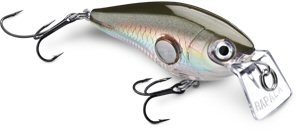
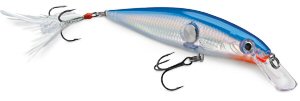
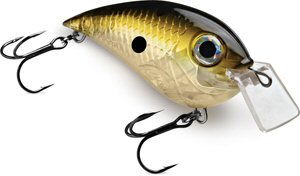 Rapala Crankin
Rap- Clackin Rap-Clackin Minnow
Rapala Crankin
Rap- Clackin Rap-Clackin Minnow The SR05
(smaller bait below) is a non rattling balsa wood constructed bait that
has a "Classic Wounded Minnow Rapala Wobble". As you
can see it has a long clear bill that is angled
slightly downward. The bill is approx 1 inch long
and 1/2 wide at it's widest point with it's line tie
not hardly in the middle of the bill. The SR05 in 2
inches in body length, weighs 3/16th of a ounce, has
2 #8 VMC treble hooks
The SR05
(smaller bait below) is a non rattling balsa wood constructed bait that
has a "Classic Wounded Minnow Rapala Wobble". As you
can see it has a long clear bill that is angled
slightly downward. The bill is approx 1 inch long
and 1/2 wide at it's widest point with it's line tie
not hardly in the middle of the bill. The SR05 in 2
inches in body length, weighs 3/16th of a ounce, has
2 #8 VMC treble hooks
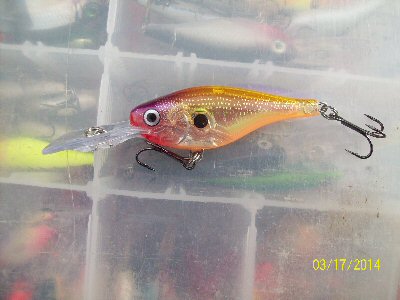 will actually
adapt to what ever your current light conditions
are, above or below water. Chances are you will
catch more bass in the water! This can be so
important when you are experiencing changing weather
conditions in the same day. The #5 Glass Rap is 2
inches in body length, (beefier in body than the SR05
see picture below)
5/16th of an ounce (2/16th more than the SR05)
in weight has 2 #6 VMC treble hooks and will run 7'
to 11' deep on a long cast and 10lb test line.
The long clear bill isn't angled down as much as the
SR05 and is longer being 1 1/8th inch in
length and wider than the SR05 being 11/16th in
width. Because of the body and bill design the GSR05
has a little more of a "thump" type wobble that you
can definitely feel when cranking this bait. The
angle and construction of the bill helps this bait
achieve rated depths. Once again I will throw this
bait on either 6lb or 8lb test Sufix mono
will actually
adapt to what ever your current light conditions
are, above or below water. Chances are you will
catch more bass in the water! This can be so
important when you are experiencing changing weather
conditions in the same day. The #5 Glass Rap is 2
inches in body length, (beefier in body than the SR05
see picture below)
5/16th of an ounce (2/16th more than the SR05)
in weight has 2 #6 VMC treble hooks and will run 7'
to 11' deep on a long cast and 10lb test line.
The long clear bill isn't angled down as much as the
SR05 and is longer being 1 1/8th inch in
length and wider than the SR05 being 11/16th in
width. Because of the body and bill design the GSR05
has a little more of a "thump" type wobble that you
can definitely feel when cranking this bait. The
angle and construction of the bill helps this bait
achieve rated depths. Once again I will throw this
bait on either 6lb or 8lb test Sufix mono
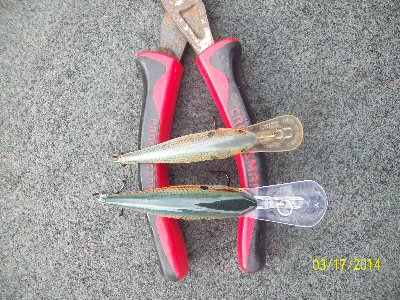 and reach
even deeper when paralleling the bank. This bait is
designed to "suspend" rather than float up when you
stop your retrieve. Why is that important? There are
times when I really believe that you can't reel a crankbait back to the boat fast enough when the bass
are very aggressive and they are determined to blast
your bait. But then there are times when they aren't
nearly as aggressive but are still hungry and when
you crank this bait down for several cranks then
"STOP" and start again they will almost jerk the rod
out of your hands. I guess they have been chasing
the bait and when you stop they get a good look at
it and when start your retrieve again they think
it's getting away. Also I like to stop this
bait when I have ricocheted off some type of
structure. Many times I have been hung up, pooped
the bait free, and as it suspends and then I began to crank
"Walla" there they are. Once again this is a
must have in your tackle selection because it is so
versatile. The GSR05 is a great all species trolling
bait as well. The GSR05 is
hand tuned and tank tested before in leaves the
plant and will run straight and true every time
right out of the box. Rapala is offering these in 3
different sizes and 9 different colors for the 2014
season.
and reach
even deeper when paralleling the bank. This bait is
designed to "suspend" rather than float up when you
stop your retrieve. Why is that important? There are
times when I really believe that you can't reel a crankbait back to the boat fast enough when the bass
are very aggressive and they are determined to blast
your bait. But then there are times when they aren't
nearly as aggressive but are still hungry and when
you crank this bait down for several cranks then
"STOP" and start again they will almost jerk the rod
out of your hands. I guess they have been chasing
the bait and when you stop they get a good look at
it and when start your retrieve again they think
it's getting away. Also I like to stop this
bait when I have ricocheted off some type of
structure. Many times I have been hung up, pooped
the bait free, and as it suspends and then I began to crank
"Walla" there they are. Once again this is a
must have in your tackle selection because it is so
versatile. The GSR05 is a great all species trolling
bait as well. The GSR05 is
hand tuned and tank tested before in leaves the
plant and will run straight and true every time
right out of the box. Rapala is offering these in 3
different sizes and 9 different colors for the 2014
season.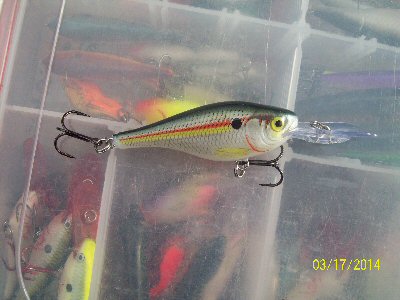 you get these in your hands, the first thing
you will see is the deeper tones and varied paint
schemes on the RS bait vs. the Glass bait and the
same will hold true if you match up exact colors
down the line. If you pay attention to Live Craws on
the lakes you fish you will see that they take on
different colors at different times of the year
based on multiple variables. The bait fish in
our lakes will pick up different hews through the
year as well based on water clarity, temperatures
etc. So what? Call me what you will "Old Fashioned"
"Picky" "Fussy" and I most likely qualify in each of
these descriptions. But I absolutely I believe that
there are times when different paint "tones" make a
subtle but huge difference. And then there are times I can't
explain why, other than it becomes a confidence
thing and you get in a zone of your own and it help
your over all performance when your on the water.
What ever the reason these are a absolute must for
me as well. Rapala
you get these in your hands, the first thing
you will see is the deeper tones and varied paint
schemes on the RS bait vs. the Glass bait and the
same will hold true if you match up exact colors
down the line. If you pay attention to Live Craws on
the lakes you fish you will see that they take on
different colors at different times of the year
based on multiple variables. The bait fish in
our lakes will pick up different hews through the
year as well based on water clarity, temperatures
etc. So what? Call me what you will "Old Fashioned"
"Picky" "Fussy" and I most likely qualify in each of
these descriptions. But I absolutely I believe that
there are times when different paint "tones" make a
subtle but huge difference. And then there are times I can't
explain why, other than it becomes a confidence
thing and you get in a zone of your own and it help
your over all performance when your on the water.
What ever the reason these are a absolute must for
me as well. Rapala 

 The
first thing that caught my attention was that the Boat
The
first thing that caught my attention was that the Boat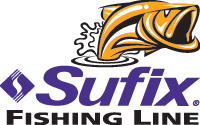








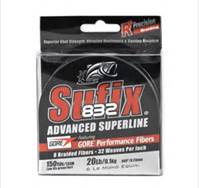 Sufix
832 Advanced Superline™ is the strongest, most durable small
diameter braid on the market. R8 Precision Braiding and fiber technology
provides superior strength,
roundness and line consistency. Constructed of 8 fibers (7 Dyneema® plus 1
GORE® Performance Fiber) and 32 weaves per inch. GORE® Performance Fibers
improve abrasion resistance,
increase casting distance & accuracy and reduce line vibration. Dyneema®
fibers provide high strength & sensitivity, hydrophobic water-repellent
protection and small diameter. 832 also won the prestigious "Best Line Award
for 2010 at the I Cast show.
Sufix
832 Advanced Superline™ is the strongest, most durable small
diameter braid on the market. R8 Precision Braiding and fiber technology
provides superior strength,
roundness and line consistency. Constructed of 8 fibers (7 Dyneema® plus 1
GORE® Performance Fiber) and 32 weaves per inch. GORE® Performance Fibers
improve abrasion resistance,
increase casting distance & accuracy and reduce line vibration. Dyneema®
fibers provide high strength & sensitivity, hydrophobic water-repellent
protection and small diameter. 832 also won the prestigious "Best Line Award
for 2010 at the I Cast show.


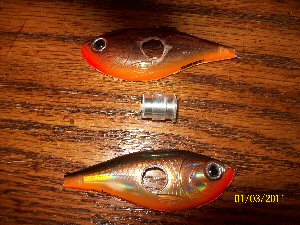 ackin
Rap, Clackin Minnow and the Clackin Crank. Although each of these baits are
very different in shape and size from one another there are several
important features they have in common that we need to explore before
looking at each bait individually. The first would be the Rapala Signature
Clackin Rattle Chamber. I disassembled a Clackin Rap (left) to show you the
Rattle Chamber that is inside the Clackin Series Baits. The round Rattle
Chamber has external metal disc's located at each end and a steel ball
inside the chamber. This is a very important feature because the chamber
allows the steel ball to move freely without getting hung up inside the
bait. Have you ever used a rattle bait and had to shake it by hand to free
the rattle inside? You won't have that trouble with these baits! No matter
how fast or slow these baits are worked the steel ball moves freely and
emits a distinctive Clackin sound that fish can very easily zero in on.
Although I fish primarily for Smallmouth and Largemouth the Clackin Series
Baits are designed for multi species including Hybrid, Stripers, Walleye,
Pike, Musky, Trout, Salmon and various pan fish.
ackin
Rap, Clackin Minnow and the Clackin Crank. Although each of these baits are
very different in shape and size from one another there are several
important features they have in common that we need to explore before
looking at each bait individually. The first would be the Rapala Signature
Clackin Rattle Chamber. I disassembled a Clackin Rap (left) to show you the
Rattle Chamber that is inside the Clackin Series Baits. The round Rattle
Chamber has external metal disc's located at each end and a steel ball
inside the chamber. This is a very important feature because the chamber
allows the steel ball to move freely without getting hung up inside the
bait. Have you ever used a rattle bait and had to shake it by hand to free
the rattle inside? You won't have that trouble with these baits! No matter
how fast or slow these baits are worked the steel ball moves freely and
emits a distinctive Clackin sound that fish can very easily zero in on.
Although I fish primarily for Smallmouth and Largemouth the Clackin Series
Baits are designed for multi species including Hybrid, Stripers, Walleye,
Pike, Musky, Trout, Salmon and various pan fish.







 consistently hovered in the mid to upper 90's and this week we will break
the 100 degree mark several days. The suns beating down, we have mile high
sky's and once again it's just plain old HOT! When I take my dogs
outside to do their business where do you think I stand? If you
guessed under a shade tree you would be absolutely correct! It may still be
hot "But" it is several degrees "Cooler" than just standing
out in the direct sunlight. The same principle applies to docks. Look
at the picture here to the right. This picture was taken on a bright sunny
day last month. Look at the shaded areas under the dock. To a bass it's like
walking his favorite shad out in the yard letting him swim around while he
gets under a shade tree. It may still be hot but the water temperature under
the dock can range as much as 8-10 degrees cooler (sometimes more) depending
on the density and square footage of the dock. Some of the docks I
fish on my favorite lake are 600 square feet and larger. Some are one story
tall and other two stories tall. The larger square footage of the dock
the greater the shade.
consistently hovered in the mid to upper 90's and this week we will break
the 100 degree mark several days. The suns beating down, we have mile high
sky's and once again it's just plain old HOT! When I take my dogs
outside to do their business where do you think I stand? If you
guessed under a shade tree you would be absolutely correct! It may still be
hot "But" it is several degrees "Cooler" than just standing
out in the direct sunlight. The same principle applies to docks. Look
at the picture here to the right. This picture was taken on a bright sunny
day last month. Look at the shaded areas under the dock. To a bass it's like
walking his favorite shad out in the yard letting him swim around while he
gets under a shade tree. It may still be hot but the water temperature under
the dock can range as much as 8-10 degrees cooler (sometimes more) depending
on the density and square footage of the dock. Some of the docks I
fish on my favorite lake are 600 square feet and larger. Some are one story
tall and other two stories tall. The larger square footage of the dock
the greater the shade. e
to the left is a side view of this dock. The key areas to
e
to the left is a side view of this dock. The key areas to
 concentrate
on are the right and left hand corners of the dock and the shaded open areas
between the floatation blocks. If you will notice that the height of the
dock roof and the height of the boat is casting a shaded area toward you.
This will be the angle that provides the most shade. If the bass are active
it is not unusual for them to chase the bait out several feet into this
shaded area. You will want to "skip" your bait into these open areas
between the floatation as far back under the dock as possible. You corner
cast should be several feet past the corners to allow you to work the bait
correctly. The picture to the right is a portion of a different dock. The
key areas would be the entire length of the right side of the dock, the
right hand corner and all of the water under the boat lift including the
left and right corners of the slip opening. Once again it is very important
to skip the bait as far as possible under the boat and the make your right
side cast as close as possible to the dock.
concentrate
on are the right and left hand corners of the dock and the shaded open areas
between the floatation blocks. If you will notice that the height of the
dock roof and the height of the boat is casting a shaded area toward you.
This will be the angle that provides the most shade. If the bass are active
it is not unusual for them to chase the bait out several feet into this
shaded area. You will want to "skip" your bait into these open areas
between the floatation as far back under the dock as possible. You corner
cast should be several feet past the corners to allow you to work the bait
correctly. The picture to the right is a portion of a different dock. The
key areas would be the entire length of the right side of the dock, the
right hand corner and all of the water under the boat lift including the
left and right corners of the slip opening. Once again it is very important
to skip the bait as far as possible under the boat and the make your right
side cast as close as possible to the dock.  e
left is the back left hand corner of this dock which is
e
left is the back left hand corner of this dock which is nearest the bank. They key areas are the open portion between the
floatation (hidden behind the 2007 date) the back corner, the length of the
back side and the entire area between the bank and the dock. If you
will notice in the picture to the right that this lake is very low this
summer due to the drought that we are experiencing. All the wood decking you
see would normally be in the water at this time of the year. This is a
"MUST FISH" area when the water is up. The best way that I have
found is to position by boat against the cable that is running from the
corner of the dock to the bank and actually fish over the cable pitching and
skipping my lures into and around as much of the wood as possible. I
will work one side of the structure at a time. When I reach the other side I
will fish the other side. Another thing to notice in these pictures is the
walkway from the dock to the shore. This will also provide shade to one
degree or the other and that shade will increase the closer you get to the
dock. I have caught and lost some "big" fish in this type of areas.
nearest the bank. They key areas are the open portion between the
floatation (hidden behind the 2007 date) the back corner, the length of the
back side and the entire area between the bank and the dock. If you
will notice in the picture to the right that this lake is very low this
summer due to the drought that we are experiencing. All the wood decking you
see would normally be in the water at this time of the year. This is a
"MUST FISH" area when the water is up. The best way that I have
found is to position by boat against the cable that is running from the
corner of the dock to the bank and actually fish over the cable pitching and
skipping my lures into and around as much of the wood as possible. I
will work one side of the structure at a time. When I reach the other side I
will fish the other side. Another thing to notice in these pictures is the
walkway from the dock to the shore. This will also provide shade to one
degree or the other and that shade will increase the closer you get to the
dock. I have caught and lost some "big" fish in this type of areas.  ft
is a different dock looking at it from from the opposite side
ft
is a different dock looking at it from from the opposite side from the ones above. The key areas remain the same. Opening floatation
areas, back corner, entire length of back side and the open area between the
dock and the shore. The picture on the right of another entire side view
which affords us some additional opportunities. The key area here would be
the right and left hand corners of the dock, the open areas between the
flotation, the white PVC hose pipe hanging down and the back of the pontoon
boat parked in front of the dock. Once again it is important to get you bait
as far under the dock as possible.
from the ones above. The key areas remain the same. Opening floatation
areas, back corner, entire length of back side and the open area between the
dock and the shore. The picture on the right of another entire side view
which affords us some additional opportunities. The key area here would be
the right and left hand corners of the dock, the open areas between the
flotation, the white PVC hose pipe hanging down and the back of the pontoon
boat parked in front of the dock. Once again it is important to get you bait
as far under the dock as possible.  true
to the left is a close up of the one above right. You can see the
true
to the left is a close up of the one above right. You can see the additional shade the exists under the pontoon boat. The picture on the right
gives us some different opportunities. Not only do we have the opening
between the dock floatation and the area between the dock and bank but the
big float tube and slide as well. Have you noticed something different about
this dock? Yes? No? Take a closer look-the dock isn't covered. It has been
my experience that this type of dock will produce less during this time of
the year than a covered dock, but big shaded areas like the one under the
tube should be checked out. Just please don't stick the tube...remember our
dock owner conversation?
additional shade the exists under the pontoon boat. The picture on the right
gives us some different opportunities. Not only do we have the opening
between the dock floatation and the area between the dock and bank but the
big float tube and slide as well. Have you noticed something different about
this dock? Yes? No? Take a closer look-the dock isn't covered. It has been
my experience that this type of dock will produce less during this time of
the year than a covered dock, but big shaded areas like the one under the
tube should be checked out. Just please don't stick the tube...remember our
dock owner conversation?  s
are of the same covered dock and gives us even
s
are of the same covered dock and gives us even more possibilities. This covered dock has jet ski platforms attached in two
different areas of the dock. So we have the corner of the dock, the entire
length of the front of the dock, the open flotation area, the side and
corners of the jet ski platform and the crack between them. Don't ever
discount the crack between the platform. I have caught a lot of good fish
that was suspended directly under them. We also have the back side of the
dock which is not visible to us in this picture.
more possibilities. This covered dock has jet ski platforms attached in two
different areas of the dock. So we have the corner of the dock, the entire
length of the front of the dock, the open flotation area, the side and
corners of the jet ski platform and the crack between them. Don't ever
discount the crack between the platform. I have caught a lot of good fish
that was suspended directly under them. We also have the back side of the
dock which is not visible to us in this picture.  is a 5 inch Prowler Soft S
is a 5 inch Prowler Soft S had
had

 ut's
to have "Product Failure" due to manufacturing error. Where am I going with
this? I have been a avid user of Pline for the past several years. On a
early spring trip with my youngest son Daniel to Louisiana a rep gave me
some line made by another big name manufacturer ands asked me just to try
it. To make a long story short after breaking off 3 "GOOOD" fish in the
cypress trees I respooled immediately back to what I should have had on in
the first place Pline CX. Problem solved! Is Pline infallible? NO, but I
will tell you this, as long as I watch what I'm doing and check my line as I
should I have almost "ZERO" problems with Pline. I use it in different pound
test for every technique that I use. I like the 12lb test CX Florescent for
fishing docks because it is invisible under the water but highly visible
above so you can watch your line for those very subtle hits that happens
many times fishing docks. It comes off the reel very smoothly and has a very
low memory rating but yet is very strong. Just good stuff.
ut's
to have "Product Failure" due to manufacturing error. Where am I going with
this? I have been a avid user of Pline for the past several years. On a
early spring trip with my youngest son Daniel to Louisiana a rep gave me
some line made by another big name manufacturer ands asked me just to try
it. To make a long story short after breaking off 3 "GOOOD" fish in the
cypress trees I respooled immediately back to what I should have had on in
the first place Pline CX. Problem solved! Is Pline infallible? NO, but I
will tell you this, as long as I watch what I'm doing and check my line as I
should I have almost "ZERO" problems with Pline. I use it in different pound
test for every technique that I use. I like the 12lb test CX Florescent for
fishing docks because it is invisible under the water but highly visible
above so you can watch your line for those very subtle hits that happens
many times fishing docks. It comes off the reel very smoothly and has a very
low memory rating but yet is very strong. Just good stuff.
 Lets talk about hooks for a
minute. There is an old saying that go's the chain is only as strong
as the weakest link. Same is true with the fishing equipment we use. I guess
I have bought about every brand hook manufactured. Some have been good some
haven't. The biggest problem that I have isn't the strength of a hook as
much as having a razor sharp point that will stay that way. I started using
Mustad Ultra Point hooks about 8 months ago and I can tell you that I'm
impressed/ These hooks are needle sharp. Mustad uses a new technology that
is called "Opti-Angle" that creates a true needle point that is stronger and
"Much More" durable than any other hooks that I have used. Under
normal conditions I use a #5 Mustad Wide Gap Ultra Lock Hook fishing the
Soft Shad. I also use a #4 and a #2 for smaller baits. Now there are times
while fishing docks I want my baits to fall a little faster "But" I don't
want to make them nose dive by adding a sinker to the front. When this
happens I use the Mustad Ultra Point Power Lock Plus Hooks that you see on
the right side of the picture above. The round piece that you see on the
shank of the hook is a weight that slides up and down the hook but
will stay put where you want it. I use these in 2 different weights 1/8oz
and 1/16oz depending on how fast I want the bait to fall. If I move
the weight forward the bait fall head first. If I move the weight to the
back the bait falls tail first and if I place it in the middle the bait will
fall at more of a level angle. This allows me to effectively fish the
docks using the right size bait at the right of fall.
Lets talk about hooks for a
minute. There is an old saying that go's the chain is only as strong
as the weakest link. Same is true with the fishing equipment we use. I guess
I have bought about every brand hook manufactured. Some have been good some
haven't. The biggest problem that I have isn't the strength of a hook as
much as having a razor sharp point that will stay that way. I started using
Mustad Ultra Point hooks about 8 months ago and I can tell you that I'm
impressed/ These hooks are needle sharp. Mustad uses a new technology that
is called "Opti-Angle" that creates a true needle point that is stronger and
"Much More" durable than any other hooks that I have used. Under
normal conditions I use a #5 Mustad Wide Gap Ultra Lock Hook fishing the
Soft Shad. I also use a #4 and a #2 for smaller baits. Now there are times
while fishing docks I want my baits to fall a little faster "But" I don't
want to make them nose dive by adding a sinker to the front. When this
happens I use the Mustad Ultra Point Power Lock Plus Hooks that you see on
the right side of the picture above. The round piece that you see on the
shank of the hook is a weight that slides up and down the hook but
will stay put where you want it. I use these in 2 different weights 1/8oz
and 1/16oz depending on how fast I want the bait to fall. If I move
the weight forward the bait fall head first. If I move the weight to the
back the bait falls tail first and if I place it in the middle the bait will
fall at more of a level angle. This allows me to effectively fish the
docks using the right size bait at the right of fall.

 grass. This is where I select a bait that will touch the top of the weeds
and has the ability to pull through when I jerk or snap the rod forward.
Many times in grass when you are using a lipless crank bait like the Lure
Jensen Sugar Shad the bass will hammer the bait almost immediately when
it comes free from the weeds. Two other great crank baits for fishing weeds
and grass is the Rapala #5 Shallow Shad Rap and the Storm Sub Wart.
These baits run very shallow and produce for me year after year.
grass. This is where I select a bait that will touch the top of the weeds
and has the ability to pull through when I jerk or snap the rod forward.
Many times in grass when you are using a lipless crank bait like the Lure
Jensen Sugar Shad the bass will hammer the bait almost immediately when
it comes free from the weeds. Two other great crank baits for fishing weeds
and grass is the Rapala #5 Shallow Shad Rap and the Storm Sub Wart.
These baits run very shallow and produce for me year after year. When the water temperature
begins to hit the 55 degree range and the fish are in
Shallower Water I always
When the water temperature
begins to hit the 55 degree range and the fish are in
Shallower Water I always
 choose
a Prowler Pro Fat Grub. This bait is in 8400 series is a little larger and
bulkier at 4.5 inches in length. The tail gives off a great amount of
turbulence and these baits are absolutely deadly on shallow water bass.
I like fishing this size grub on a couple different weights of ball type jig
heads and on a couple different line weights depending on structure, wind
and how aggressive the fish are. Let me explain.
choose
a Prowler Pro Fat Grub. This bait is in 8400 series is a little larger and
bulkier at 4.5 inches in length. The tail gives off a great amount of
turbulence and these baits are absolutely deadly on shallow water bass.
I like fishing this size grub on a couple different weights of ball type jig
heads and on a couple different line weights depending on structure, wind
and how aggressive the fish are. Let me explain.  happen on your next cast.
If the fish fail to hit the grub on the fall work the grub back up the
channel edge keeping in contact with the structure using a semi-slack line
presentation. There are other times when it will be to your advantage to
position your boat out in deeper water and cast toward the shallow flat.
When this happens always work the grub quickly to the channel edge and then
begin to count the grub down. This same application works well when sitting
in deeper water off of points.
happen on your next cast.
If the fish fail to hit the grub on the fall work the grub back up the
channel edge keeping in contact with the structure using a semi-slack line
presentation. There are other times when it will be to your advantage to
position your boat out in deeper water and cast toward the shallow flat.
When this happens always work the grub quickly to the channel edge and then
begin to count the grub down. This same application works well when sitting
in deeper water off of points.  When it comes to colors
everyone has their own that they have confidence in. Let me add this,
If you don't have confidence in what you are throwing you might as well put
it back in the box! At this point all you will be doing is thrashing
the water. The following colors are my confidence colors for the lakes
and areas that I fish, they work for me over and over. Let's break this down
in a way that it might help you in making your next grub purchase.
When it comes to colors
everyone has their own that they have confidence in. Let me add this,
If you don't have confidence in what you are throwing you might as well put
it back in the box! At this point all you will be doing is thrashing
the water. The following colors are my confidence colors for the lakes
and areas that I fish, they work for me over and over. Let's break this down
in a way that it might help you in making your next grub purchase. It won’t be long before the
97 degrees will be replaced with much cooler air temperatures. Shorts and
short sleeve shirts will be replaced with Body Amour and Gore-Tex suits.
Iced down spring water will be replaced with a thermos of hot coffee. Sun
block will be replaced with hand warmers. A quick ride in the boat to cool
off will be replaced with a Coleman heater to help stay warm. Yes,
change is just around the corner.
It won’t be long before the
97 degrees will be replaced with much cooler air temperatures. Shorts and
short sleeve shirts will be replaced with Body Amour and Gore-Tex suits.
Iced down spring water will be replaced with a thermos of hot coffee. Sun
block will be replaced with hand warmers. A quick ride in the boat to cool
off will be replaced with a Coleman heater to help stay warm. Yes,
change is just around the corner. 
 Before
I go any further I need to address why I switch from Old Hickory to Tim’s
Ford during the winter
Before
I go any further I need to address why I switch from Old Hickory to Tim’s
Ford during the winter months. Old Hickory is a river lake that is known primarily for a
solid Largemouth Bass population. Old Hickory (22,500 acres) most certainly
has a Smallmouth population but acre for acre the density of Smallmouth vs.
Largemouth is less. On the other hand, Tim’s Ford is already famed
Dale Hollows closest middle Tennessee rival. Tim’s may never match Dale
Hollows reputation for quality but take it from this full time guide, Tim’s
Ford is a blue ribbon Smallmouth lake already. My personal best Tim’s
Smallmouth last winter was 6 pound 2 ounces, a trophy just about any where.
The pictures that are scattered through this article are just some of the
Tim’s Ford fish caught during the winter season. See what I mean? Also
in 2005 the TWRA established an 18 inch size limit on Tim’s Ford Smallmouth
which can only help to increase the quality every year. Mile for mile
lake structure on Tim’s is (at least for me) more conducive to Smallmouth.
There is an almost unlimited amount of deep water private boat docks, public
and private ramps, rock points, shallow sloping gravel rounds, ledges, mud
banks, long winding creeks and coves, islands, shallow water/deep water
access areas and quick drop off’s, major river channel points. Many of Tim’s
creeks are loaded with stumps and lay down timber protruding out into deep
water. Although Tim’s is only 10,500 acres it fishes much larger and has an
abundance of shad and crawfish for Smallmouth to feast on. Another factor
is, in the winter months you don’t have to depend as much on generation
schedules on Tim’s as you do Old Hickory. Let me also say that Tim’s
has a great Largemouth and Walleye population as well, which is always an
added bonus. Spotted bass also roam Tim’s clear waters but on the average
are smaller. If a fisherman is looking for a chance at a bragging size Spot,
Center Hill near Smithville Tennessee is the answer. There are so many
reasons why I fish Tim’s and one reason I don’t want to forget is “Tim’s is
easy on the eyes”. What a beautiful lake, it’s not hard to get caught up in
all the scenery around you. Plus it’s just plain fun to fish Tim’s!
Moving on!
months. Old Hickory is a river lake that is known primarily for a
solid Largemouth Bass population. Old Hickory (22,500 acres) most certainly
has a Smallmouth population but acre for acre the density of Smallmouth vs.
Largemouth is less. On the other hand, Tim’s Ford is already famed
Dale Hollows closest middle Tennessee rival. Tim’s may never match Dale
Hollows reputation for quality but take it from this full time guide, Tim’s
Ford is a blue ribbon Smallmouth lake already. My personal best Tim’s
Smallmouth last winter was 6 pound 2 ounces, a trophy just about any where.
The pictures that are scattered through this article are just some of the
Tim’s Ford fish caught during the winter season. See what I mean? Also
in 2005 the TWRA established an 18 inch size limit on Tim’s Ford Smallmouth
which can only help to increase the quality every year. Mile for mile
lake structure on Tim’s is (at least for me) more conducive to Smallmouth.
There is an almost unlimited amount of deep water private boat docks, public
and private ramps, rock points, shallow sloping gravel rounds, ledges, mud
banks, long winding creeks and coves, islands, shallow water/deep water
access areas and quick drop off’s, major river channel points. Many of Tim’s
creeks are loaded with stumps and lay down timber protruding out into deep
water. Although Tim’s is only 10,500 acres it fishes much larger and has an
abundance of shad and crawfish for Smallmouth to feast on. Another factor
is, in the winter months you don’t have to depend as much on generation
schedules on Tim’s as you do Old Hickory. Let me also say that Tim’s
has a great Largemouth and Walleye population as well, which is always an
added bonus. Spotted bass also roam Tim’s clear waters but on the average
are smaller. If a fisherman is looking for a chance at a bragging size Spot,
Center Hill near Smithville Tennessee is the answer. There are so many
reasons why I fish Tim’s and one reason I don’t want to forget is “Tim’s is
easy on the eyes”. What a beautiful lake, it’s not hard to get caught up in
all the scenery around you. Plus it’s just plain fun to fish Tim’s!
Moving on!  In
this section I’m going to try to answer some of the questions for the
beginner that I proposed above. Please keep in mind this is what works for
me on Tim’s Ford a deep moderately clear lake. Others may approach these
questions from a different angle. There’s always more than one way to skin a
cat, or in this case catch a Smallmouth!
In
this section I’m going to try to answer some of the questions for the
beginner that I proposed above. Please keep in mind this is what works for
me on Tim’s Ford a deep moderately clear lake. Others may approach these
questions from a different angle. There’s always more than one way to skin a
cat, or in this case catch a Smallmouth! water will affect different lakes in various ways. Such as, if a lake is
relatively shallow and the fish are in the backs of the creeks when the
water begins to drop let’s say 5 feet, most likely they will move to the
nearest secondary break or point. As the water continues to drop another 5
feet the fish will move on to the next available point or break and so on
until the water stabilizes. But, on a lake like Tim’s which is a deep
lake, the fish will move much less in distance and their move will be
more horizontal than vertical. Bass on Tim’s just have a lot more water to
work with. So let’s say that this Saturday you get on some Smallmouth on
Tim’s on gravel rounds ¼ of the way back in the creeks near 2 main river
channel points and the fish are holding in 15 feet of water. The Corp drops
the lake 5 feet by next Saturday. Where do you look for these fish that you
were on a week ago? Have the fish moved and you look for them on the
channel points 75 yards away or still 15 feet deep on the same gravel round?
I always start at the 15 foot gravel round, Why? As I said the fish on Tim’s
have a lot more water to work with. I’ve watched this over the past several
years. On a deep lake it will take more factors than just falling water to
push a Smallmouth into a radical move.
water will affect different lakes in various ways. Such as, if a lake is
relatively shallow and the fish are in the backs of the creeks when the
water begins to drop let’s say 5 feet, most likely they will move to the
nearest secondary break or point. As the water continues to drop another 5
feet the fish will move on to the next available point or break and so on
until the water stabilizes. But, on a lake like Tim’s which is a deep
lake, the fish will move much less in distance and their move will be
more horizontal than vertical. Bass on Tim’s just have a lot more water to
work with. So let’s say that this Saturday you get on some Smallmouth on
Tim’s on gravel rounds ¼ of the way back in the creeks near 2 main river
channel points and the fish are holding in 15 feet of water. The Corp drops
the lake 5 feet by next Saturday. Where do you look for these fish that you
were on a week ago? Have the fish moved and you look for them on the
channel points 75 yards away or still 15 feet deep on the same gravel round?
I always start at the 15 foot gravel round, Why? As I said the fish on Tim’s
have a lot more water to work with. I’ve watched this over the past several
years. On a deep lake it will take more factors than just falling water to
push a Smallmouth into a radical move. Comparatively
the percentage of decrease in water depth of 5 foot to total volume on Tim’s
is very small compared to the shallow lake. So always start on deep clear
lakes where you found the fish last time and “Then” work your way out.
Don’t panic as the water falls on Tim’s or other deep water lakes.
Historically it has been rare that Smallmouth head for 50 feet of water just
because of gradually falling water. Normally they are going to stay fairly
constant at the same depths. Other factors might make them move but not
gradual falling water.
Comparatively
the percentage of decrease in water depth of 5 foot to total volume on Tim’s
is very small compared to the shallow lake. So always start on deep clear
lakes where you found the fish last time and “Then” work your way out.
Don’t panic as the water falls on Tim’s or other deep water lakes.
Historically it has been rare that Smallmouth head for 50 feet of water just
because of gradually falling water. Normally they are going to stay fairly
constant at the same depths. Other factors might make them move but not
gradual falling water.  will
move further back into the creeks and coves. NOTE: This paragraph is for
those of you that might fish a lake with an over abundance of shad. As an
example let’s look at Old Hickory in past year. Shad last year and two years
ago was so thick you could almost walk across the water on them and not get
your feet wet. They were every where, all the time. River channels, coves,
docks, creeks and pockets, solid shad everywhere every day. If your lake is
like that it presents a little tougher situation and you have to rely more
on covering a lot of water and good use of your electronics than just the
presence of shad alone.
will
move further back into the creeks and coves. NOTE: This paragraph is for
those of you that might fish a lake with an over abundance of shad. As an
example let’s look at Old Hickory in past year. Shad last year and two years
ago was so thick you could almost walk across the water on them and not get
your feet wet. They were every where, all the time. River channels, coves,
docks, creeks and pockets, solid shad everywhere every day. If your lake is
like that it presents a little tougher situation and you have to rely more
on covering a lot of water and good use of your electronics than just the
presence of shad alone.  This
is probably an over simplification but the same principle applies to bass
and their behavior relating to declining water temperatures. If the
water temperature dropped from 85 degrees to 50 degrees overnight the bass
would be running for cover like me running for heavier clothes. They would
have lock jaw for how long? How Long? If your answer is until their bodies
have had time to adjust you would be very close to being right. I can
see the bass now, all huddled up under one big log, trying to get warm and
looking at one another, not moving a fin and saying I’m not going out
there!. But when the temperatures drops gradually from 85 to 50 the
bass adjust to it gradually as well. The falling temperatures begin to nudge
them into their fall /winter way of thinking and reacting. Then it’s up to
us to adjust gradually in the way we approach our fall and winter game
plans. Don’t get ahead or behind yourself study the deep lake your on
and be vigilant of everything that’s happening around you.
This
is probably an over simplification but the same principle applies to bass
and their behavior relating to declining water temperatures. If the
water temperature dropped from 85 degrees to 50 degrees overnight the bass
would be running for cover like me running for heavier clothes. They would
have lock jaw for how long? How Long? If your answer is until their bodies
have had time to adjust you would be very close to being right. I can
see the bass now, all huddled up under one big log, trying to get warm and
looking at one another, not moving a fin and saying I’m not going out
there!. But when the temperatures drops gradually from 85 to 50 the
bass adjust to it gradually as well. The falling temperatures begin to nudge
them into their fall /winter way of thinking and reacting. Then it’s up to
us to adjust gradually in the way we approach our fall and winter game
plans. Don’t get ahead or behind yourself study the deep lake your on
and be vigilant of everything that’s happening around you.  answer that this way. That’s what your drag on you reel is for. If you fish
light line with your drag winched down tight I think you will be in big time
trouble. But on the other hand if you are using the correct action rod
(which we address next) and a reel with good line that has the drag set
properly, and retying when you should, you will break off very few fish.
answer that this way. That’s what your drag on you reel is for. If you fish
light line with your drag winched down tight I think you will be in big time
trouble. But on the other hand if you are using the correct action rod
(which we address next) and a reel with good line that has the drag set
properly, and retying when you should, you will break off very few fish.  All
Pro AtlAntis Series AT76MLS 7’6” Medium Light Action: Lure weight on
this rod is 1/16 to1/2 ounce. Recommended line weight is 4-8 pound test.
When I didn’t think Roger and Billy could come up with something else as
fantastic as the APX they introduced the AtlAntis series rods. Roger
was approached by inshore saltwater guides to build a rod for redfish,
speckled trout, tarpon and snook. The All Pro team went to work and over the
course of many months of R&D these rods were developed. When the first proto
types arrived at the office I couldn’t wait to get my hands on one.
Immediately when I held one my mind raced to small crank baits, mini hair
jigs, finesse shaky head worms, whirly bee’s, small/light top water baits,
live bait and more. The 7’ 6” length enables you to get extra long casts
with extremely light baits. The same 100% American made construction but
built extra tough for salt water use but yet light as a feather. I
have used these rods since the Fall of 2005 and I can tell you from personal
experience that the construction and length of these rods will absolutely
wear a fish down at the boat. Light weight construction, unbelievable
sensitivity (let me say that again) unbelievable sensitivity and power when
you need it.
All
Pro AtlAntis Series AT76MLS 7’6” Medium Light Action: Lure weight on
this rod is 1/16 to1/2 ounce. Recommended line weight is 4-8 pound test.
When I didn’t think Roger and Billy could come up with something else as
fantastic as the APX they introduced the AtlAntis series rods. Roger
was approached by inshore saltwater guides to build a rod for redfish,
speckled trout, tarpon and snook. The All Pro team went to work and over the
course of many months of R&D these rods were developed. When the first proto
types arrived at the office I couldn’t wait to get my hands on one.
Immediately when I held one my mind raced to small crank baits, mini hair
jigs, finesse shaky head worms, whirly bee’s, small/light top water baits,
live bait and more. The 7’ 6” length enables you to get extra long casts
with extremely light baits. The same 100% American made construction but
built extra tough for salt water use but yet light as a feather. I
have used these rods since the Fall of 2005 and I can tell you from personal
experience that the construction and length of these rods will absolutely
wear a fish down at the boat. Light weight construction, unbelievable
sensitivity (let me say that again) unbelievable sensitivity and power when
you need it. What
adjustments do you make in presentation? Most people that are use
to fishing lakes that are more on the shallow side tend to sit out away from
the bank and cast in. This type of presentation works well in that
setting. But when you are fishing a lake where the banks drop of quickly,
you are much better off to parallel the banks. This is very easy to do
with no more than one or two people in the boat, almost impossible with
three.
What
adjustments do you make in presentation? Most people that are use
to fishing lakes that are more on the shallow side tend to sit out away from
the bank and cast in. This type of presentation works well in that
setting. But when you are fishing a lake where the banks drop of quickly,
you are much better off to parallel the banks. This is very easy to do
with no more than one or two people in the boat, almost impossible with
three.

 The 3 inch
and 5 inch Prowler Grubs have a very strong resemblance to a bait fish and
are
The 3 inch
and 5 inch Prowler Grubs have a very strong resemblance to a bait fish and
are especially like the Stradic reels that Shimano makes. All Stradic’s are made
with 5 ball bearings and have proven over the years to be the smoothest most
dependable reels I have ever owned. I use the Stradic 4000 which has a
5.7:1 gear ratio on my soft plastic jerk bait rods. I spool one with 10 pound
test P-Line and the other with 8/20 Berkley Fireline.
especially like the Stradic reels that Shimano makes. All Stradic’s are made
with 5 ball bearings and have proven over the years to be the smoothest most
dependable reels I have ever owned. I use the Stradic 4000 which has a
5.7:1 gear ratio on my soft plastic jerk bait rods. I spool one with 10 pound
test P-Line and the other with 8/20 Berkley Fireline.  The
reason for 2 different lines is this (1) Fireline: The Stradic
4000 will handle up to 12lb test mono line very easily-over that I believe the
performance of the reel drops of rapidly. There are times when I need more
line strength and sensitivity. When I’m fishing boat docks and heavier cover
many times I can’t see the bait. I need a line that is super sensitive and
has zero stretch, that’s the reason for the Fireline. I can spool up with 8 lb
diameter line but have 20 lb test strength. I have also found that a
Prowler Pro Soft Shad will fall much slower on Fireline, and there are times
that this is a big plus. (2) P-Line 10 lb mono: First of all let me say
that P-Line is limp but very tough and is one of the most abrasion proof mono
lines that I have ever used. I use the P-Line when fishing the Soft Shad
around bridge pilings-grass beds with little heavy cover and rip rap areas
where I can keep good eye contact with the bait. Where the braided line helps
the bait fall slower-the P-line let’s it fall faster and once again there are
times when this works much better for me.
The
reason for 2 different lines is this (1) Fireline: The Stradic
4000 will handle up to 12lb test mono line very easily-over that I believe the
performance of the reel drops of rapidly. There are times when I need more
line strength and sensitivity. When I’m fishing boat docks and heavier cover
many times I can’t see the bait. I need a line that is super sensitive and
has zero stretch, that’s the reason for the Fireline. I can spool up with 8 lb
diameter line but have 20 lb test strength. I have also found that a
Prowler Pro Soft Shad will fall much slower on Fireline, and there are times
that this is a big plus. (2) P-Line 10 lb mono: First of all let me say
that P-Line is limp but very tough and is one of the most abrasion proof mono
lines that I have ever used. I use the P-Line when fishing the Soft Shad
around bridge pilings-grass beds with little heavy cover and rip rap areas
where I can keep good eye contact with the bait. Where the braided line helps
the bait fall slower-the P-line let’s it fall faster and once again there are
times when this works much better for me. Owner Wide Gap hook. These hooks are super strong and you will never have to
worry about having one get straightened out by a big fish. For those of you
that have other big species of fish like Stripers in your lake these hooks
will solve your problem. Your line will break before these will bend.
Not only are they strong but they have a 3 sided cutting point that gives you
great hook ups. The reason for the 2 sizes is simple-the #4 weighs less than
the #5 and is what I use when I’m fishing the Soft Shad in a slower falling
presentation. The #5 on the other hand weighs more and I use this when
the fall is faster.
Owner Wide Gap hook. These hooks are super strong and you will never have to
worry about having one get straightened out by a big fish. For those of you
that have other big species of fish like Stripers in your lake these hooks
will solve your problem. Your line will break before these will bend.
Not only are they strong but they have a 3 sided cutting point that gives you
great hook ups. The reason for the 2 sizes is simple-the #4 weighs less than
the #5 and is what I use when I’m fishing the Soft Shad in a slower falling
presentation. The #5 on the other hand weighs more and I use this when
the fall is faster. there other
colors that might work just as well? YES!!!!!! I’m sure there
are-BUT-these sure work for me day in and day out!
there other
colors that might work just as well? YES!!!!!! I’m sure there
are-BUT-these sure work for me day in and day out! Open Pilings: most
of these types of pilings will have a shelf you cannot see that connects the
columns that support the bridge. If the bass are in this area most likely they
will be on or near this shelf. When fishing a Pro Soft Shad in current I try
to put my boat upstream from the pilings and cast downstream, by doing this
you will maintain better lure control. Many times you will find the current to
be stronger toward the river channel and less as you progress toward the bank.
Be sure to work all 4 sides of each piling and the shelf that connects them.
At times the hit on top will be fantastic-other times it may take letting the
bait “Dead Stick” around the pilings-always watch your line for the bass to
hit your bait on the fall. (2) Solid Pilings: Most of the time shorter
bridges that cross various creeks that feed the main lake will have this type
of pilling only. One attribute that a small bridge has that larger ones don’t
(because of its height) is that it provides more shade to the structure
directly below the bridge. Most of these will have some degree of current and
always seem to have baitfish in some quantities around them. When fishing this
type of bridge and pilings concentrate on all 4 corner of the bank under the
bridge-the corners on the piling and make repeated casts directly parallel
down the entire length of the piling. Work the Pro Soft Shad much the same as
we discussed above.
Open Pilings: most
of these types of pilings will have a shelf you cannot see that connects the
columns that support the bridge. If the bass are in this area most likely they
will be on or near this shelf. When fishing a Pro Soft Shad in current I try
to put my boat upstream from the pilings and cast downstream, by doing this
you will maintain better lure control. Many times you will find the current to
be stronger toward the river channel and less as you progress toward the bank.
Be sure to work all 4 sides of each piling and the shelf that connects them.
At times the hit on top will be fantastic-other times it may take letting the
bait “Dead Stick” around the pilings-always watch your line for the bass to
hit your bait on the fall. (2) Solid Pilings: Most of the time shorter
bridges that cross various creeks that feed the main lake will have this type
of pilling only. One attribute that a small bridge has that larger ones don’t
(because of its height) is that it provides more shade to the structure
directly below the bridge. Most of these will have some degree of current and
always seem to have baitfish in some quantities around them. When fishing this
type of bridge and pilings concentrate on all 4 corner of the bank under the
bridge-the corners on the piling and make repeated casts directly parallel
down the entire length of the piling. Work the Pro Soft Shad much the same as
we discussed above. can last all day long in these shallow areas. The most important factor is
finding out where the bass are holding within the grass. For instance I have
noticed if you have a strong wind blowing directly into the grass the fish
seem to be more on the deepest outside edges of the grass beds. If it is calm
they can be scattered anywhere from the bank in zero feet of water to the far
outside edges. Many grass beds will have an open area (no grass) from the bank
out several feet before the growth begins. These areas can hold large
quantities of fish, early and late in the day and on stormy overcast
conditions. When the bass are in this area I like to throw the Pro Soft Shad
all the way up on the bank or sea wall and start from there….be ready the
strike can happen very quickly.
can last all day long in these shallow areas. The most important factor is
finding out where the bass are holding within the grass. For instance I have
noticed if you have a strong wind blowing directly into the grass the fish
seem to be more on the deepest outside edges of the grass beds. If it is calm
they can be scattered anywhere from the bank in zero feet of water to the far
outside edges. Many grass beds will have an open area (no grass) from the bank
out several feet before the growth begins. These areas can hold large
quantities of fish, early and late in the day and on stormy overcast
conditions. When the bass are in this area I like to throw the Pro Soft Shad
all the way up on the bank or sea wall and start from there….be ready the
strike can happen very quickly. Although
these 2 structures look entirely different they do share some things in
common. Most of these will have some type of cable or strap that
attaches to the sides of the dock and then to the shore. Some will have a
“Boat Lift” system in the slip that has runners or straps that are used to
left the boat up out of the
Although
these 2 structures look entirely different they do share some things in
common. Most of these will have some type of cable or strap that
attaches to the sides of the dock and then to the shore. Some will have a
“Boat Lift” system in the slip that has runners or straps that are used to
left the boat up out of the water. Some will have smaller attached jet ski platforms that will be attached
to the side of the dock. Also many of these will have sunken brush piles that
the dock owner has placed there to attract fish to his dock. If you’re fishing
a new area that has docks watch for floodlights-fishing pole holders-rods and
chairs-all of these can help you locate brush around docks. Also remember that
most of these sunken piles will be within a short cast from the dock.
There are other similarities but they all add up to the same thing-potential
holding places for bass.
water. Some will have smaller attached jet ski platforms that will be attached
to the side of the dock. Also many of these will have sunken brush piles that
the dock owner has placed there to attract fish to his dock. If you’re fishing
a new area that has docks watch for floodlights-fishing pole holders-rods and
chairs-all of these can help you locate brush around docks. Also remember that
most of these sunken piles will be within a short cast from the dock.
There are other similarities but they all add up to the same thing-potential
holding places for bass. Rip
Rap Areas: Let me say right up-front “I like to Fish these areas! This is
one of my favorite types of structure to fish with a variety of baits
including a Pro Soft Shad. These areas will hold a variety of
baitfish-sunfish and crayfish all year long. There are times when bass-good
bass will hold so close to the rip rap you will wonder why you can’t see their
fins, but they won’t chase a bait. If you stay out away from the bank and
throw in you might catch one every now and then. When this happens your best
bet is to parallel the rocks so closely that you literally could step out of
the boat. Make good long casts and keep your bait within inches of the
shore line. Don’t get in a hurry-when you catch a fish stop your forward
movement and make repeated casts in the same area-chances are there will be
another fish there.
Rip
Rap Areas: Let me say right up-front “I like to Fish these areas! This is
one of my favorite types of structure to fish with a variety of baits
including a Pro Soft Shad. These areas will hold a variety of
baitfish-sunfish and crayfish all year long. There are times when bass-good
bass will hold so close to the rip rap you will wonder why you can’t see their
fins, but they won’t chase a bait. If you stay out away from the bank and
throw in you might catch one every now and then. When this happens your best
bet is to parallel the rocks so closely that you literally could step out of
the boat. Make good long casts and keep your bait within inches of the
shore line. Don’t get in a hurry-when you catch a fish stop your forward
movement and make repeated casts in the same area-chances are there will be
another fish there.  Texas
Style Rigging: This method is very easy. Hold the Soft
Shad in one hand with the slit in the belly facing you. Insert the point
of the hook into the blunt end of the bait, bring the point out about half way
from the tip of the bait and the beginning of the slit. Push the Soft Shad up
the hook and over the bend, when this is done rotate it 90 degrees until the
point of the hook is facing the belly slit. While holding the hook push the
bait forward slightly then insert the point of the hook into and through the
Soft Shad until the point is barely exposed. This method will keep you from
getting hung up in wood and grass. After a few casts and always after every
strike you will want to check you rigging out. There is nothing more
aggravating than being on fish in a small area and then getting hung up right
in the middle of it.
Texas
Style Rigging: This method is very easy. Hold the Soft
Shad in one hand with the slit in the belly facing you. Insert the point
of the hook into the blunt end of the bait, bring the point out about half way
from the tip of the bait and the beginning of the slit. Push the Soft Shad up
the hook and over the bend, when this is done rotate it 90 degrees until the
point of the hook is facing the belly slit. While holding the hook push the
bait forward slightly then insert the point of the hook into and through the
Soft Shad until the point is barely exposed. This method will keep you from
getting hung up in wood and grass. After a few casts and always after every
strike you will want to check you rigging out. There is nothing more
aggravating than being on fish in a small area and then getting hung up right
in the middle of it.
 Up
Side Down Exposed Texas Rigging: There maybe times when you can get
away with this
method. The Soft Shad is rigged the exact same way with the exception that the
bait is turned upside down and the hook is left exposed outside of the
bait. I fish a Pro Soft Shad at times along rip rap areas and bridge
pilings when there is an absence of logs and grass. By rigging this way the
action of the bait become more erratic.
Up
Side Down Exposed Texas Rigging: There maybe times when you can get
away with this
method. The Soft Shad is rigged the exact same way with the exception that the
bait is turned upside down and the hook is left exposed outside of the
bait. I fish a Pro Soft Shad at times along rip rap areas and bridge
pilings when there is an absence of logs and grass. By rigging this way the
action of the bait become more erratic.  several years ago with a client I had out. When I told him we were going to
fish a soft plastic jerk bait and asked him if he knew how to rig it. He
replied yes and I didn’t think any more about it. When we began fishing at our
first stop I watched him catch 5 largemouth in a row using this method. It
doesn’t take me long to catch on so I rigged mine the same way and began to
catch fish as well. There are times this method works well. My only word of
caution is, this method IS NOT WEEDLESS in any manner shape or form. It
needs to be used in selected situations.
several years ago with a client I had out. When I told him we were going to
fish a soft plastic jerk bait and asked him if he knew how to rig it. He
replied yes and I didn’t think any more about it. When we began fishing at our
first stop I watched him catch 5 largemouth in a row using this method. It
doesn’t take me long to catch on so I rigged mine the same way and began to
catch fish as well. There are times this method works well. My only word of
caution is, this method IS NOT WEEDLESS in any manner shape or form. It
needs to be used in selected situations. Let's start
with the deepest pattern fish and work our way on up. These would be
the bass that more than likely would be in the lower region on up to mid
lake during the late summer/early fall period. The water temperature that
these bass a
Let's start
with the deepest pattern fish and work our way on up. These would be
the bass that more than likely would be in the lower region on up to mid
lake during the late summer/early fall period. The water temperature that
these bass a
 Now let's assume
that we are in a full fledge Fall pattern. The water temperature has dropped
to that "magic number" for your lake and the bass have one thing on their
mind and that's lunch! The bass have moved into the major creeks that have
plenty of cover such as standing timber-fallen logs-brush along the shore
line-maybe some grass and plenty of bait fish. The best creeks will also
have flowing water and creek channels that will bend in close to the shore
line. On some larger lakes the major creeks will also have smaller streams
that feed them as well. The mouths of these feeder streams are always a
great place to look for feeding fish. Bass at this point of the year can be
found in varying depths of water but many active feeding fish will be
shallow. Shallow water conditions anytime of the year is tailor made for the
Luhr-Jensen Speed Trap. These baits are offered in three sizes 1/16 which is
approximately 2 inches long, 1/8 which is 2 1/2 inches long and the 1/4
which is 3 inches long. The Speed Trap is one of the best shallow crankbaits
that I have ever used in my near 50 years of bass fishing. These baits have
a thin wall construction that produces the action and vibration of wood
lures but retains the consistency of an injected mold body. I have two
rods set up for fishing the Speed Traps. The first is the APX 7 foot medium
rod we discussed above with 8lb test line. The other is the same rod filled
with 6lb test line. I throw the 3/4 Speed Trap on 8lb test when I want to
reach the 8 foot level and the 1/8 and 1/16 on 6lb test for 6 foot or less.
I love throwing these baits on light line in and around shallow structure
but I have also watched huge Smallmouth in some of our clear lakes come up
from deep water to nail these small baits. What a bait! The Speed Traps are
available in more that 40 colors that will meet all your shallow crankbait
needs.
Now let's assume
that we are in a full fledge Fall pattern. The water temperature has dropped
to that "magic number" for your lake and the bass have one thing on their
mind and that's lunch! The bass have moved into the major creeks that have
plenty of cover such as standing timber-fallen logs-brush along the shore
line-maybe some grass and plenty of bait fish. The best creeks will also
have flowing water and creek channels that will bend in close to the shore
line. On some larger lakes the major creeks will also have smaller streams
that feed them as well. The mouths of these feeder streams are always a
great place to look for feeding fish. Bass at this point of the year can be
found in varying depths of water but many active feeding fish will be
shallow. Shallow water conditions anytime of the year is tailor made for the
Luhr-Jensen Speed Trap. These baits are offered in three sizes 1/16 which is
approximately 2 inches long, 1/8 which is 2 1/2 inches long and the 1/4
which is 3 inches long. The Speed Trap is one of the best shallow crankbaits
that I have ever used in my near 50 years of bass fishing. These baits have
a thin wall construction that produces the action and vibration of wood
lures but retains the consistency of an injected mold body. I have two
rods set up for fishing the Speed Traps. The first is the APX 7 foot medium
rod we discussed above with 8lb test line. The other is the same rod filled
with 6lb test line. I throw the 3/4 Speed Trap on 8lb test when I want to
reach the 8 foot level and the 1/8 and 1/16 on 6lb test for 6 foot or less.
I love throwing these baits on light line in and around shallow structure
but I have also watched huge Smallmouth in some of our clear lakes come up
from deep water to nail these small baits. What a bait! The Speed Traps are
available in more that 40 colors that will meet all your shallow crankbait
needs.  First let me say
this. I'm not a doctor, a paramedic or any kind of medical specialist. The
symptoms and first aid advice that you read here in this article can be
checked out and confirmed by the American Red Cross. I'm not a doctor but
rather a full time fishing guide that encounters all types of weather
situations throughout the 12 months of the year. My clients and I fish in
everything from freezing temperatures to snow, sleet, rain and during this
time of the year "Extreme Heat"
First let me say
this. I'm not a doctor, a paramedic or any kind of medical specialist. The
symptoms and first aid advice that you read here in this article can be
checked out and confirmed by the American Red Cross. I'm not a doctor but
rather a full time fishing guide that encounters all types of weather
situations throughout the 12 months of the year. My clients and I fish in
everything from freezing temperatures to snow, sleet, rain and during this
time of the year "Extreme Heat" It's hard to tell
how many bass that the Tennessee Bass Guides Team have caught this year on
Old Hickory-Center Hill and Tim's Ford using this technique. Take a look at
the picture to the left.....when we are talking about throwing a little or
small worm this is the rig. Some time ago we heard about a company in
Alabama that was selling a jig head that was made with a 2/0 or 3/0 long
shank hook that would allow you to Texas rig a worm. We got a package and
found out that they work great. I decided that with a little help from a
good friend of mine we would just pour our own and as they say the rest is
history! If I told you how many bass and how many bragging bass we have
caught on this rig this year you might not believe me.
It's hard to tell
how many bass that the Tennessee Bass Guides Team have caught this year on
Old Hickory-Center Hill and Tim's Ford using this technique. Take a look at
the picture to the left.....when we are talking about throwing a little or
small worm this is the rig. Some time ago we heard about a company in
Alabama that was selling a jig head that was made with a 2/0 or 3/0 long
shank hook that would allow you to Texas rig a worm. We got a package and
found out that they work great. I decided that with a little help from a
good friend of mine we would just pour our own and as they say the rest is
history! If I told you how many bass and how many bragging bass we have
caught on this rig this year you might not believe me. 
 for us on all the lakes this year. The worm of choice has been the 4 inch
Zoom Dead Ringer soaked in a fantastic new product called JJ's Magic. JJ's
is heavy garlic scented liquid dip that is available in Chartreuse,
Methylate-Blue and clear. I first heard of JJ's Magic this past winter and
am I every glad I did. If your looking to get the maximum benefit from JJ's
Magic I suggest that you put your plastic worms-flukes etc in Tupperware
bowls and soak them completely with the CLEAR garlic oil. Once again I'm
telling you this stuff really works!!
for us on all the lakes this year. The worm of choice has been the 4 inch
Zoom Dead Ringer soaked in a fantastic new product called JJ's Magic. JJ's
is heavy garlic scented liquid dip that is available in Chartreuse,
Methylate-Blue and clear. I first heard of JJ's Magic this past winter and
am I every glad I did. If your looking to get the maximum benefit from JJ's
Magic I suggest that you put your plastic worms-flukes etc in Tupperware
bowls and soak them completely with the CLEAR garlic oil. Once again I'm
telling you this stuff really works!! l
everyone that these baits are like putting candy in front of a kid. Fished
around weeds-wood-rock -boat docks-bridge pilings and bluffs this is one
fish catching tool. The bass just can't help themselves, they have to have
it. I want to point out why I believe that the Case Sinking Salty Shad is
superior to other nationally known plastic jerk baits.
l
everyone that these baits are like putting candy in front of a kid. Fished
around weeds-wood-rock -boat docks-bridge pilings and bluffs this is one
fish catching tool. The bass just can't help themselves, they have to have
it. I want to point out why I believe that the Case Sinking Salty Shad is
superior to other nationally known plastic jerk baits.  Last but never
least nor very far from my heart is the the Luhr-Jensen Speed Traps and the
#5 Shallow Shad Rap. I fish these baits on the exact same rod/line
combination that we talked about above. It has been my experience over and
over that you will have many more strikes on these baits when you use 6 lb
test line. Much of that I believe is due to the small size and light weigh
of these baits.
Last but never
least nor very far from my heart is the the Luhr-Jensen Speed Traps and the
#5 Shallow Shad Rap. I fish these baits on the exact same rod/line
combination that we talked about above. It has been my experience over and
over that you will have many more strikes on these baits when you use 6 lb
test line. Much of that I believe is due to the small size and light weigh
of these baits.  One of the great
benefits that we bass fishermen have here in middle Tennessee is that we can
chase our prey all year long. Under normal conditions our lakes never freeze
over. Most of the time even with the winter draw down we have great boat ramps
that are always assessable. We have shallow water lakes and river type
lakes that have a constant current and flow. We have lakes that have hot water
discharge plants that keep several miles of water with spring like
temperatures all winter. We also have several clear deep lakes like
Center Hill located near Smithville Tennessee in middle Tennessee where the
water temperatures will get down into the 40's and offers fantastic "Deep"
water Smallmouth-Largemouth and Spotted Bass fishing. How "Deep" is "Deep"?
How about consistently catching bass straight down in 25 feet-35 feet-45 feet
or even 50 feet of water or more?
One of the great
benefits that we bass fishermen have here in middle Tennessee is that we can
chase our prey all year long. Under normal conditions our lakes never freeze
over. Most of the time even with the winter draw down we have great boat ramps
that are always assessable. We have shallow water lakes and river type
lakes that have a constant current and flow. We have lakes that have hot water
discharge plants that keep several miles of water with spring like
temperatures all winter. We also have several clear deep lakes like
Center Hill located near Smithville Tennessee in middle Tennessee where the
water temperatures will get down into the 40's and offers fantastic "Deep"
water Smallmouth-Largemouth and Spotted Bass fishing. How "Deep" is "Deep"?
How about consistently catching bass straight down in 25 feet-35 feet-45 feet
or even 50 feet of water or more? ay.
A Drop Shot is simply a finesse worm technique that is is rigged with a
plastic worm or small shad type bait fished on a #1 wide gap hook tied
approximately 18 to 24 inches ABOVE a 3/16th ounce weight attached to
the end of the line. The picture to the left is a little deceiving so let me
repeat this again. The worm is tied ABOVE THE WEIGHT.
ay.
A Drop Shot is simply a finesse worm technique that is is rigged with a
plastic worm or small shad type bait fished on a #1 wide gap hook tied
approximately 18 to 24 inches ABOVE a 3/16th ounce weight attached to
the end of the line. The picture to the left is a little deceiving so let me
repeat this again. The worm is tied ABOVE THE WEIGHT.  Choosing You
Bait: I guess the word "Finesse" defines where you start.
As with many innovative techniques it appears that western bass fishermen gave
drop shotting it's birth. It is critical much of the time that a "Small" bait
be used in their ultra clear lakes. So you can see how this technique
fits perfectly in lakes like Center Hill. Once again Billy's bait
selection is very simple, he stays with 3 and 4 inch worms and shad type
imitations. The Case Plastics Company of Clarksville Va. offers many great
plastic baits that the entire Tennessee Bass Guides Team uses for finesse
technique fishing. (see
Choosing You
Bait: I guess the word "Finesse" defines where you start.
As with many innovative techniques it appears that western bass fishermen gave
drop shotting it's birth. It is critical much of the time that a "Small" bait
be used in their ultra clear lakes. So you can see how this technique
fits perfectly in lakes like Center Hill. Once again Billy's bait
selection is very simple, he stays with 3 and 4 inch worms and shad type
imitations. The Case Plastics Company of Clarksville Va. offers many great
plastic baits that the entire Tennessee Bass Guides Team uses for finesse
technique fishing. (see  Take
a look at the picture to the left. What do you see? Much of the time
Take
a look at the picture to the left. What do you see? Much of the time on Center Hill you will find the bass suspended in and around pods of shad out
in "Open Water" When this situation occurs it is extremely important that you
rely on "GOOD" electronics. Billy's approach to finding shad is to probe
various coves and creeks starting with the deepest water and working his way
in by zigzagging back and forth across from bank to bank until a good pod of
bait fish was found. Some of the fish were found in 50 feet of water
some in 30 feet or less. At that point Billy would man his trolling motor and
look for suspended bass (This Is Important) on the out side edges of the pod.
Billy would then search out the larger fish and watch his electronics as the
drop shot fell into the strike zone. Billy would make the bait "Quiver" as he
gently twitched the rod tip. He explained that this presentation is much
different from using a spoon where you want to impart a more erratic motion.
If you have good electronics you can actually see the the bass move up or down
to attack your bait and immediately feel that "Tap" we talked about earlier.
Billy explained that another method of presenting these little baits is
called "Strolling". This method is used when you know which direction the bass
are pushing the shad and you simply drag the bait along as you move with the
trolling motor, letting the motion and boat movement impart all action.
on Center Hill you will find the bass suspended in and around pods of shad out
in "Open Water" When this situation occurs it is extremely important that you
rely on "GOOD" electronics. Billy's approach to finding shad is to probe
various coves and creeks starting with the deepest water and working his way
in by zigzagging back and forth across from bank to bank until a good pod of
bait fish was found. Some of the fish were found in 50 feet of water
some in 30 feet or less. At that point Billy would man his trolling motor and
look for suspended bass (This Is Important) on the out side edges of the pod.
Billy would then search out the larger fish and watch his electronics as the
drop shot fell into the strike zone. Billy would make the bait "Quiver" as he
gently twitched the rod tip. He explained that this presentation is much
different from using a spoon where you want to impart a more erratic motion.
If you have good electronics you can actually see the the bass move up or down
to attack your bait and immediately feel that "Tap" we talked about earlier.
Billy explained that another method of presenting these little baits is
called "Strolling". This method is used when you know which direction the bass
are pushing the shad and you simply drag the bait along as you move with the
trolling motor, letting the motion and boat movement impart all action.
 Will this
technique work? I guess the proof is in the picture to the left. A beautiful 4
pound plus largemouth that came out of 55 feet of water (Yes 55 feet)
suspended on the out side edge of a pod of shad.
Will this
technique work? I guess the proof is in the picture to the left. A beautiful 4
pound plus largemouth that came out of 55 feet of water (Yes 55 feet)
suspended on the out side edge of a pod of shad. do while the bait is
still in the package. Again why is this important? Back in the mid 70’s I
was burning the roads up between home and the famed Toledo Bend Reservoir on
the Louisiana-Texas border when I made friends with a great fisherman from
Monroe Louisiana. He introduced me to Louisiana lakes with names such as
“Black Bayou,” Lake Bruin,” “Lake Providence,” and more. All these
lakes are full of cypress tress and custom made for spinner baits. I watched
him “open” the hook up on his spinnerbaits explaining that this was
done to get better hook up’s. What he was saying was the absolute
truth. But the reason for having to do this was that the line tie was higher
than the hook point which meant when my friend set the hook he would
actually be jerking the hook downward and out of the bass mouth. This is why
it is so important….and believe me, it will make a difference at the lake.
The next time you are in a fishing tackle section just take a few minutes to
look at the various spinner baits and you will see what I’m talking about.
do while the bait is
still in the package. Again why is this important? Back in the mid 70’s I
was burning the roads up between home and the famed Toledo Bend Reservoir on
the Louisiana-Texas border when I made friends with a great fisherman from
Monroe Louisiana. He introduced me to Louisiana lakes with names such as
“Black Bayou,” Lake Bruin,” “Lake Providence,” and more. All these
lakes are full of cypress tress and custom made for spinner baits. I watched
him “open” the hook up on his spinnerbaits explaining that this was
done to get better hook up’s. What he was saying was the absolute
truth. But the reason for having to do this was that the line tie was higher
than the hook point which meant when my friend set the hook he would
actually be jerking the hook downward and out of the bass mouth. This is why
it is so important….and believe me, it will make a difference at the lake.
The next time you are in a fishing tackle section just take a few minutes to
look at the various spinner baits and you will see what I’m talking about. in the past have you bought a spinner bait and put it in you boat storage or
tackle box to use on your next trip? Trip day is here... you reach
down to get this new bait only to find that the skirt had melted together
and is unusable? Now not only do you have an additional expense replacing
the skirt-but more annoying is the sticky mess the skirt has made in your
tacklebox. I do believe however that there is a slight difference in
the way a 100% rubber skirt will perform in cold water verses a silicone
skirt. When that time rolls around and it is necessary, I change the shirts
out. But it is very rare that I leave a 100% rubber skirt in my boat during
hot weather. It may sound like a small thing,but it isn’t when you have to
clean up the mess.
in the past have you bought a spinner bait and put it in you boat storage or
tackle box to use on your next trip? Trip day is here... you reach
down to get this new bait only to find that the skirt had melted together
and is unusable? Now not only do you have an additional expense replacing
the skirt-but more annoying is the sticky mess the skirt has made in your
tacklebox. I do believe however that there is a slight difference in
the way a 100% rubber skirt will perform in cold water verses a silicone
skirt. When that time rolls around and it is necessary, I change the shirts
out. But it is very rare that I leave a 100% rubber skirt in my boat during
hot weather. It may sound like a small thing,but it isn’t when you have to
clean up the mess. mater what the
combination, the blades need to be made of high quality material where they
will hold up under heavy usage. The finish on the blades need to last and
not discolor or flake off after you have bang it into various structure a
few times. And each blade style needs to provide you with maximum vibration
and water displacement for their size. At the lake, blade performance
can be determined rather quickly. The durability test may take a little
longer. To help you understand the difference in blade types look at the
attached picture to the left. (1) This is a Colorado blade. This blade will
put off more vibration and is the blade that I turn to in heavily
stained to muddy water and at night in deep water. I also like to use it in
areas where I’m fishing more wood than grass. (2) This blade is called a
“Willow Leaf. “ For the water that I fish the most here in Tennessee it is
probably the best over all style. It is good in clear and stained water and
will put off a fair amount of flash based on it’s finish. I fish a lot of
weeds on Old Hickory and the willow leaf tends to come through them much
better that other styles. (3) This is a Indiana Blade. It is a mixture of
the willow leaf and Colorado blade/ It also will put off a “good
vibration” (little Beach Boys there) and a lot of flash based on the
blades finish. Size of blade is normally dependent upon how fast I intend
to retrieve the bait. The smaller the bade the faster the retrieve. The
larger the blade the slower the retrieve.
mater what the
combination, the blades need to be made of high quality material where they
will hold up under heavy usage. The finish on the blades need to last and
not discolor or flake off after you have bang it into various structure a
few times. And each blade style needs to provide you with maximum vibration
and water displacement for their size. At the lake, blade performance
can be determined rather quickly. The durability test may take a little
longer. To help you understand the difference in blade types look at the
attached picture to the left. (1) This is a Colorado blade. This blade will
put off more vibration and is the blade that I turn to in heavily
stained to muddy water and at night in deep water. I also like to use it in
areas where I’m fishing more wood than grass. (2) This blade is called a
“Willow Leaf. “ For the water that I fish the most here in Tennessee it is
probably the best over all style. It is good in clear and stained water and
will put off a fair amount of flash based on it’s finish. I fish a lot of
weeds on Old Hickory and the willow leaf tends to come through them much
better that other styles. (3) This is a Indiana Blade. It is a mixture of
the willow leaf and Colorado blade/ It also will put off a “good
vibration” (little Beach Boys there) and a lot of flash based on the
blades finish. Size of blade is normally dependent upon how fast I intend
to retrieve the bait. The smaller the bade the faster the retrieve. The
larger the blade the slower the retrieve.  APX610MHCA which is a
6 foot 10 inch medium heavy casting rod for my heavier baits. Both of
these rods have soft tips and the sensitivity is amazing. One real point of
difference that sets these APX rods apart from all other graphite rods no
matter the brand or cost is the “Graphite Rings” on the handle. (See picture
to the left) Other graphite rods are made where the graphite blank runs
through a cork handle. The cork inadvertently acts as a buffer or insulator
which diminishes some of the “Feel” or sensitivity. But the APX is designed
where the strike is transmitted from the tip of the rod through the blank
and into these graphite rings and then into the palm of your hand.
Absolutely maximizing sensitivity. No buffer-no insulator just “Direct
Feel”!!!
APX610MHCA which is a
6 foot 10 inch medium heavy casting rod for my heavier baits. Both of
these rods have soft tips and the sensitivity is amazing. One real point of
difference that sets these APX rods apart from all other graphite rods no
matter the brand or cost is the “Graphite Rings” on the handle. (See picture
to the left) Other graphite rods are made where the graphite blank runs
through a cork handle. The cork inadvertently acts as a buffer or insulator
which diminishes some of the “Feel” or sensitivity. But the APX is designed
where the strike is transmitted from the tip of the rod through the blank
and into these graphite rings and then into the palm of your hand.
Absolutely maximizing sensitivity. No buffer-no insulator just “Direct
Feel”!!!  timber
will remain stationary all the time. Some of it will move with the rise and
fall of the lake level. Some will be in the backs of coves and pockets. Some
are wedged in and around docks and piers. Some have come to rest right at or
near the main river channel with a lot of current while others are isolated
on expansive flats that have little current. But no matter where the
timber is located all of it under the right conditions is prospective cover
for largemouth bass. I would have to say that “Isolated” timber located
near or on a channel ledge has historically been the best producer of bass
for me. These areas normally will have deep water close by, current, bait
washing in and shade on some area of the timber. The more limbs on the
fallen tree the more shaded areas that will be present. I always make
repeated casts to the shaded portion of the timber trying to stay as
parallel as possible. Bass like shaded areas and truthfully they don’t have
to be large areas. Work the timber completely, pick it apart section by
section. Let your spinner bait helicopter (free-fall) down in and around
intersections of limbs where it is attached to the trunk. Hold on you might
just have a fight on your hands.
timber
will remain stationary all the time. Some of it will move with the rise and
fall of the lake level. Some will be in the backs of coves and pockets. Some
are wedged in and around docks and piers. Some have come to rest right at or
near the main river channel with a lot of current while others are isolated
on expansive flats that have little current. But no matter where the
timber is located all of it under the right conditions is prospective cover
for largemouth bass. I would have to say that “Isolated” timber located
near or on a channel ledge has historically been the best producer of bass
for me. These areas normally will have deep water close by, current, bait
washing in and shade on some area of the timber. The more limbs on the
fallen tree the more shaded areas that will be present. I always make
repeated casts to the shaded portion of the timber trying to stay as
parallel as possible. Bass like shaded areas and truthfully they don’t have
to be large areas. Work the timber completely, pick it apart section by
section. Let your spinner bait helicopter (free-fall) down in and around
intersections of limbs where it is attached to the trunk. Hold on you might
just have a fight on your hands. slowly down the
entire length of the log. Then I work the other side of the log. If the log
is running out into deep water I position my boat where I can cast my
spinnerbait well past the end of the log and retrieve it very slowly letting
the bait bump the log as I go by. On visible stumps I make my cast on
the shaded side beyond the stump. By casting past the stump you can work the
side and back of the stump at the same time. Plus it isn’t as likely that
you will spook a bass that might be there. Some stumps have very little root
system attached, while others might have an extensive system. Here’s a tip
beginning bass fishermen. Always wear a good pair of polarized sun glasses.
They will help you greatly in visually determining what you are fishing.
Years ago I fished a lake that had the “Text Book” example of stumps
situated directly on a creek channel bank. Many of the stumps were 4 to 5
feet across and all had extensive roots still attached. The base of the
stumps was located in 3 feet of water with some of their roots actually
hanging over the channel drop into 15 feet of water. I spent many exciting
hours working this stump row over and over again. The water was just clear
enough that you could see the bass come out of the roots and smash the
spinner bait as it bumped and banged along. Early, late, and on cloudy
days the bass would be located up in the shallow water but at other times
with clearer brighter sky’s they would be staged on roots right at the
break. Areas like these will produce fish over and over again through out
the year.
slowly down the
entire length of the log. Then I work the other side of the log. If the log
is running out into deep water I position my boat where I can cast my
spinnerbait well past the end of the log and retrieve it very slowly letting
the bait bump the log as I go by. On visible stumps I make my cast on
the shaded side beyond the stump. By casting past the stump you can work the
side and back of the stump at the same time. Plus it isn’t as likely that
you will spook a bass that might be there. Some stumps have very little root
system attached, while others might have an extensive system. Here’s a tip
beginning bass fishermen. Always wear a good pair of polarized sun glasses.
They will help you greatly in visually determining what you are fishing.
Years ago I fished a lake that had the “Text Book” example of stumps
situated directly on a creek channel bank. Many of the stumps were 4 to 5
feet across and all had extensive roots still attached. The base of the
stumps was located in 3 feet of water with some of their roots actually
hanging over the channel drop into 15 feet of water. I spent many exciting
hours working this stump row over and over again. The water was just clear
enough that you could see the bass come out of the roots and smash the
spinner bait as it bumped and banged along. Early, late, and on cloudy
days the bass would be located up in the shallow water but at other times
with clearer brighter sky’s they would be staged on roots right at the
break. Areas like these will produce fish over and over again through out
the year. day as well as cloudy days this can be your key area to focus on. I make
long casts and work the spinner bait back to me always having visual contact
with the bait. There are some areas like this that will have patches of
standing grass within the opening. These are key areas as well. As the sun
comes up I concentrate on the outside “deeper” edges of the grass
weaving the spinnerbait through as much of the vegetation as possible.
I have also noticed that on windy days when it is blowing directly into the
weeds the bass seem to be staged more to the out side edges of the weed
line. When this is the situation I always start there no matter the time of
day or what amount of cloud cover I have. Lure speed varies you may have to
adjust several times before you find what the bass want.
day as well as cloudy days this can be your key area to focus on. I make
long casts and work the spinner bait back to me always having visual contact
with the bait. There are some areas like this that will have patches of
standing grass within the opening. These are key areas as well. As the sun
comes up I concentrate on the outside “deeper” edges of the grass
weaving the spinnerbait through as much of the vegetation as possible.
I have also noticed that on windy days when it is blowing directly into the
weeds the bass seem to be staged more to the out side edges of the weed
line. When this is the situation I always start there no matter the time of
day or what amount of cloud cover I have. Lure speed varies you may have to
adjust several times before you find what the bass want. can be big producers
in these areas. One of first mistakes that many fishermen make is staying
too far off the bluff wall with their boats. I have found to fish these
areas correctly, no matter what the water color is, you have to
fish parallel so close that you can reach out and touch the bluff with your
hands. By doing this you keep your bait in the strike zone all the way. When
the water color is clear you can burn the spinner bait back to you just
under the surface. Many times that I have had suspended fish come up from
deep water on these bluffs to bust a spinner bait. When the water color is
dingier I work the ledges of these bluffs by slow rolling the spinnerbait
trying to stay in contact with the rock and wood as much as possible.
I also always look for changes in the bluff wall such as indentations and
rock slides. Indentions are recessed areas in the face of the wall that will
give you two defined corners for bass to ambush from as well as the recessed
area that many times will hold timber or a series of stair step ledges.
Rock slides, on the other hand are almost always a signal that the
water around the side will be shallower. These areas hold bait fish and
crayfish continually. When you get to the end of the bluff you will come to
a “Point” much like the one in the upper right hand corner of the picture
above. We will discuss this next.
can be big producers
in these areas. One of first mistakes that many fishermen make is staying
too far off the bluff wall with their boats. I have found to fish these
areas correctly, no matter what the water color is, you have to
fish parallel so close that you can reach out and touch the bluff with your
hands. By doing this you keep your bait in the strike zone all the way. When
the water color is clear you can burn the spinner bait back to you just
under the surface. Many times that I have had suspended fish come up from
deep water on these bluffs to bust a spinner bait. When the water color is
dingier I work the ledges of these bluffs by slow rolling the spinnerbait
trying to stay in contact with the rock and wood as much as possible.
I also always look for changes in the bluff wall such as indentations and
rock slides. Indentions are recessed areas in the face of the wall that will
give you two defined corners for bass to ambush from as well as the recessed
area that many times will hold timber or a series of stair step ledges.
Rock slides, on the other hand are almost always a signal that the
water around the side will be shallower. These areas hold bait fish and
crayfish continually. When you get to the end of the bluff you will come to
a “Point” much like the one in the upper right hand corner of the picture
above. We will discuss this next. moving!
moving!